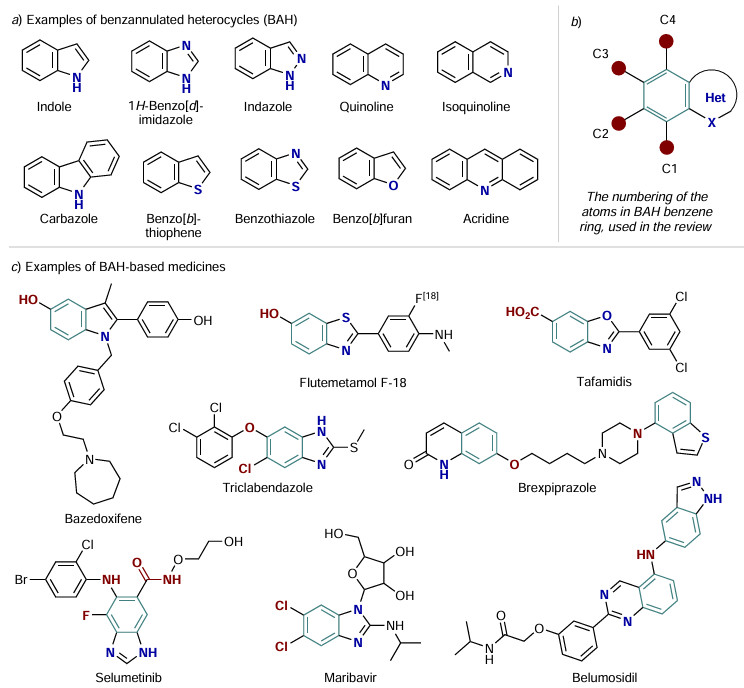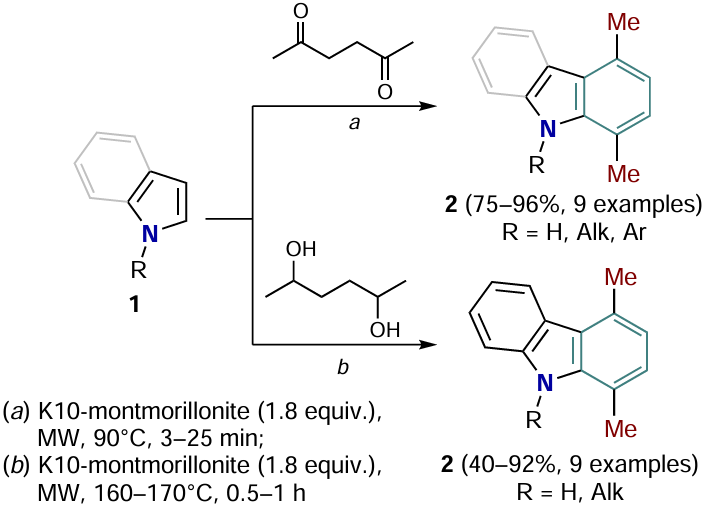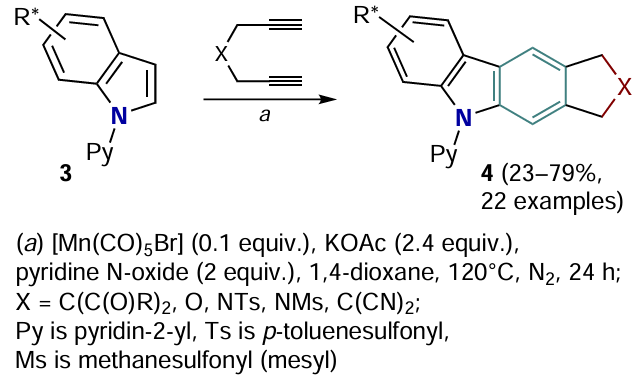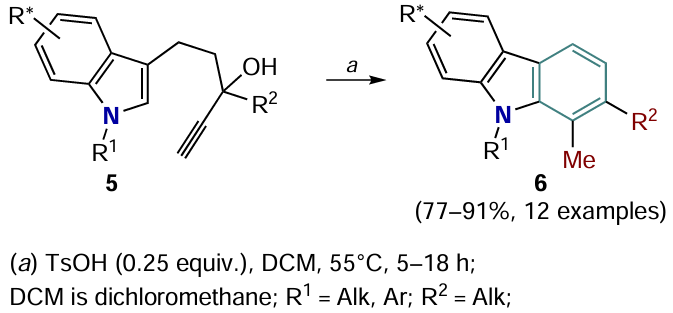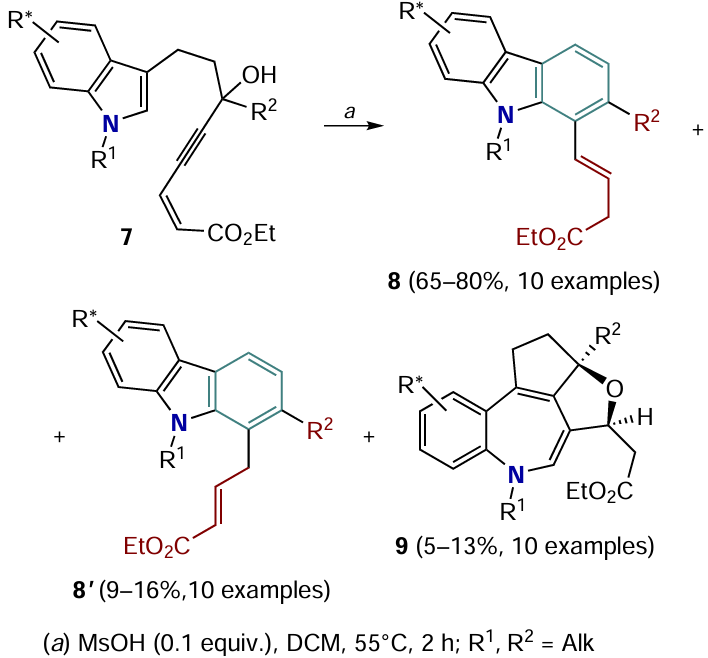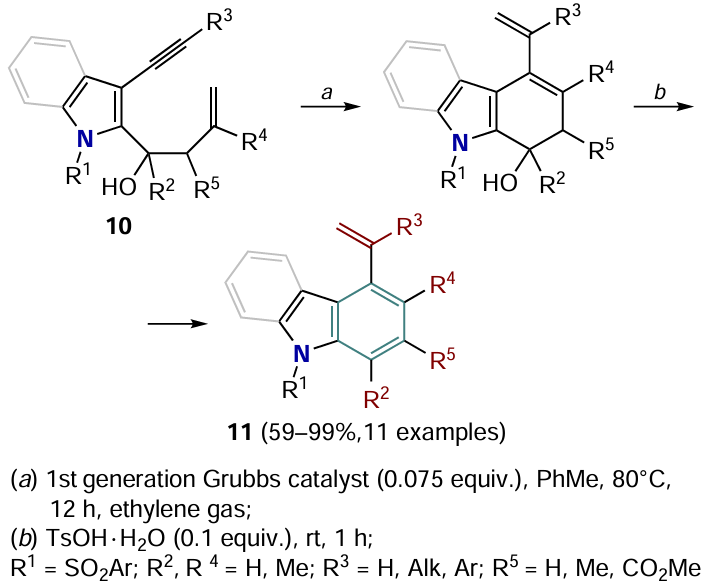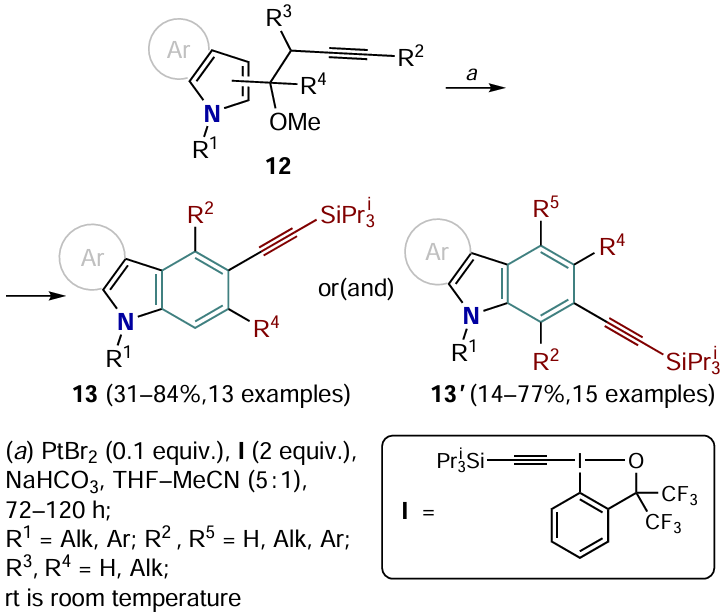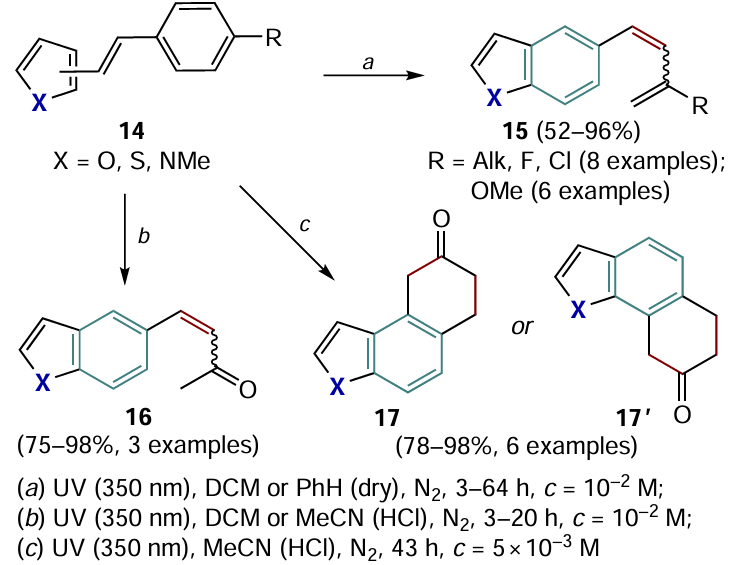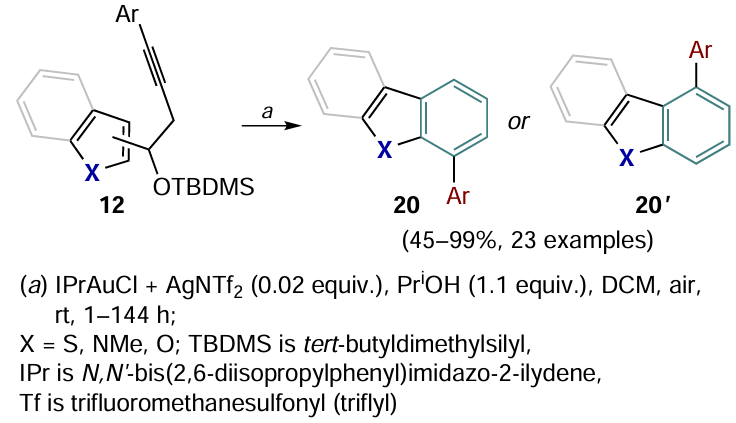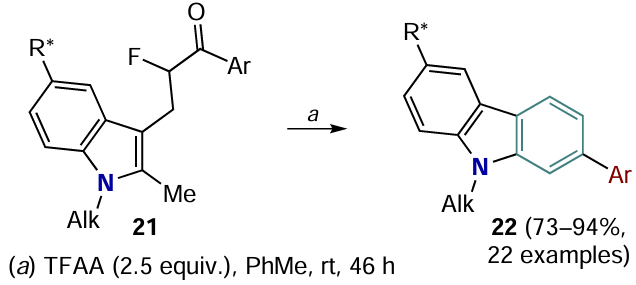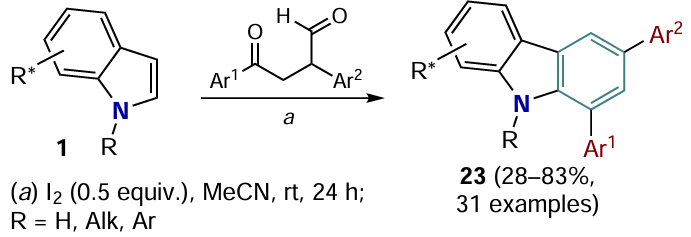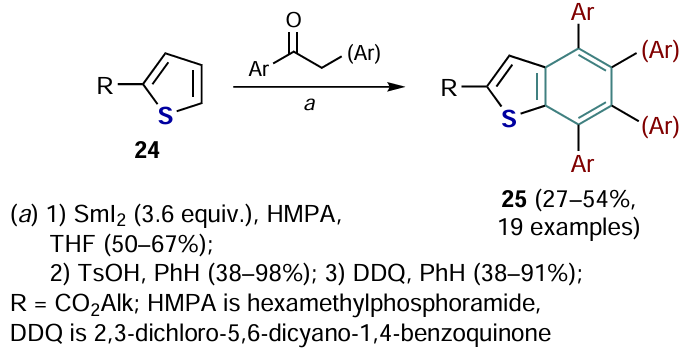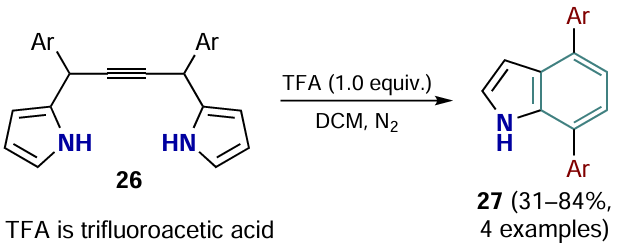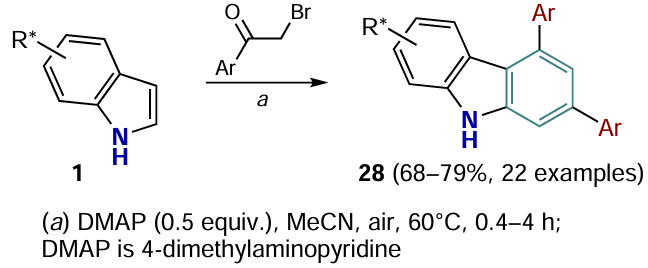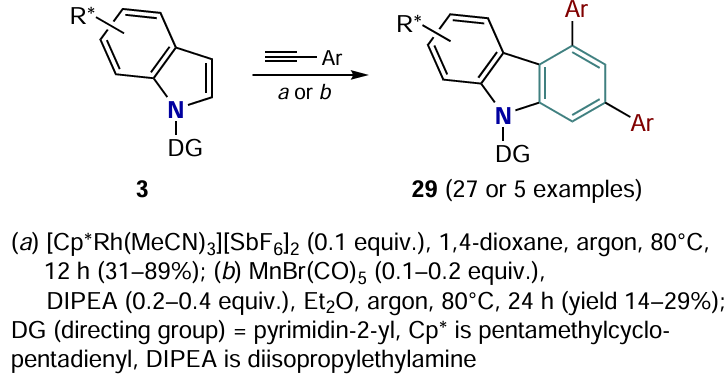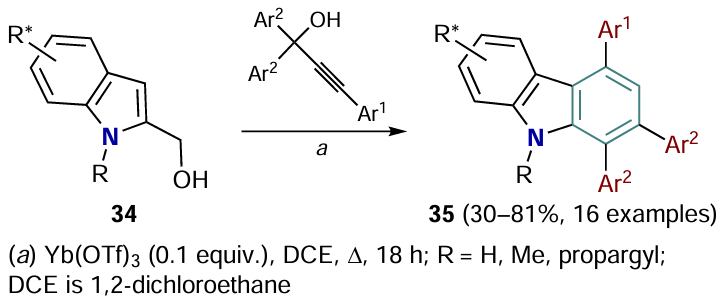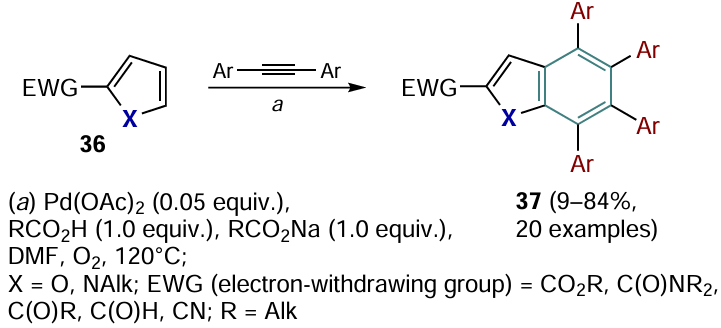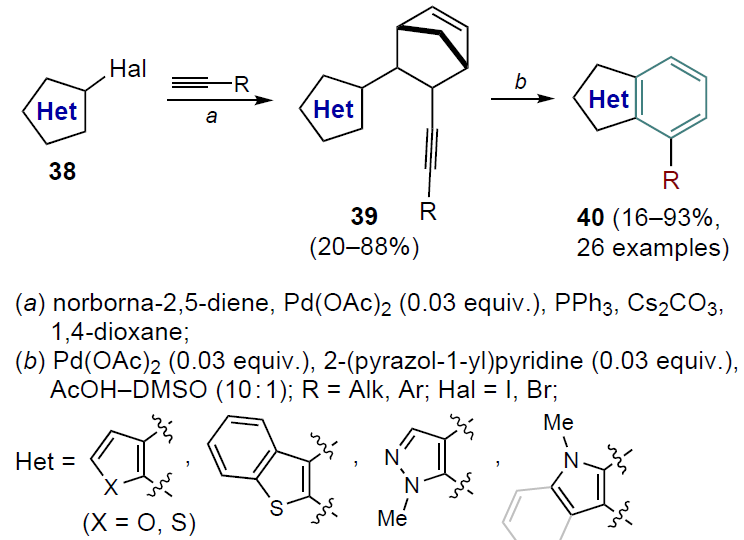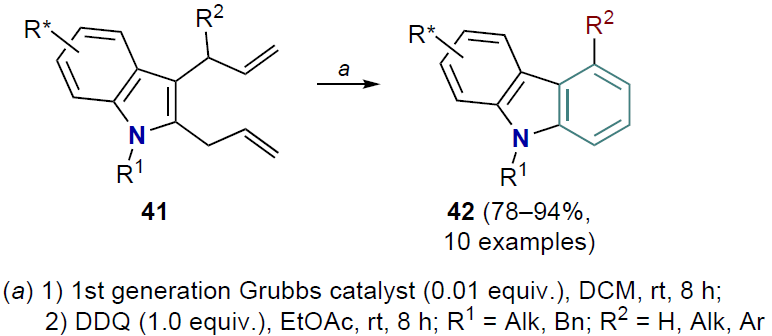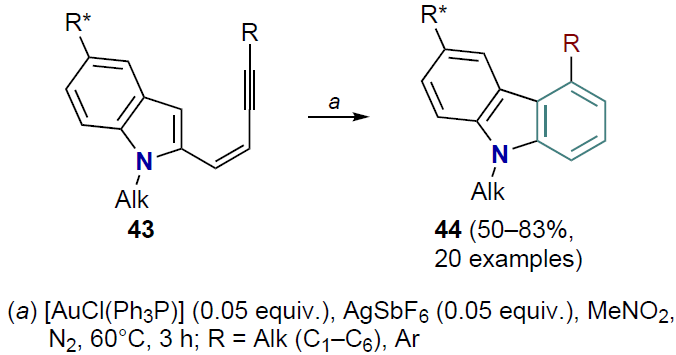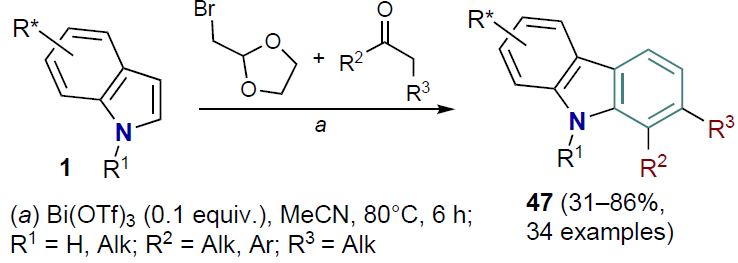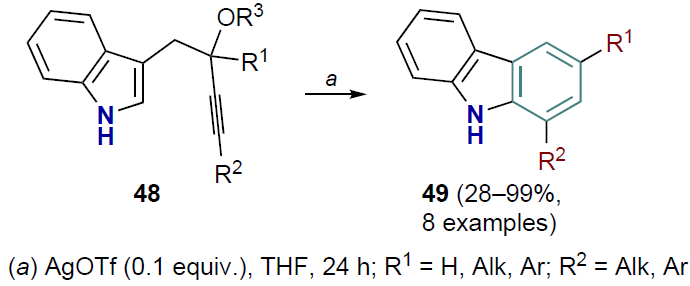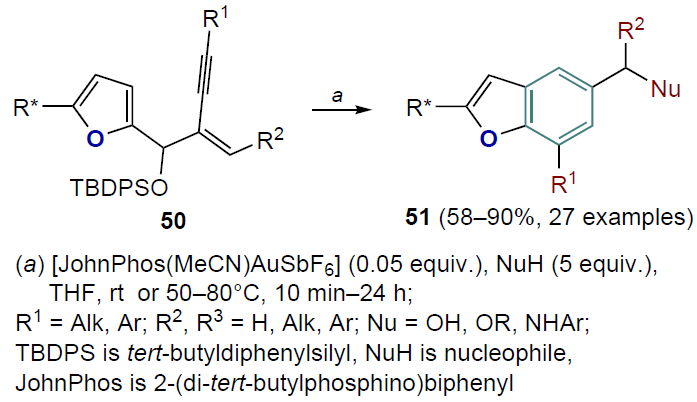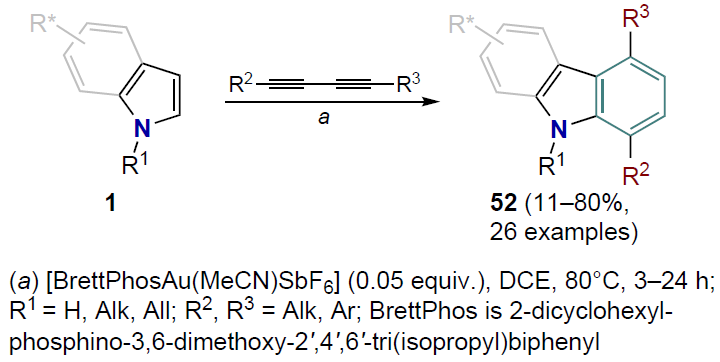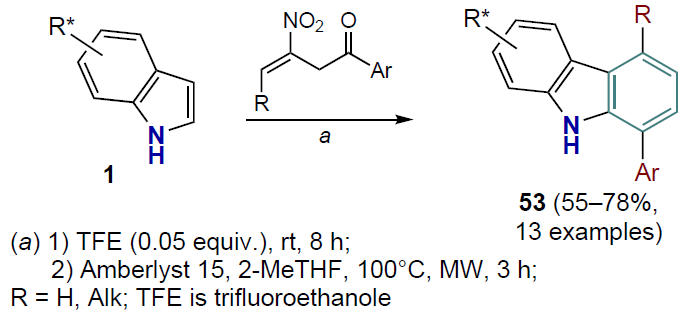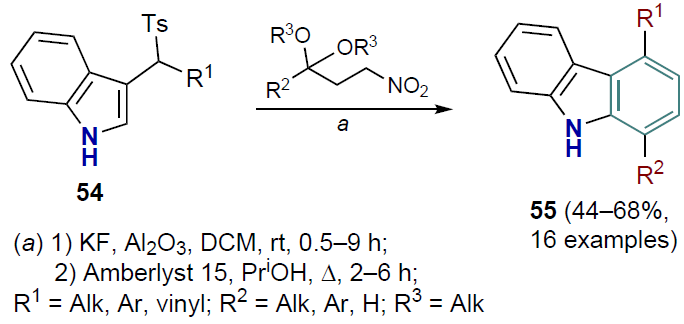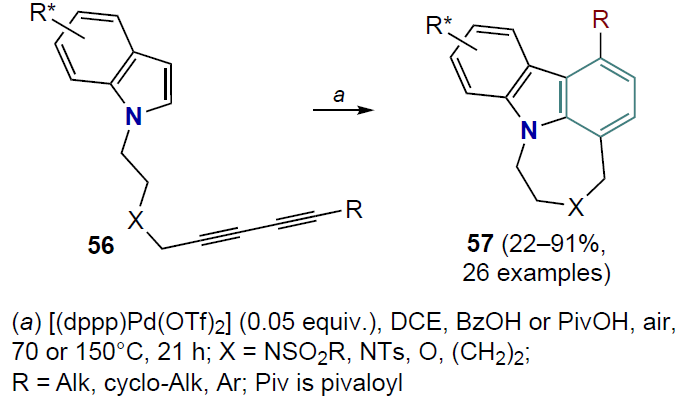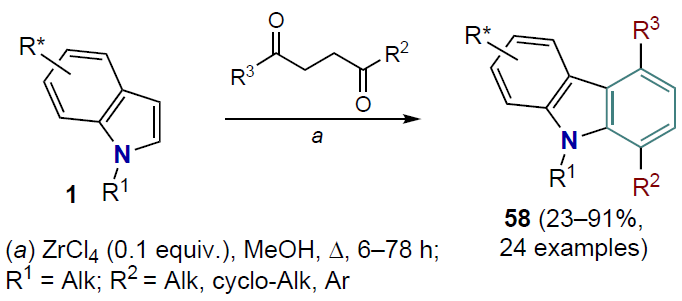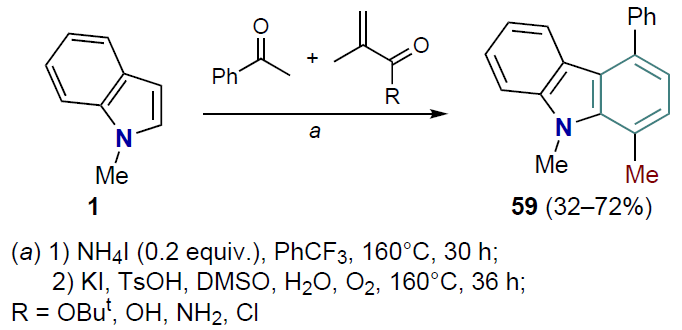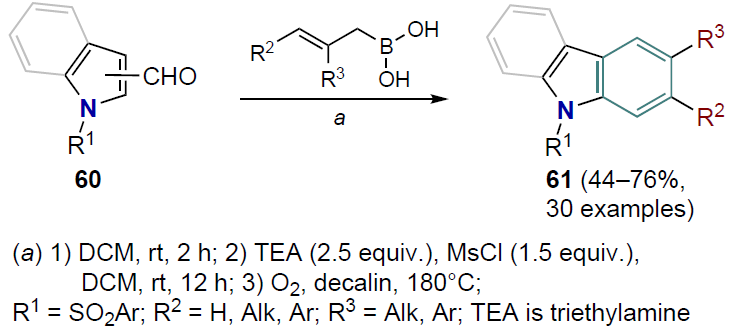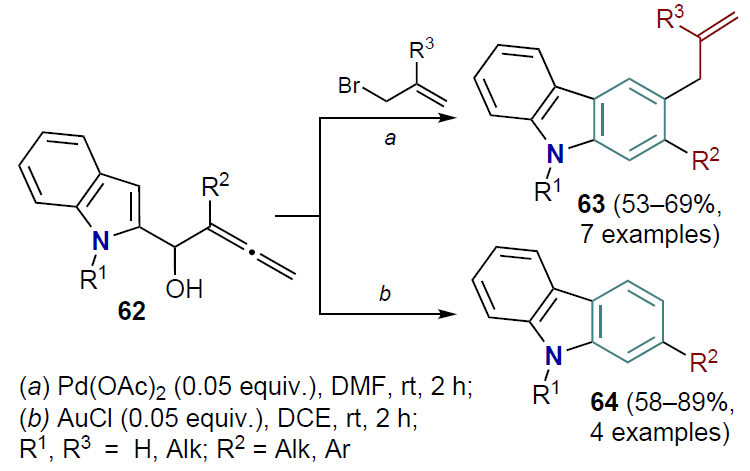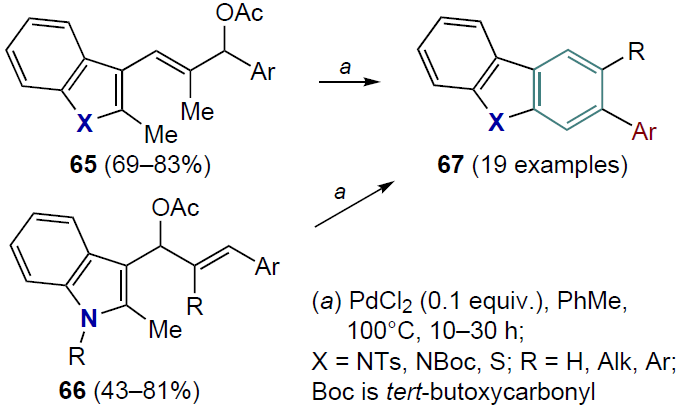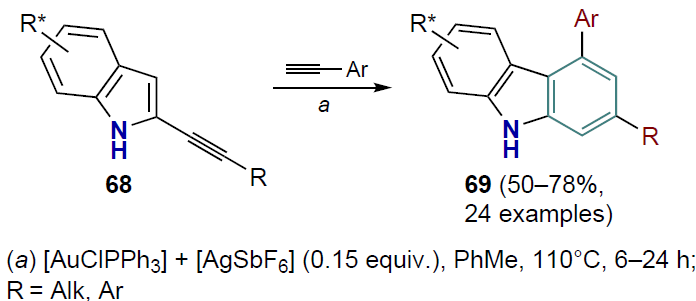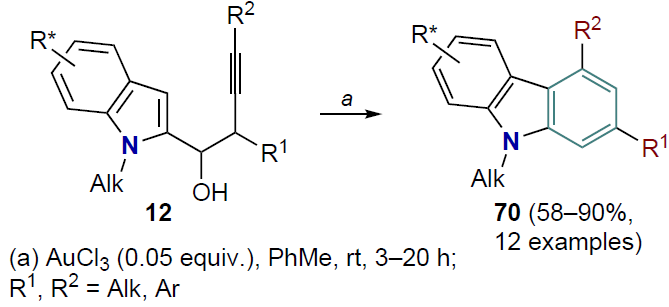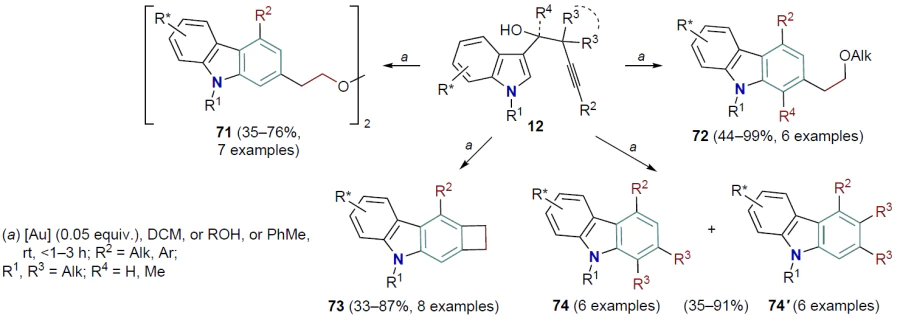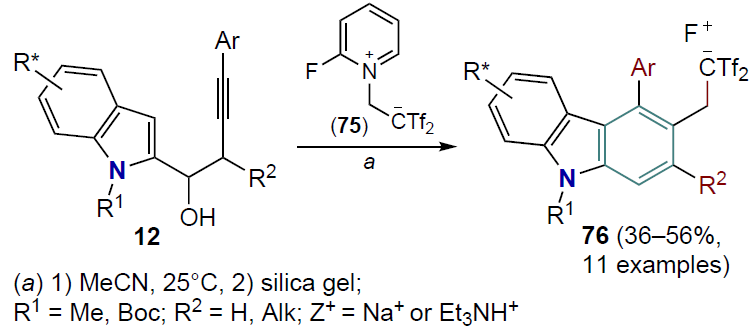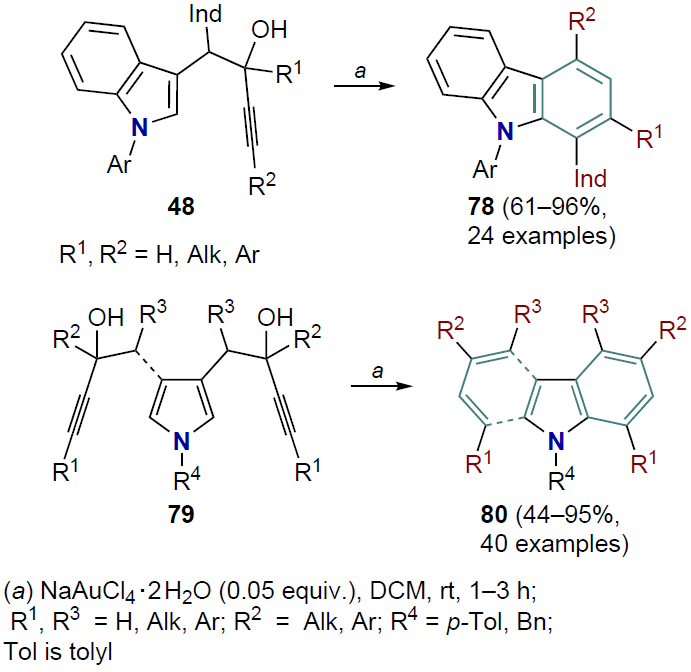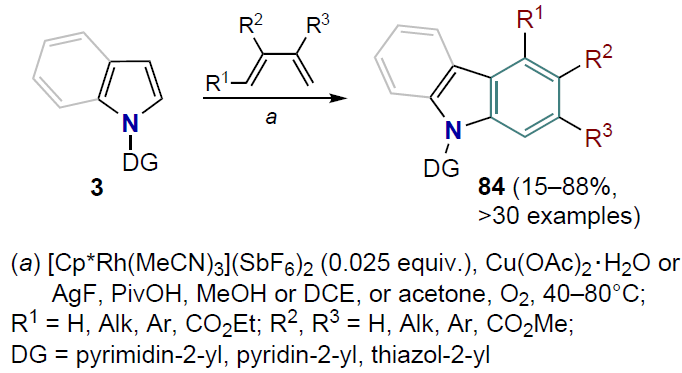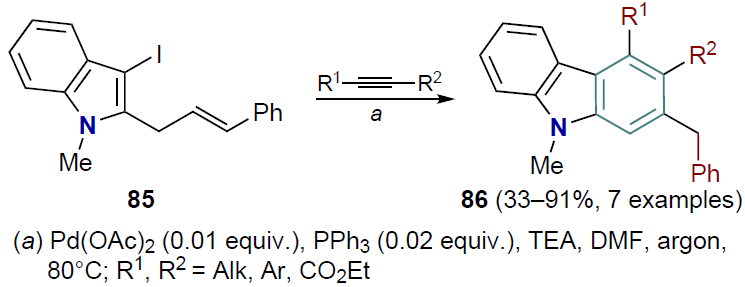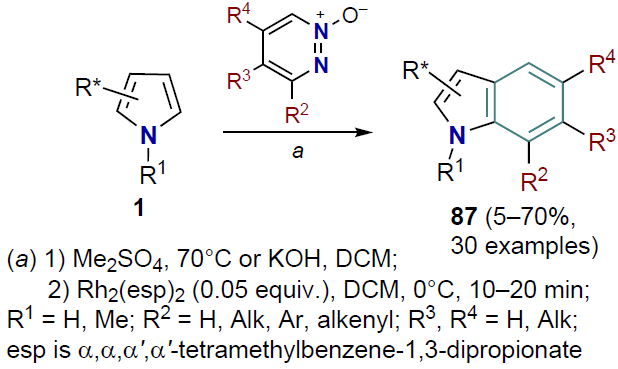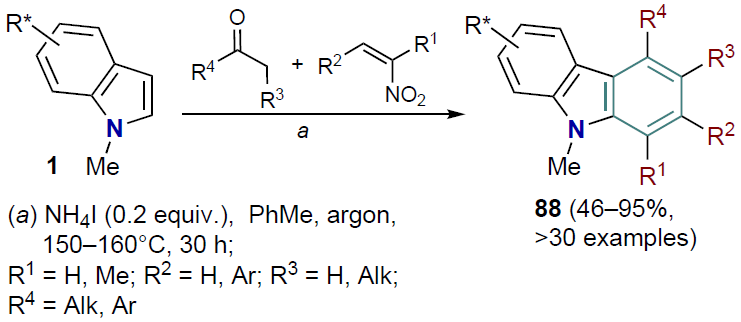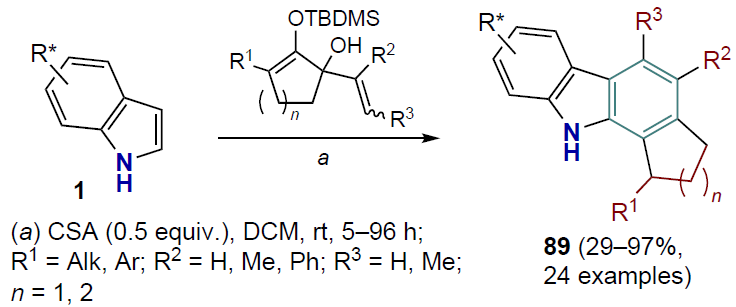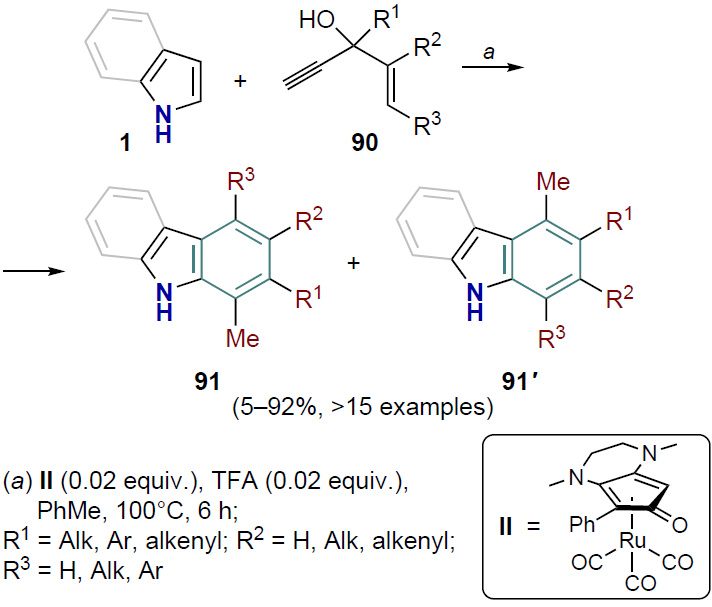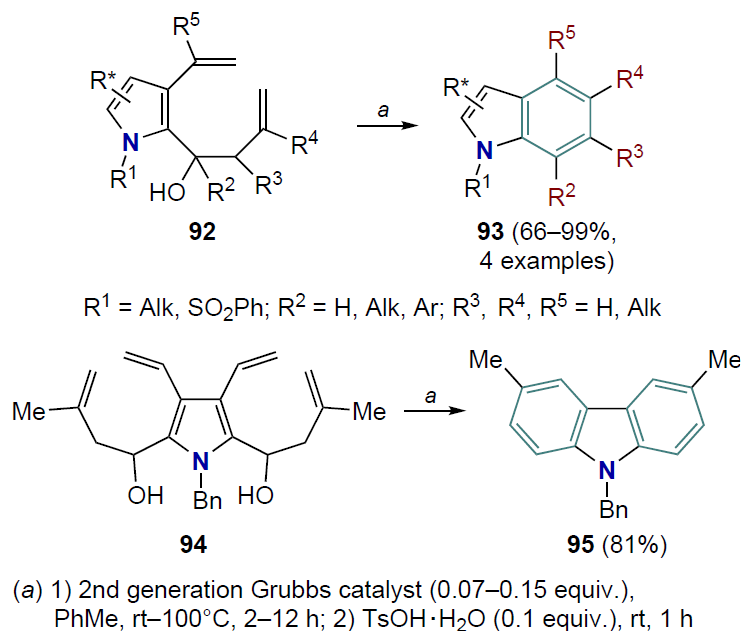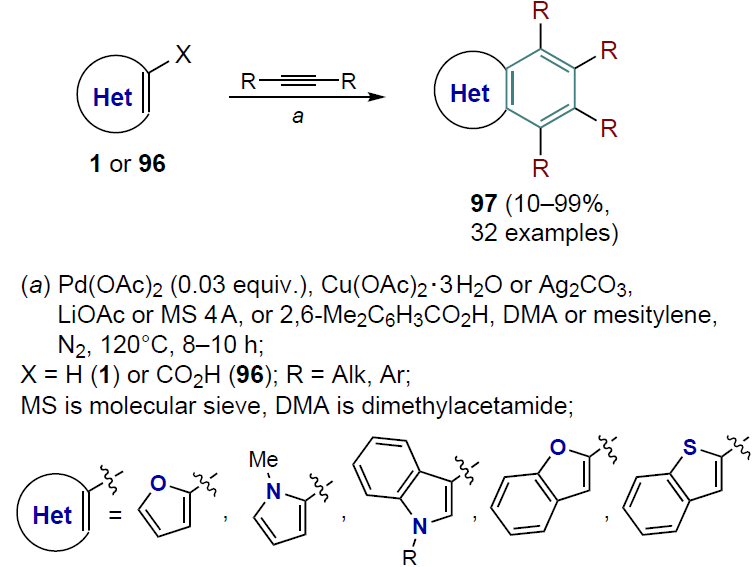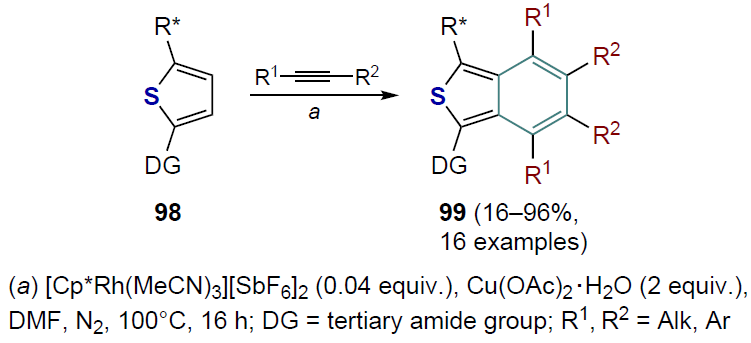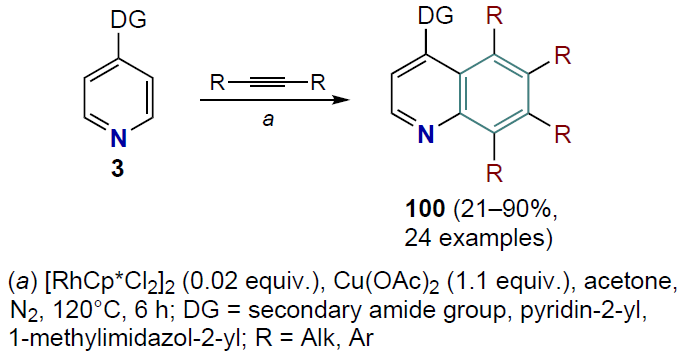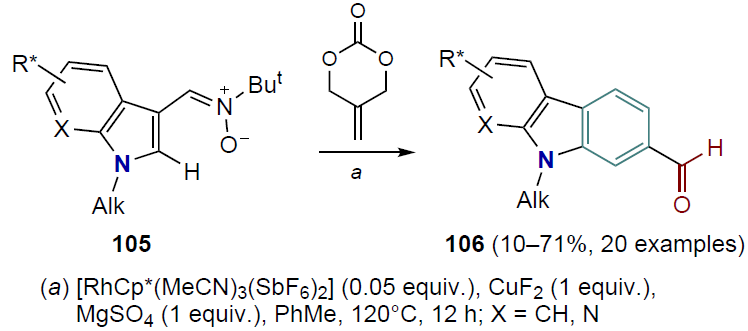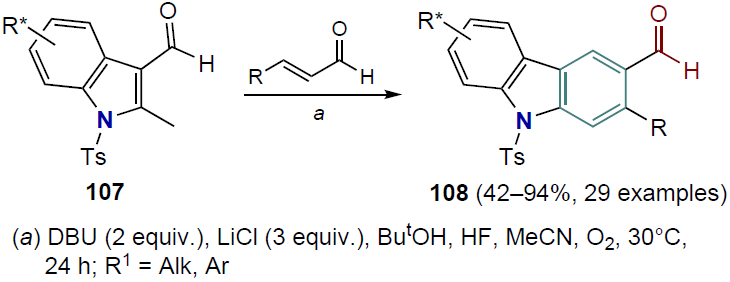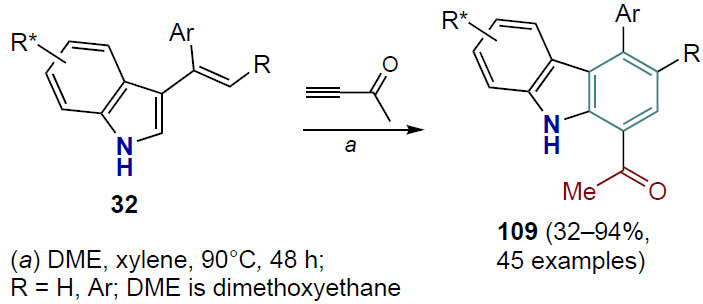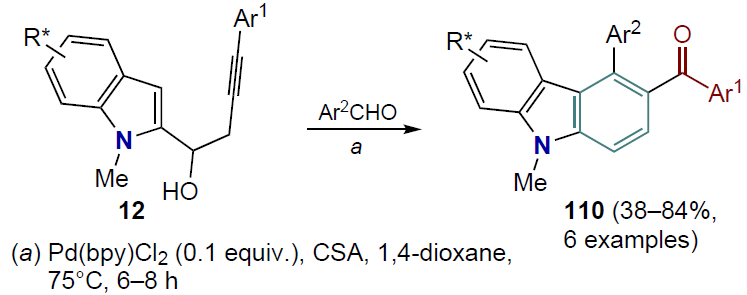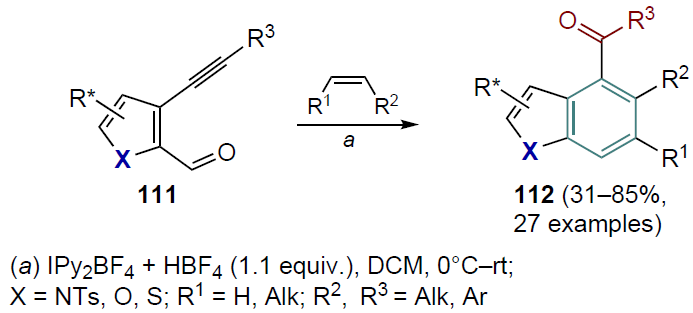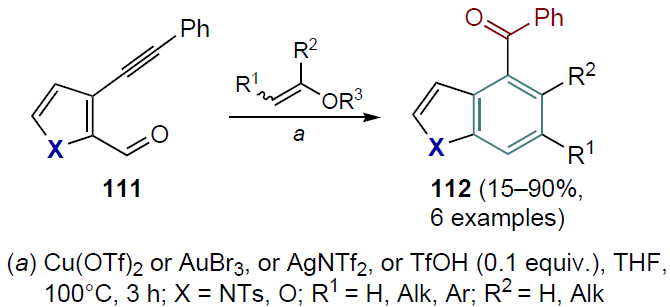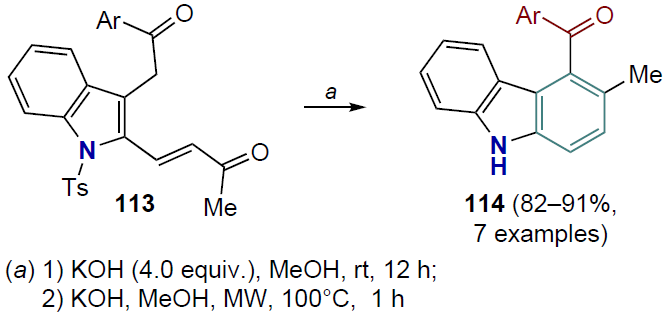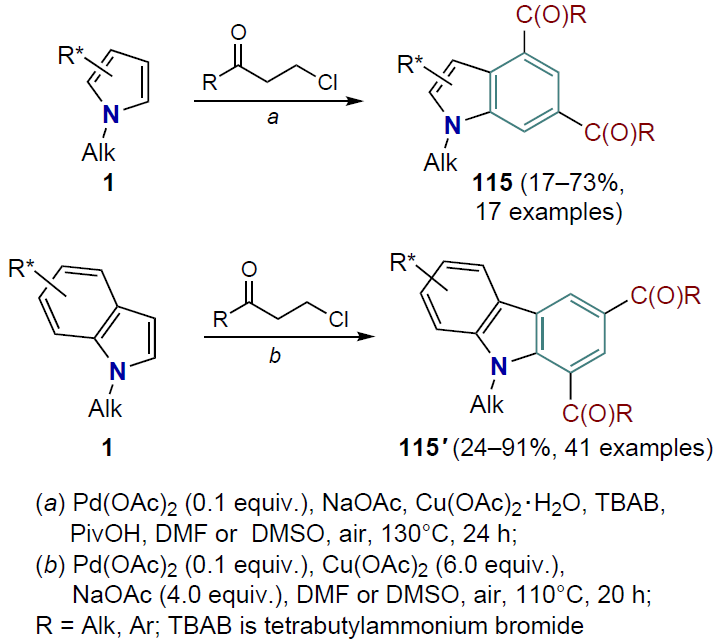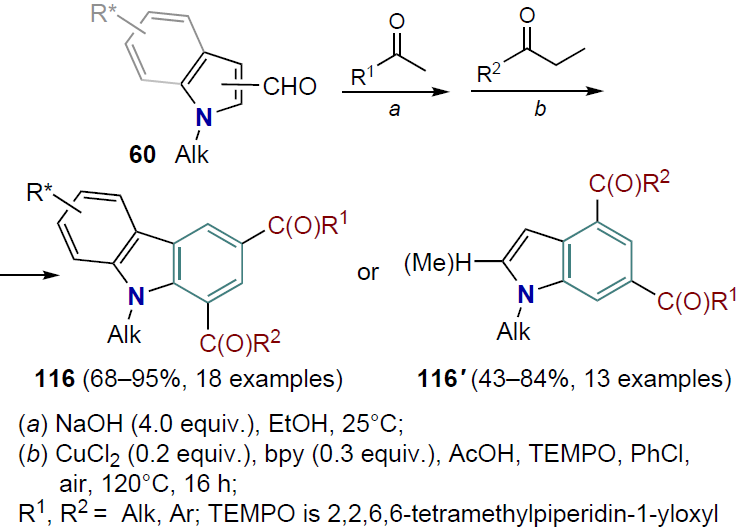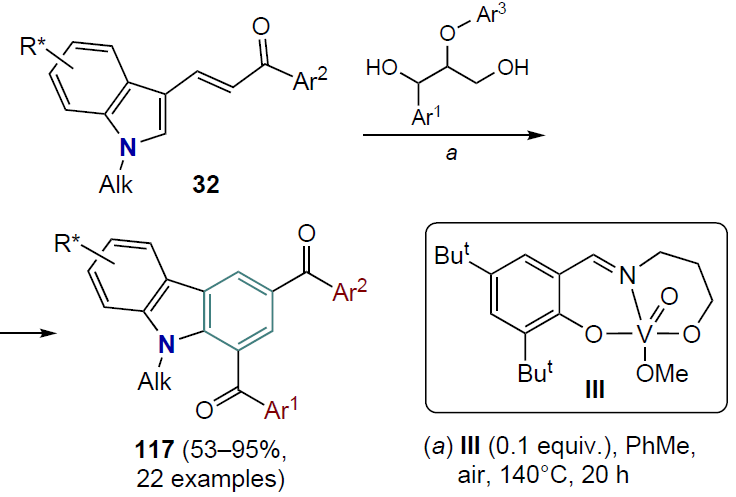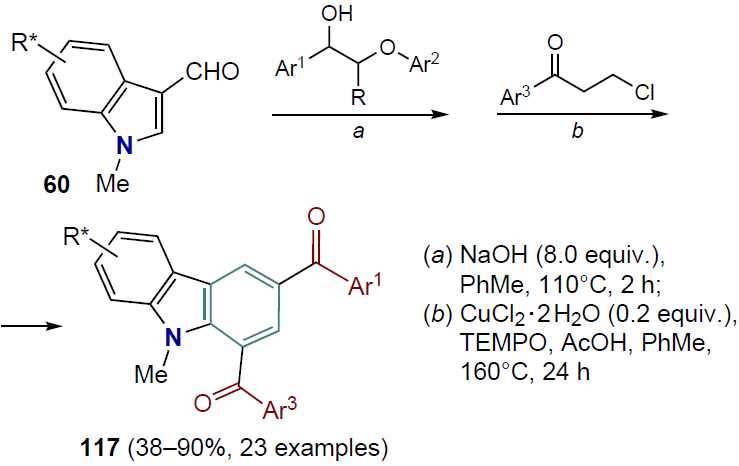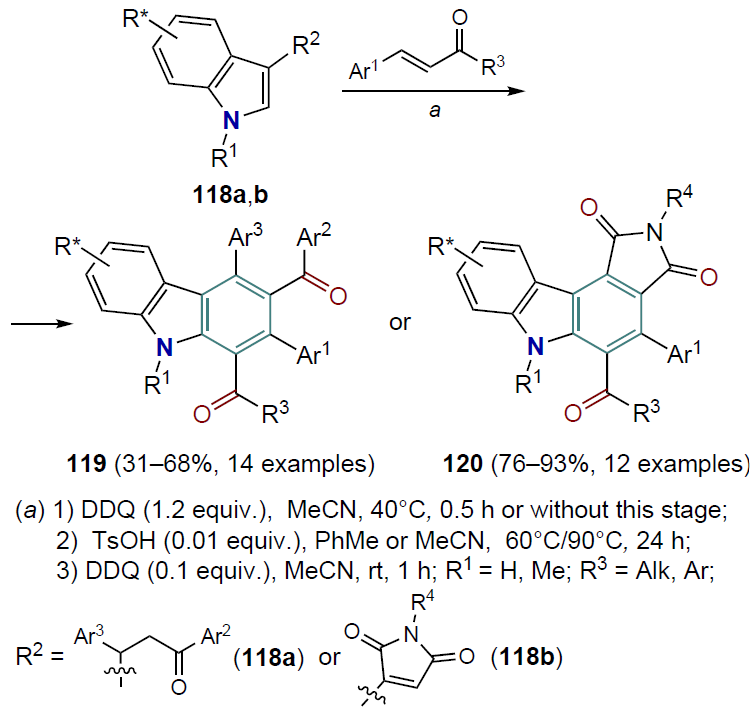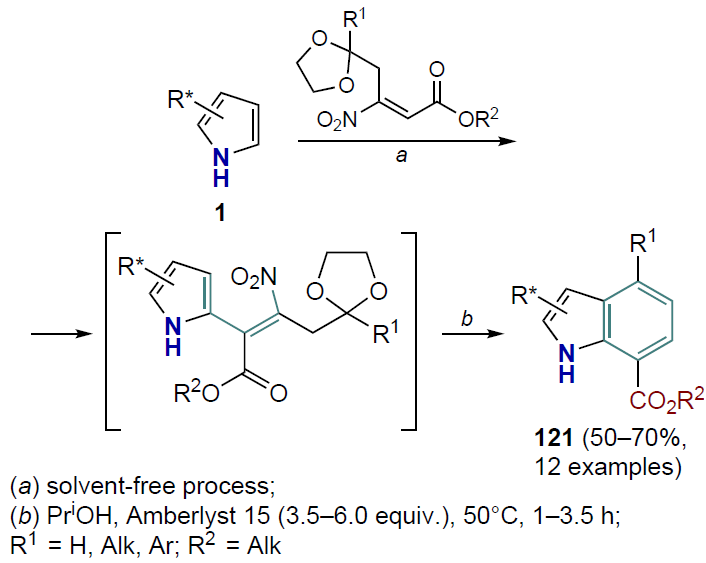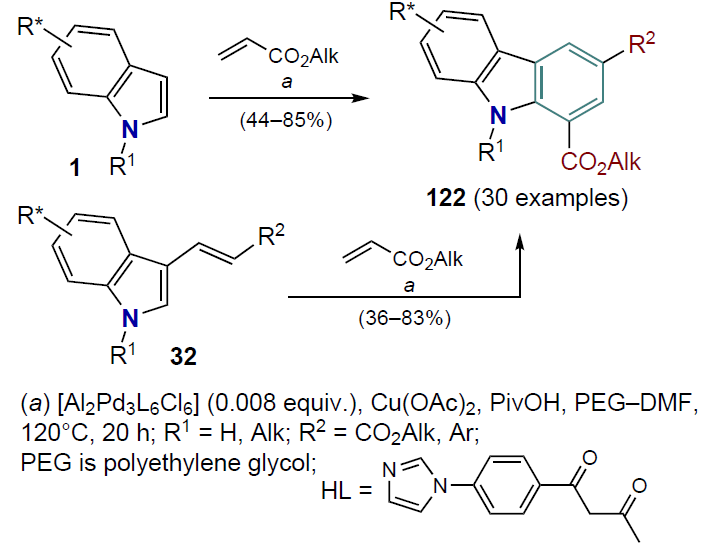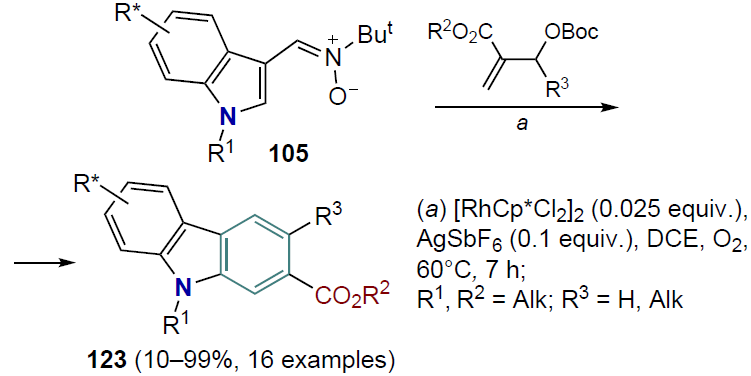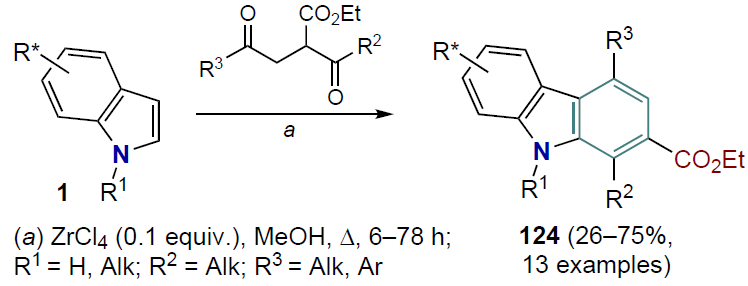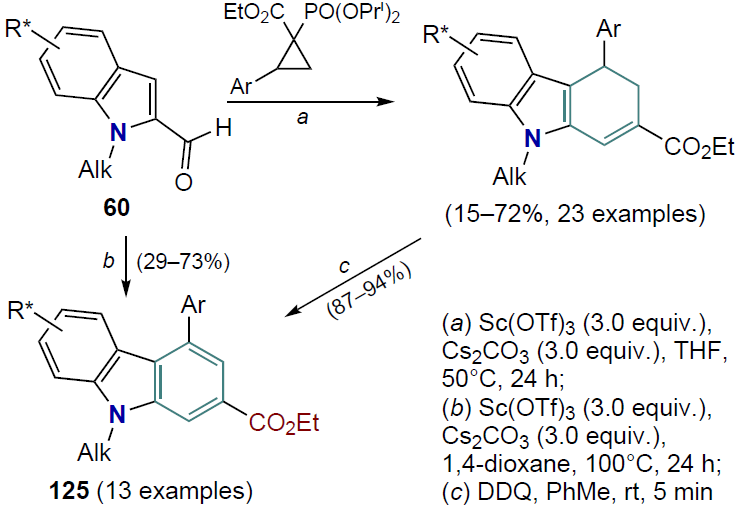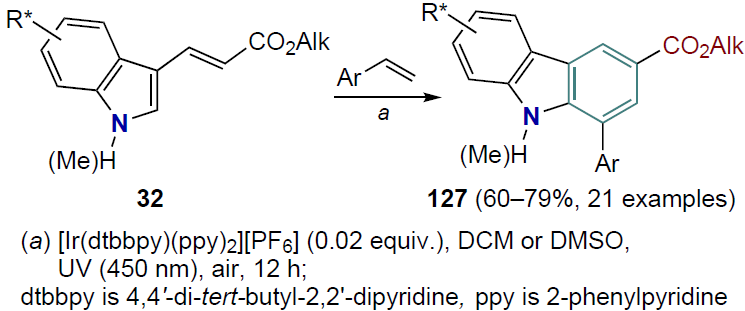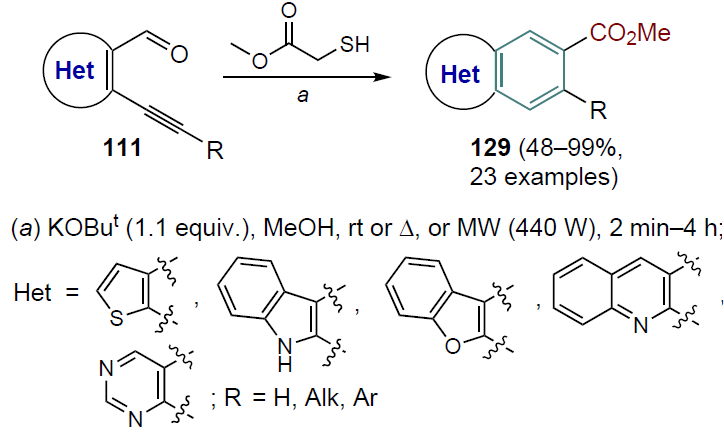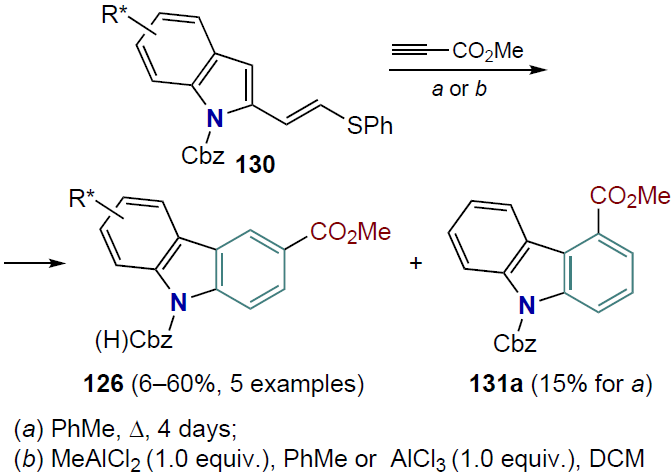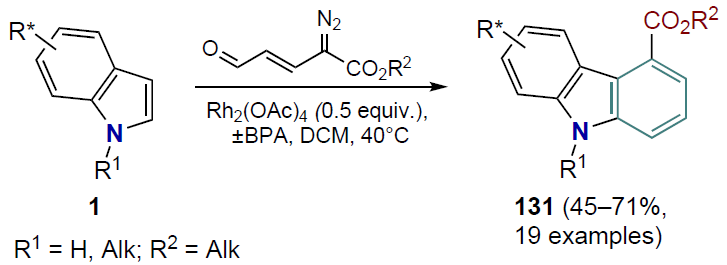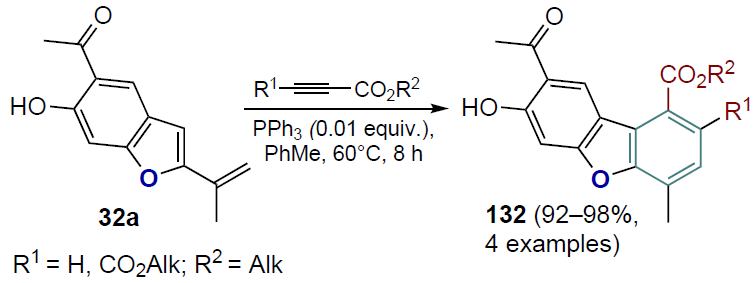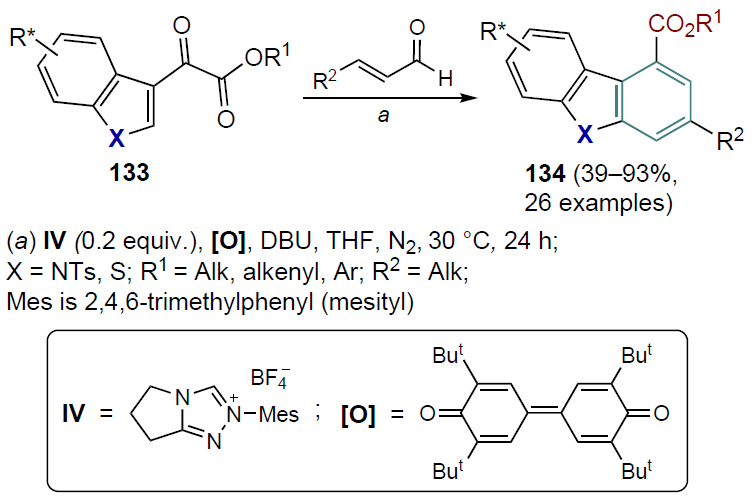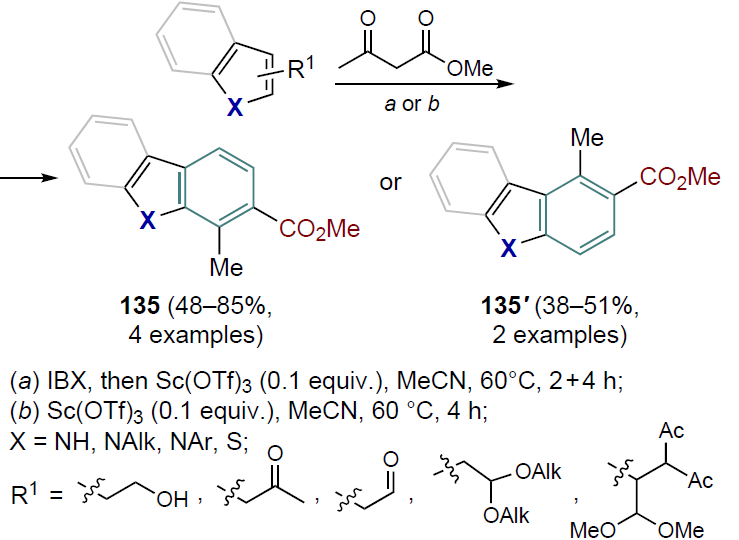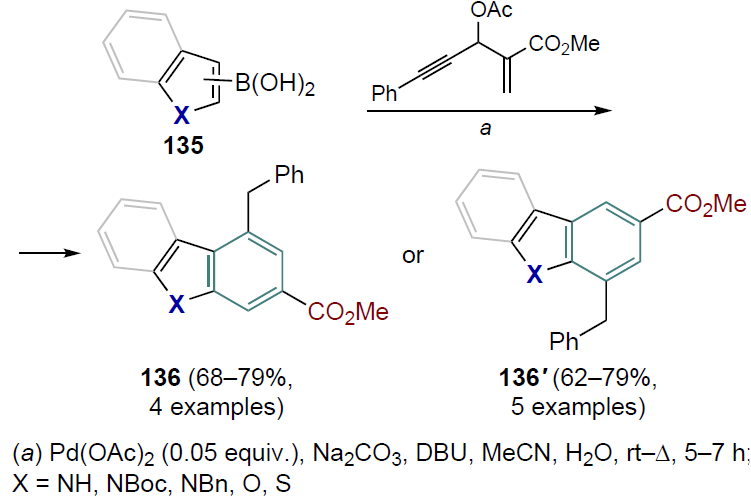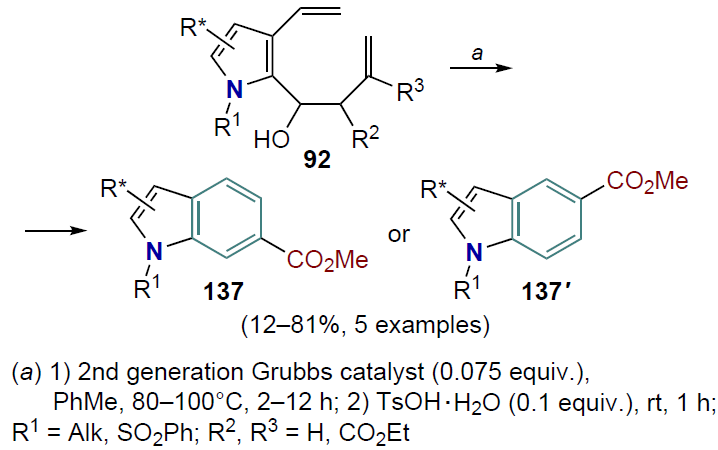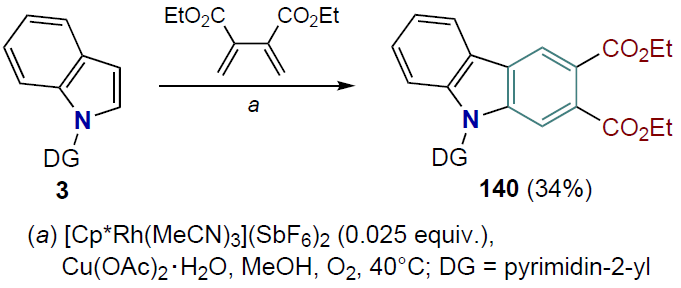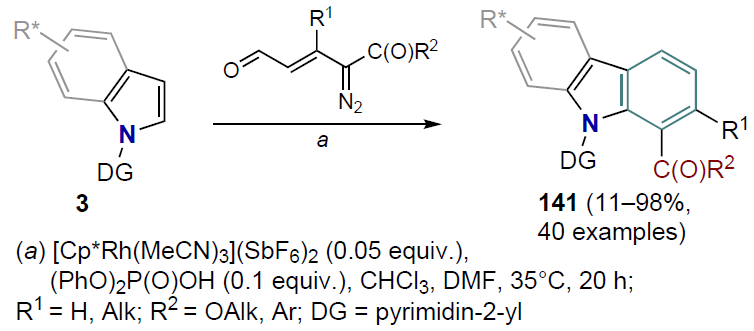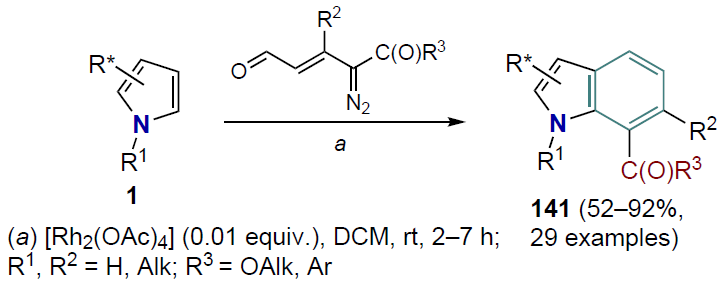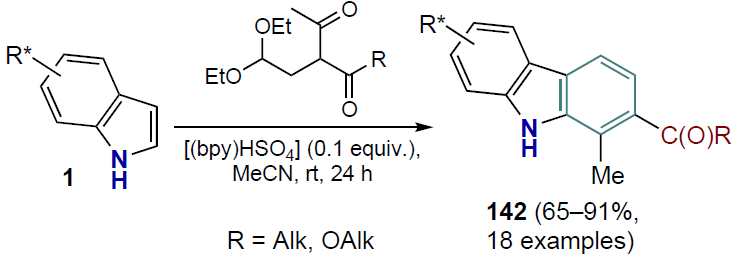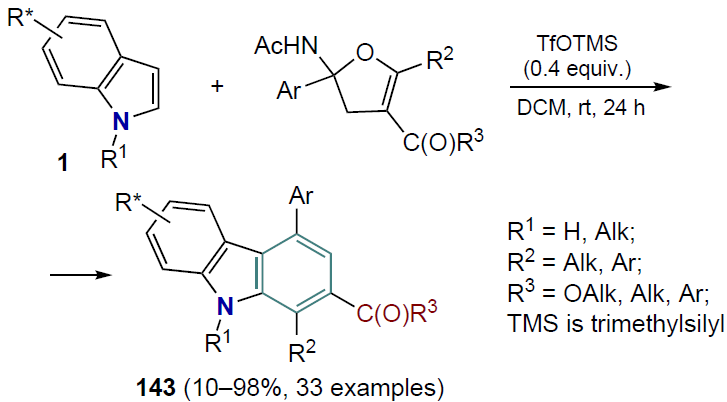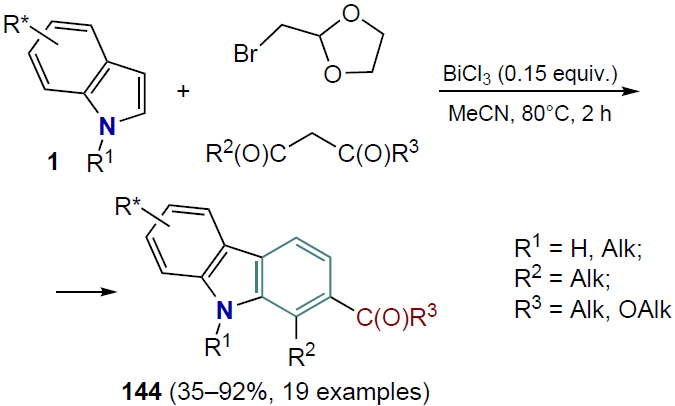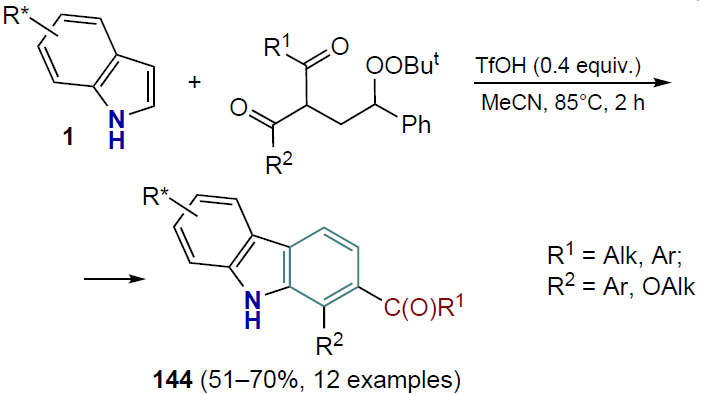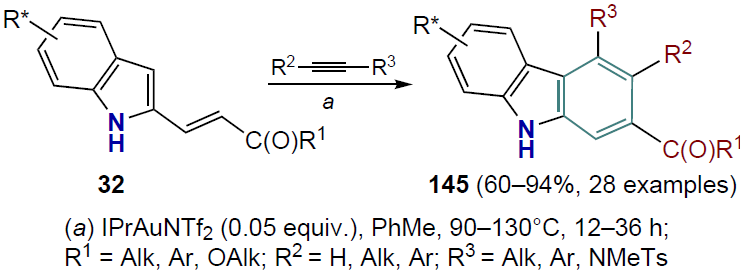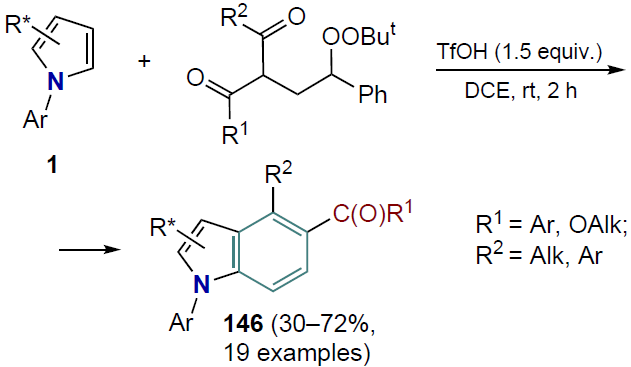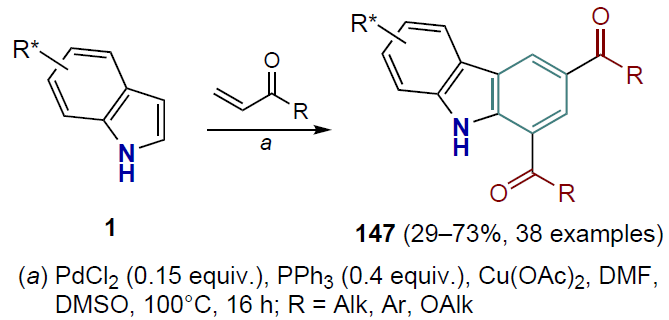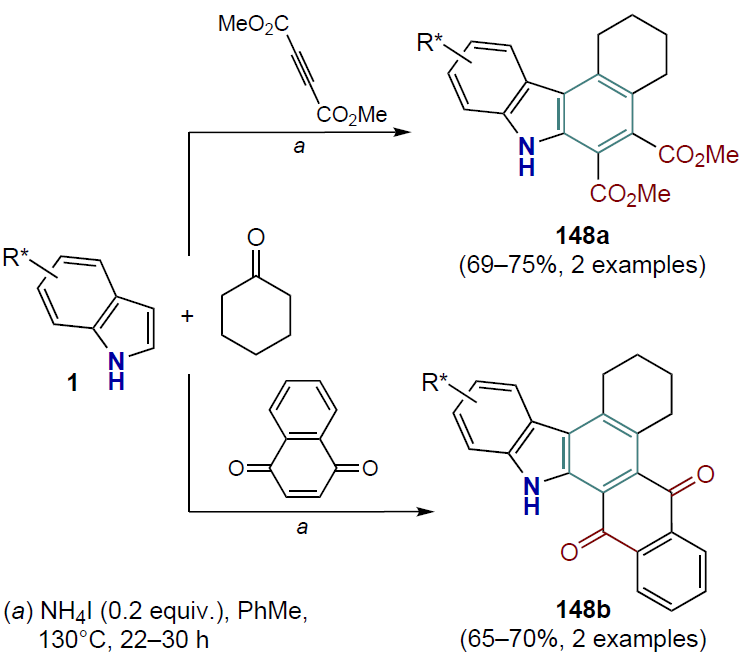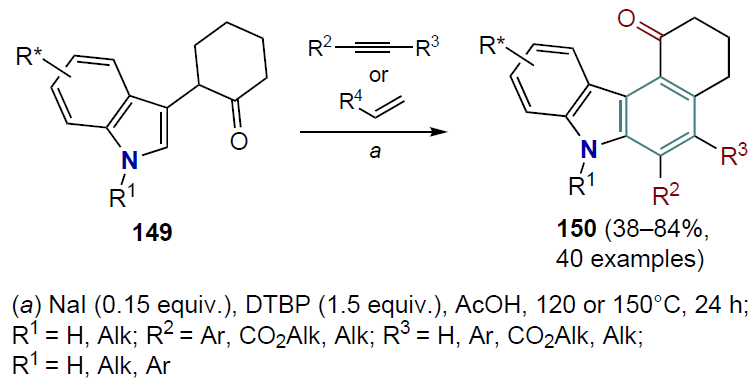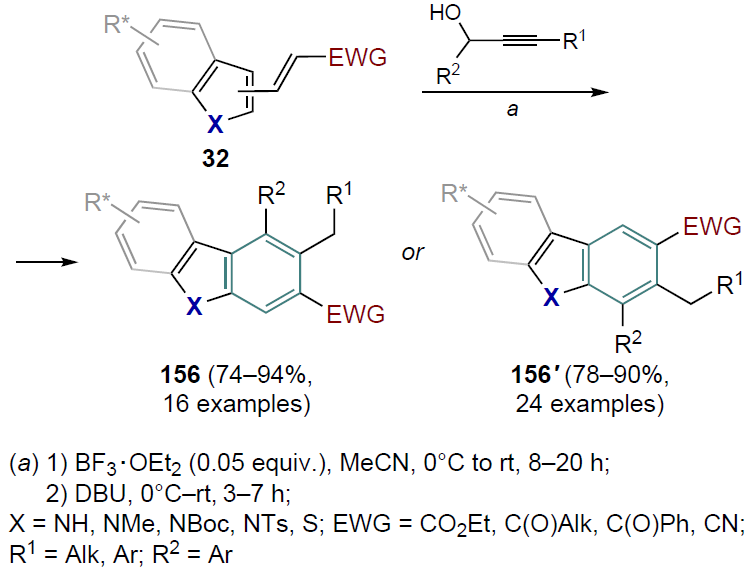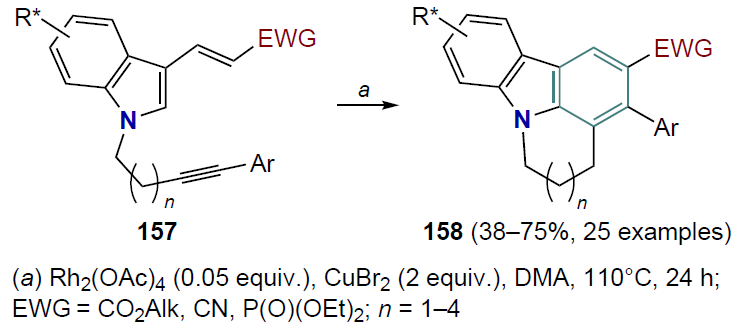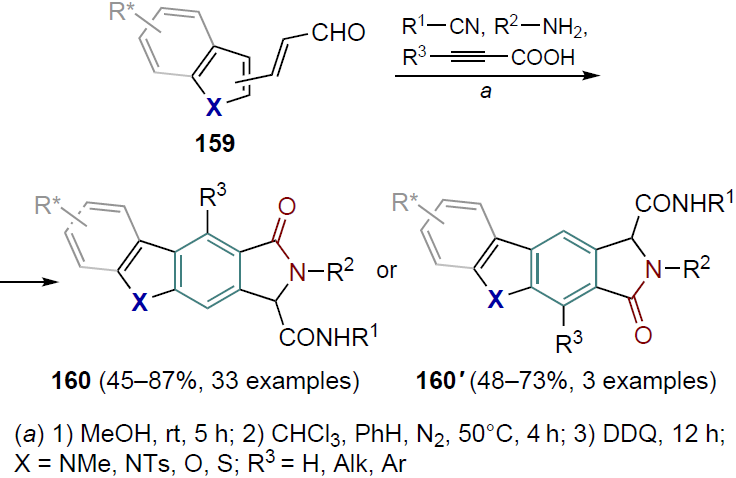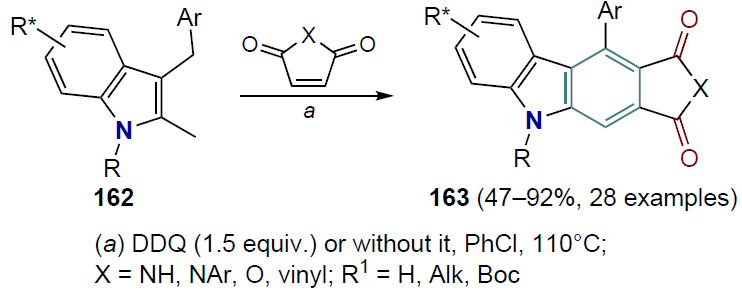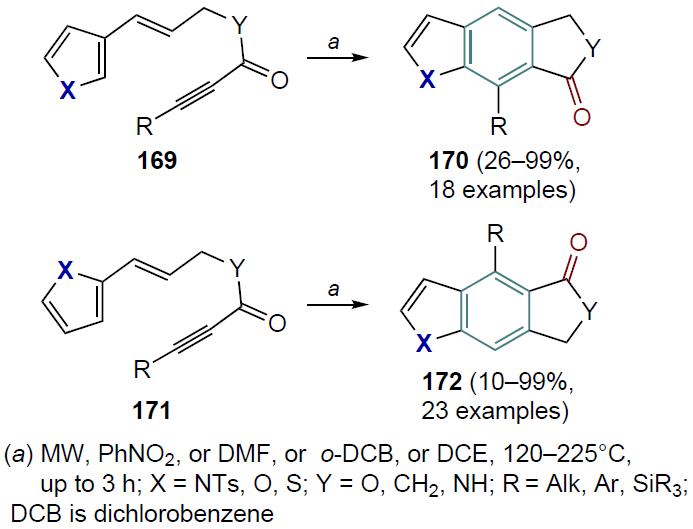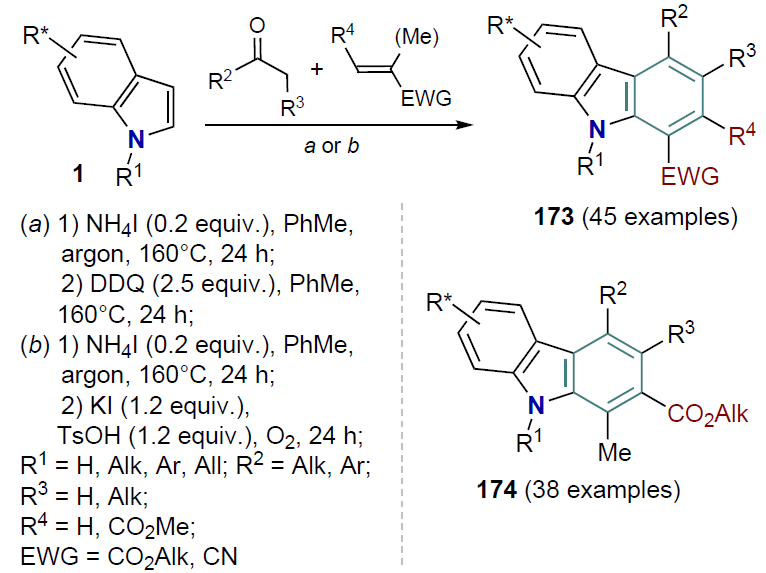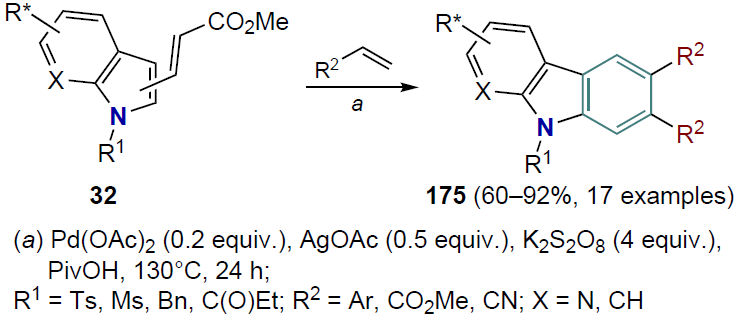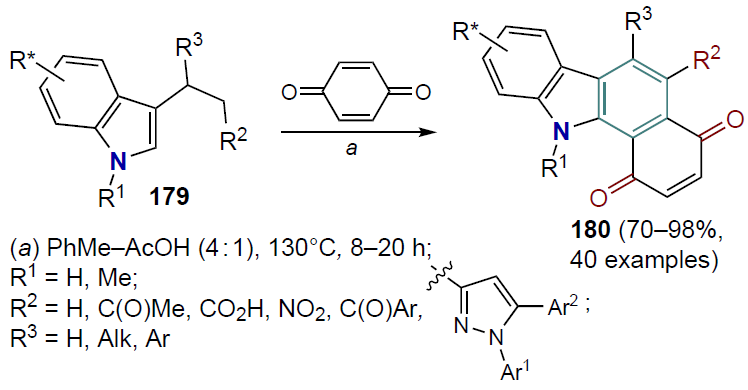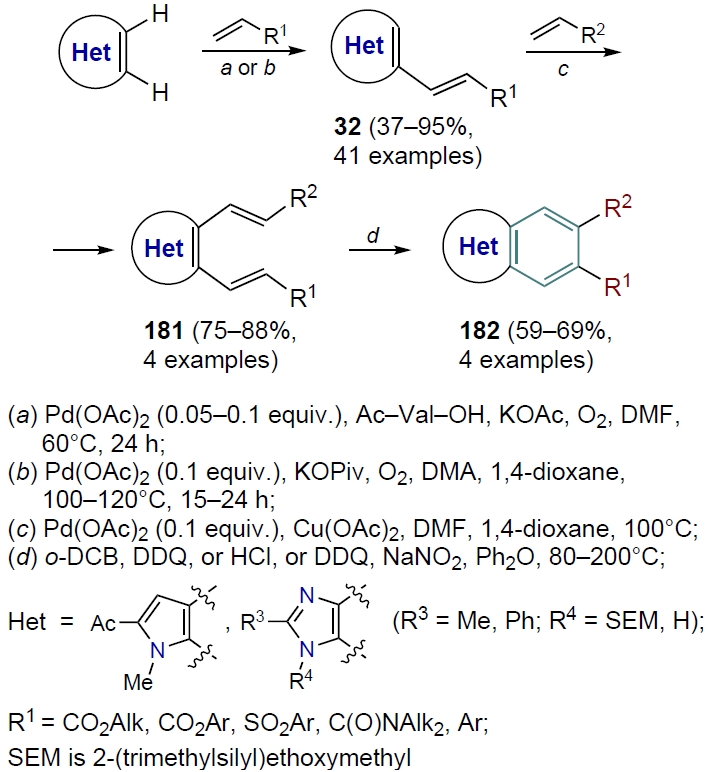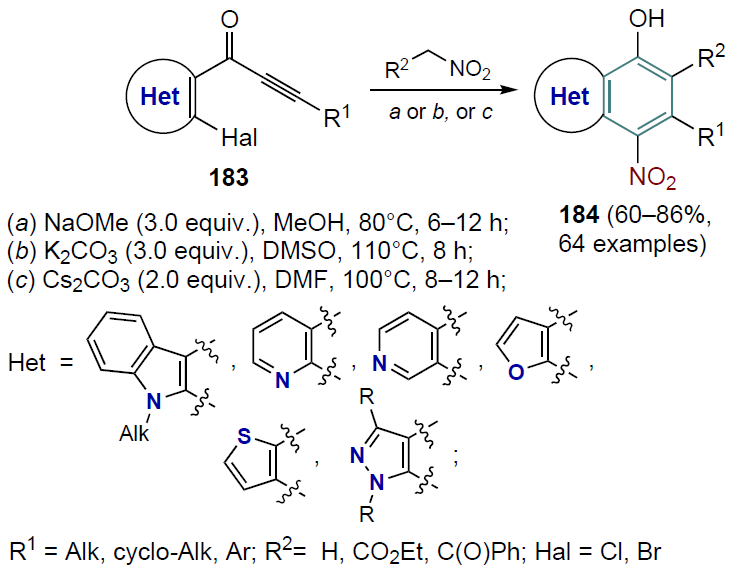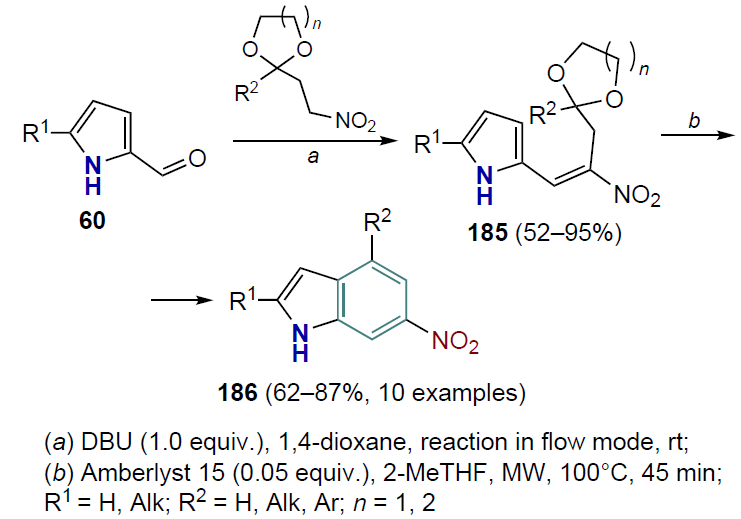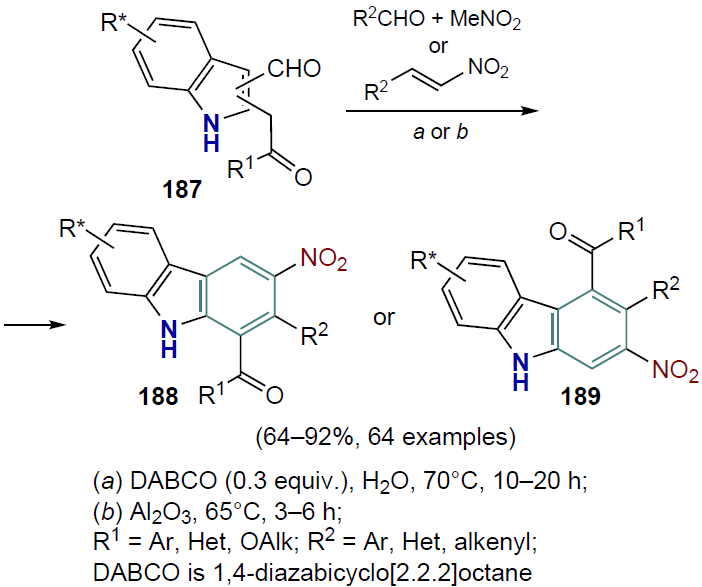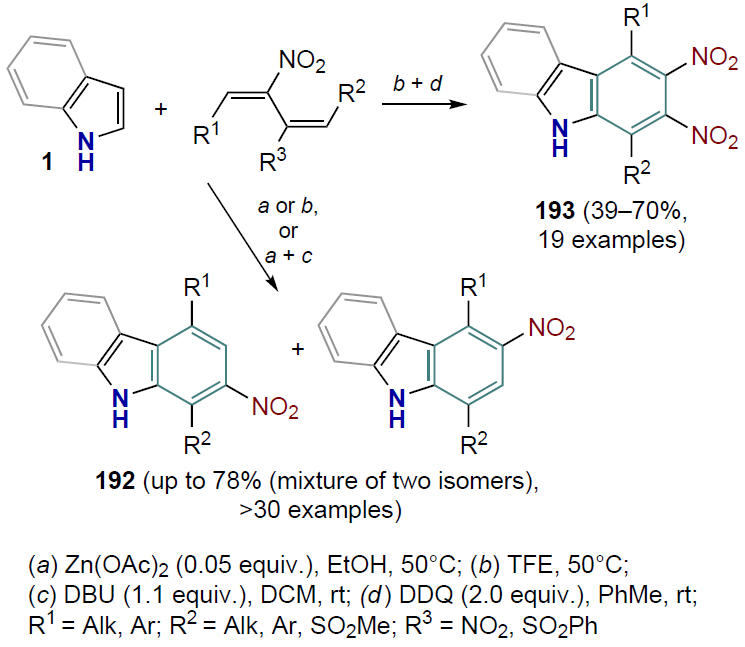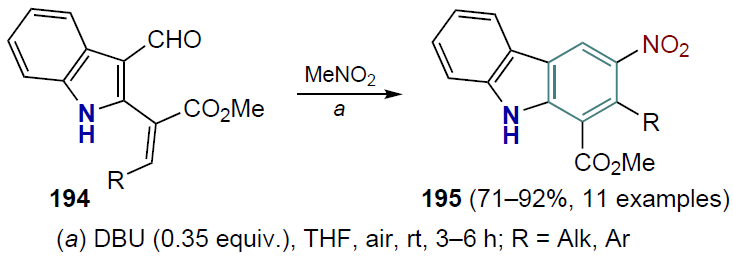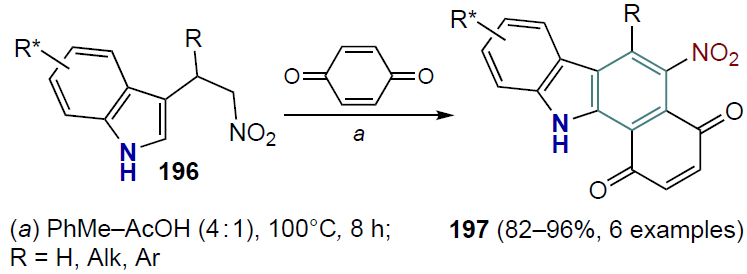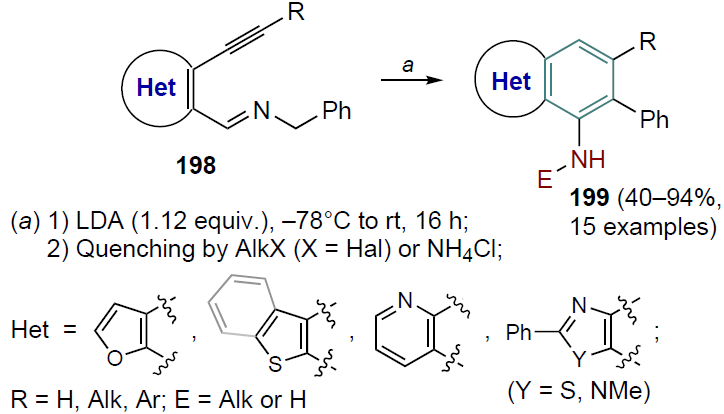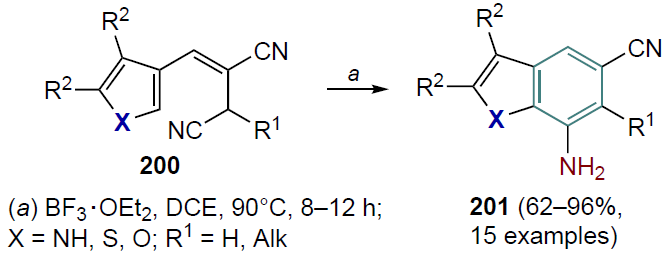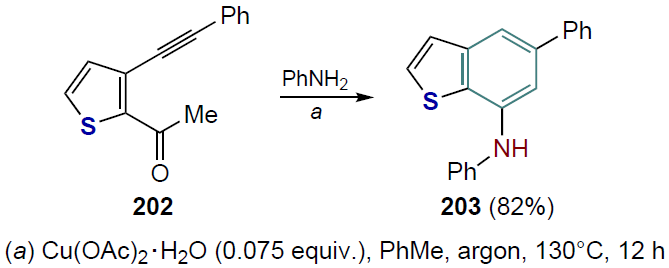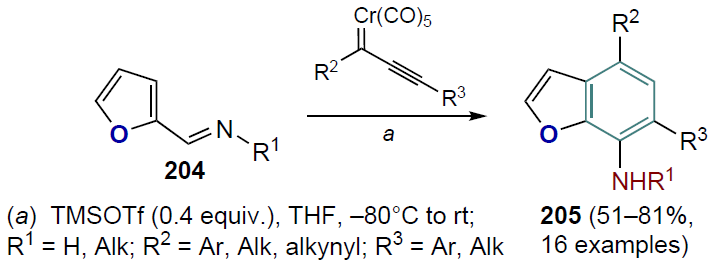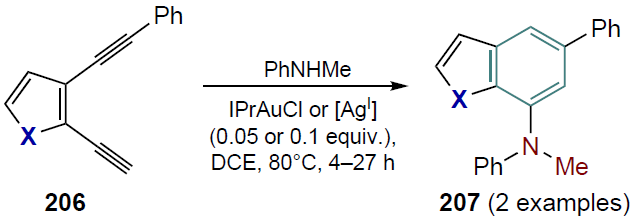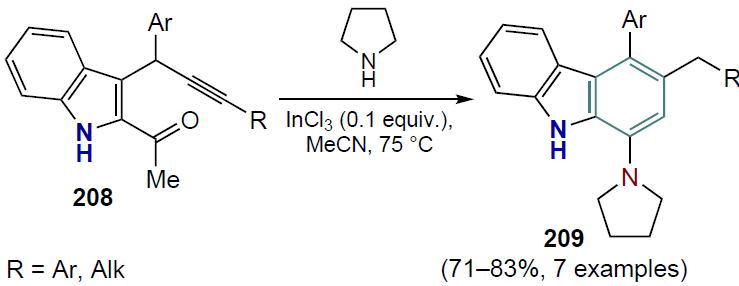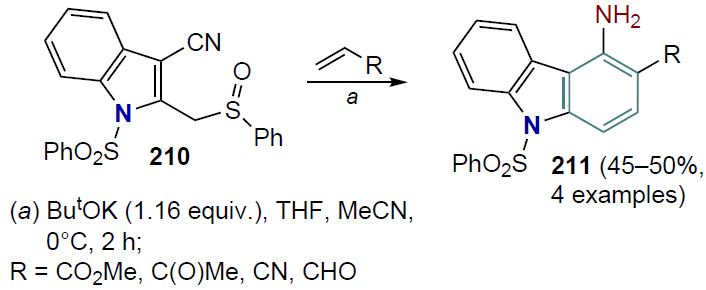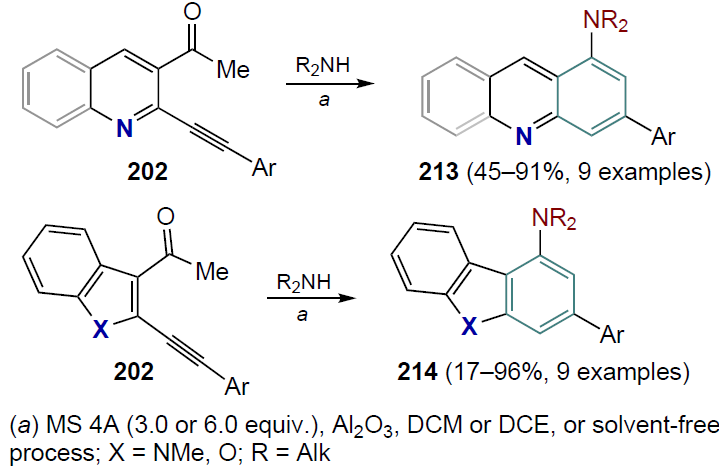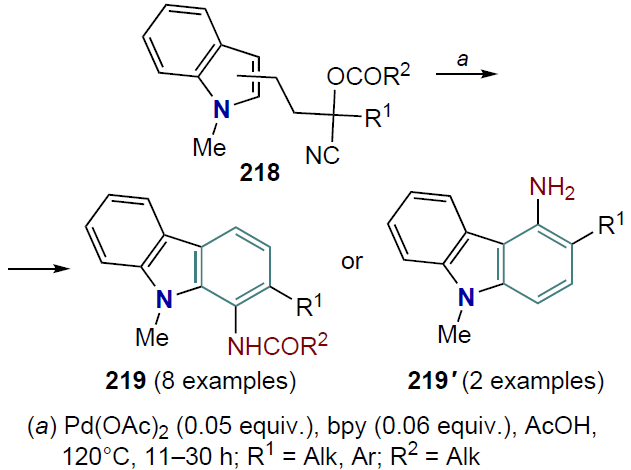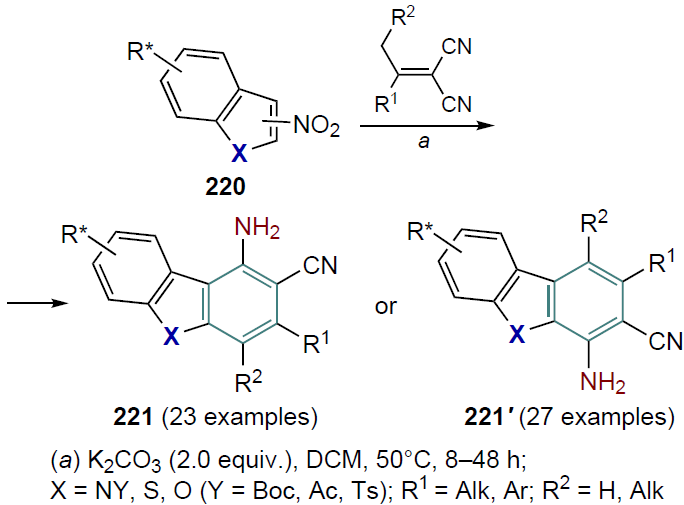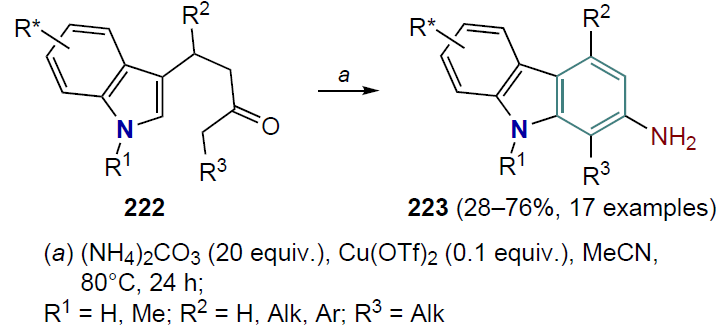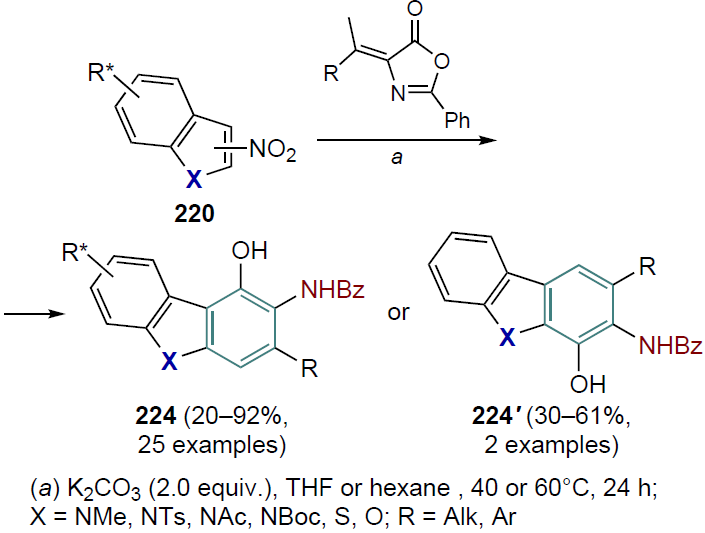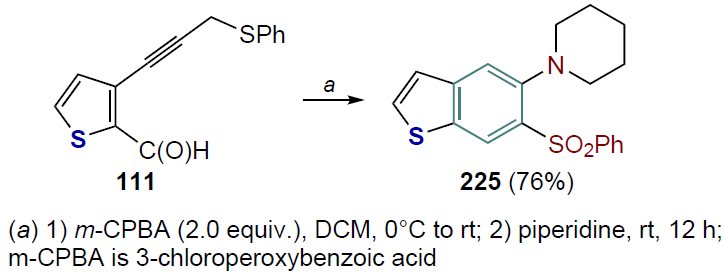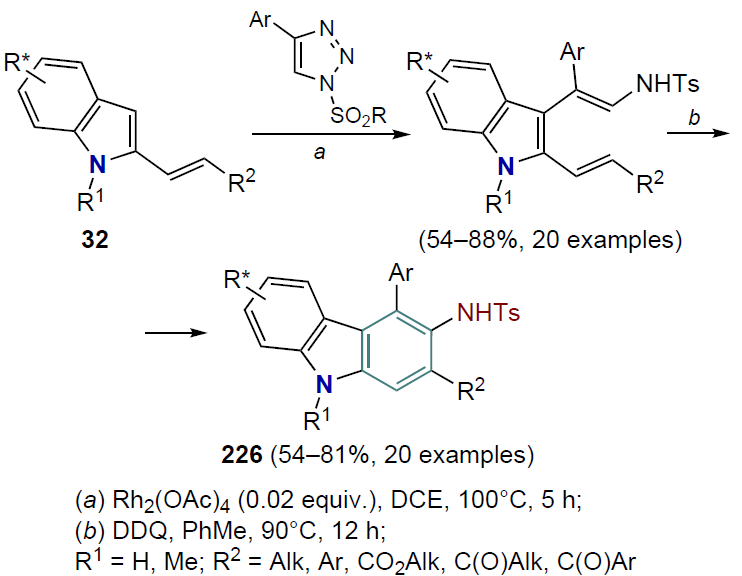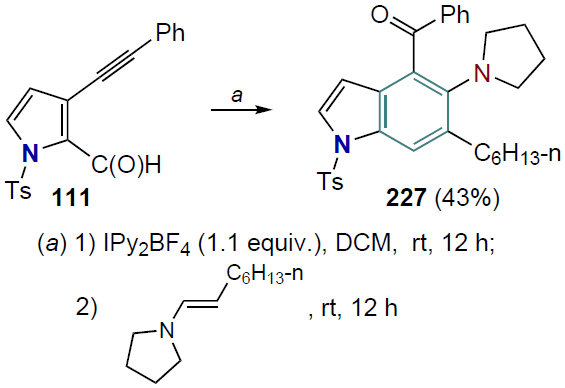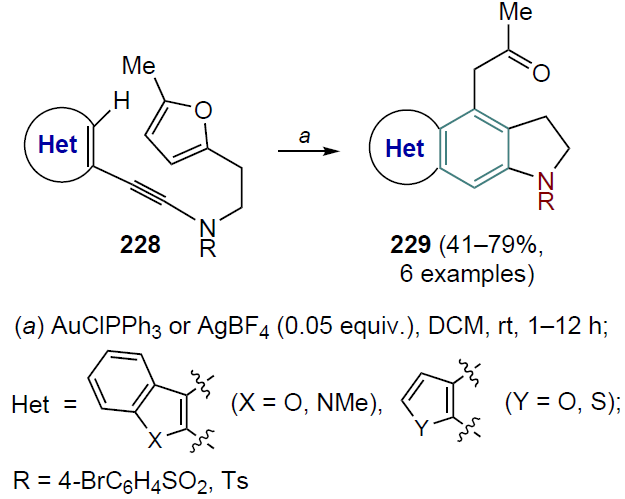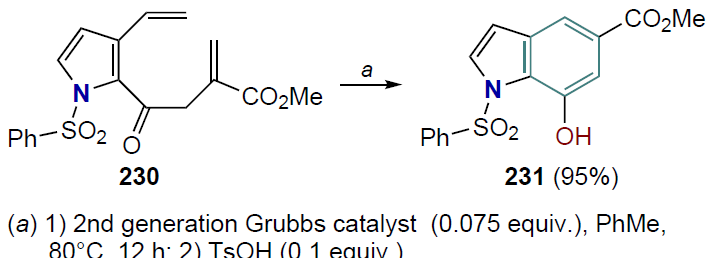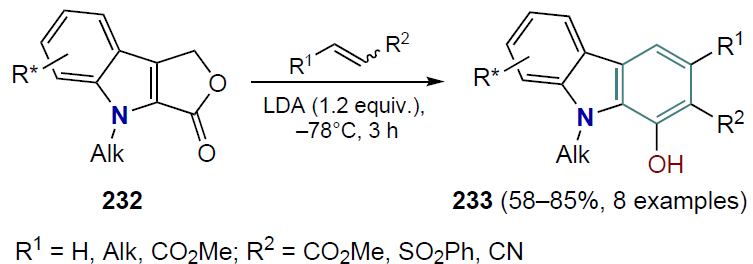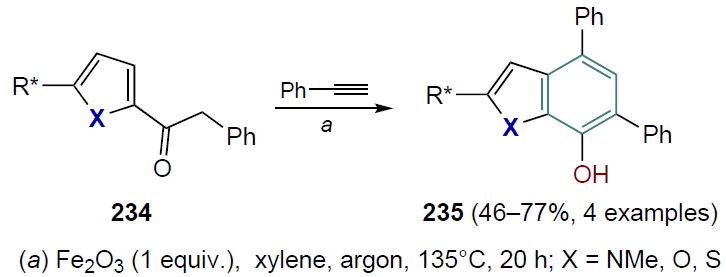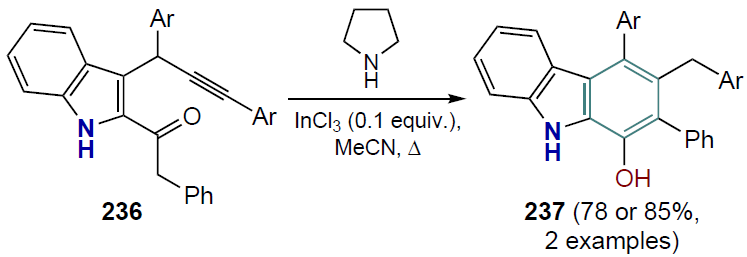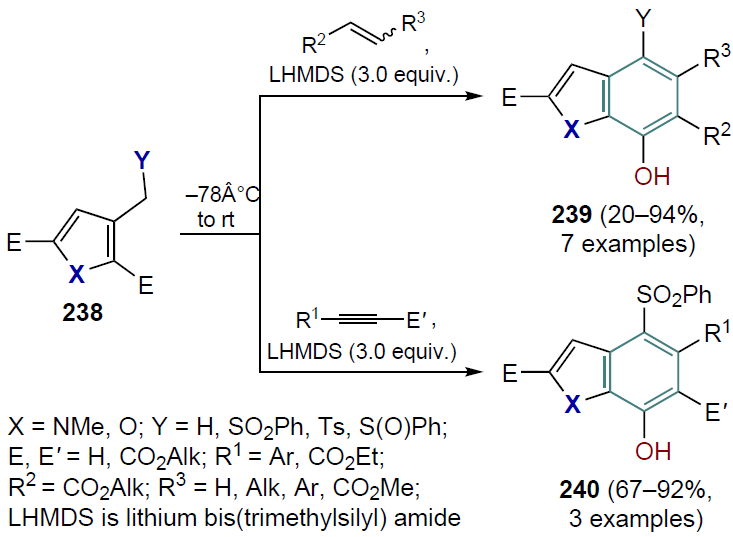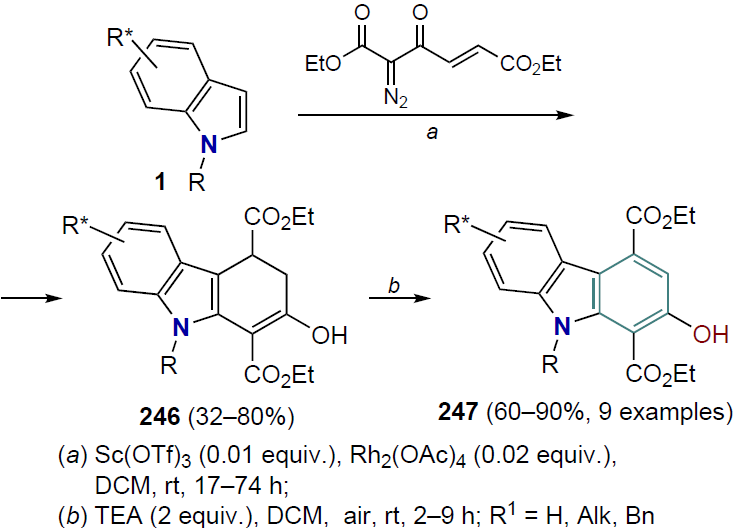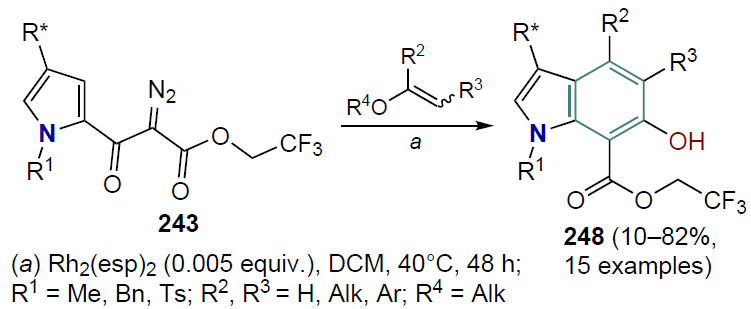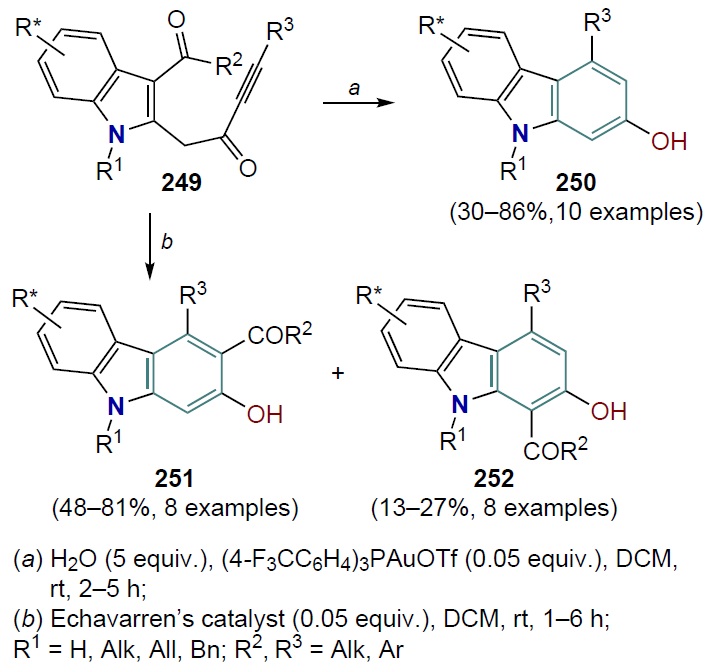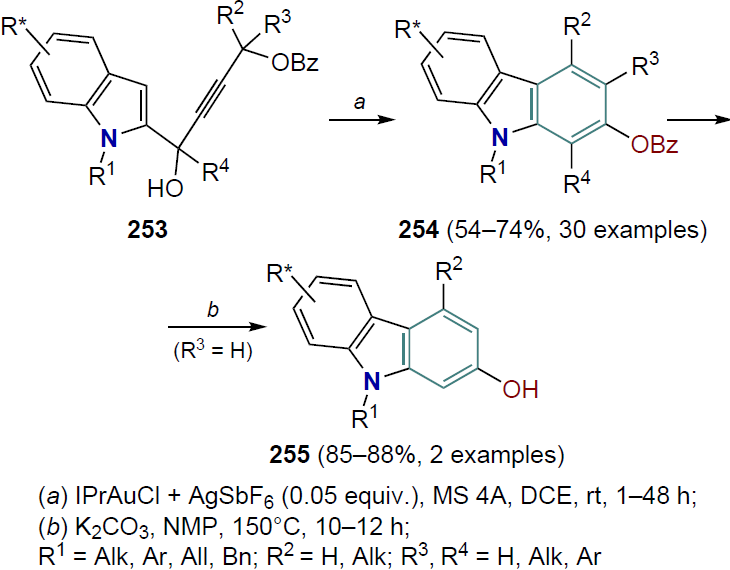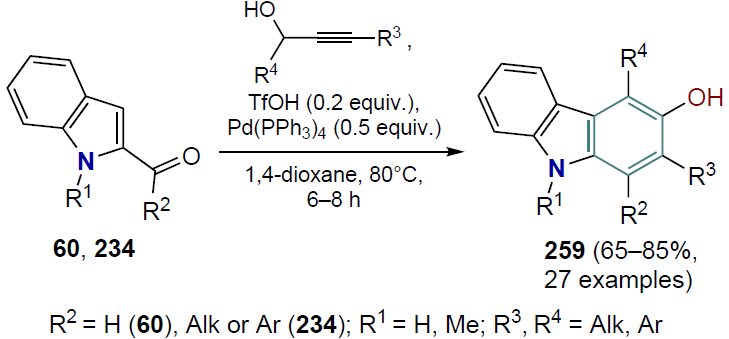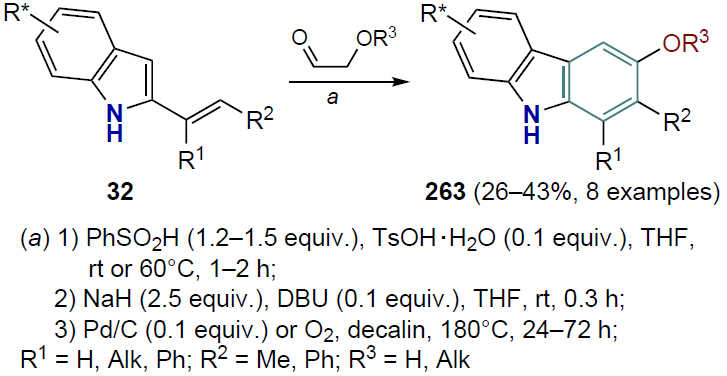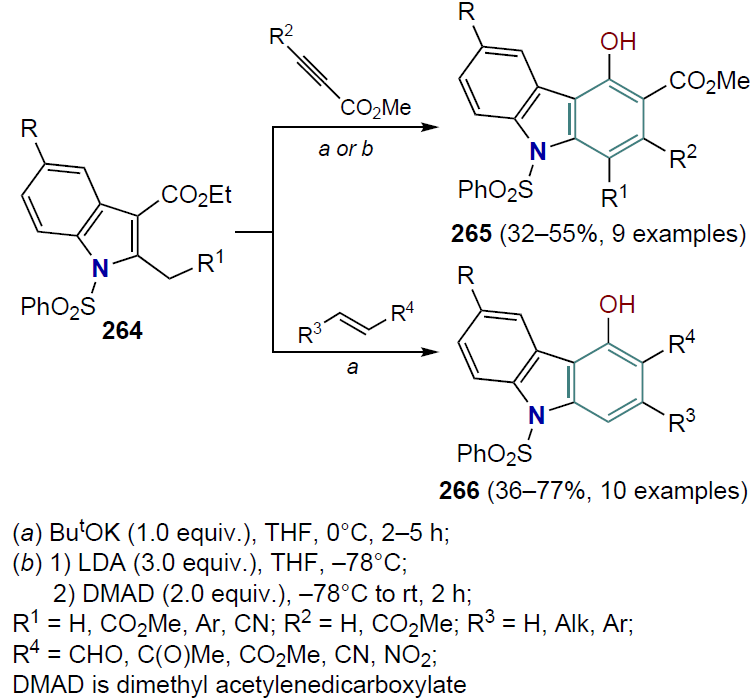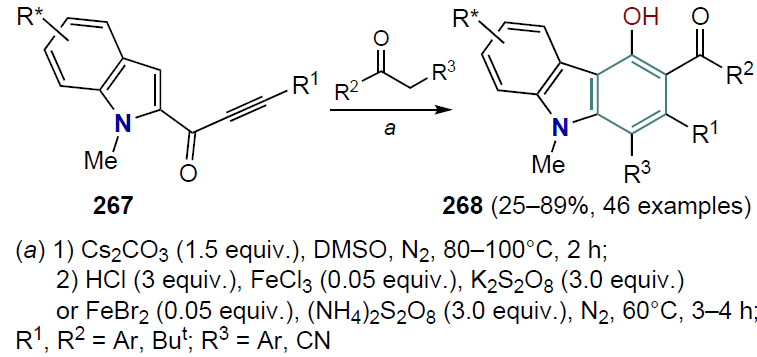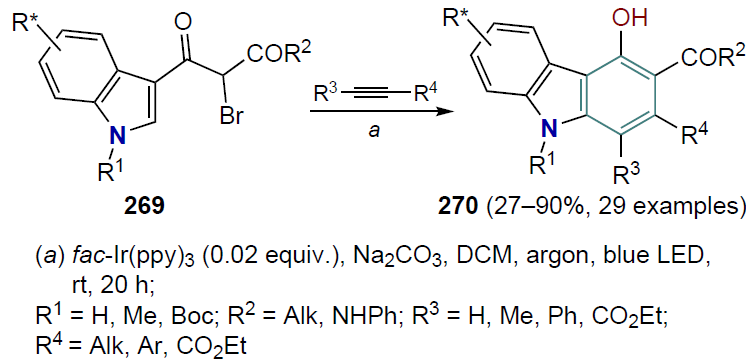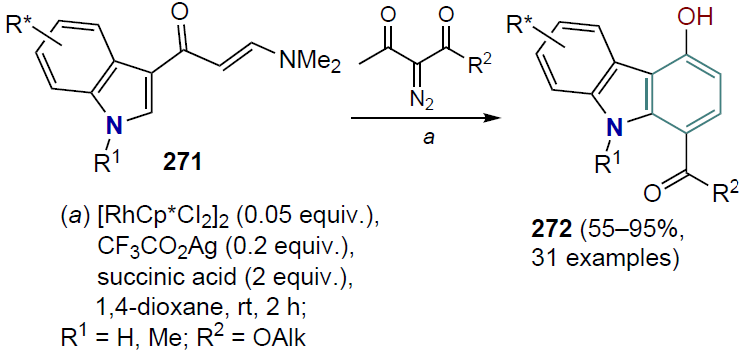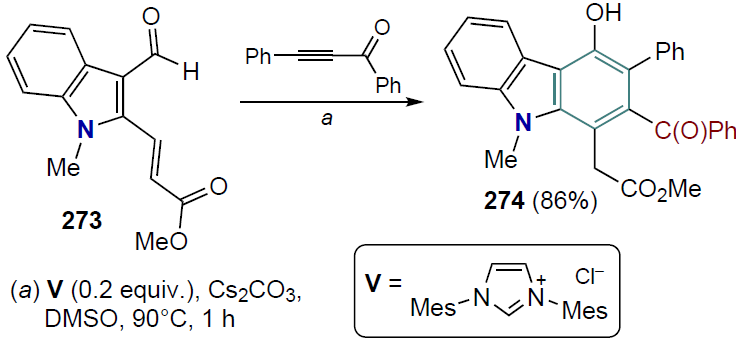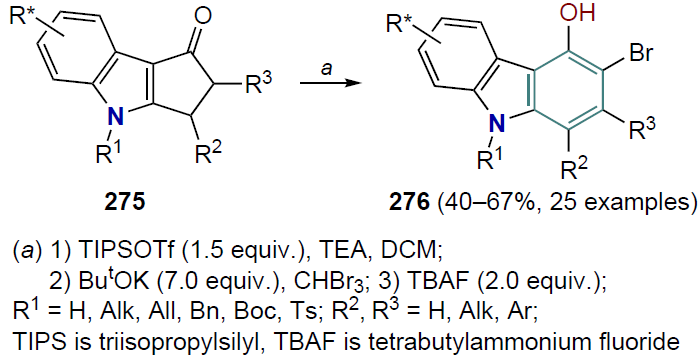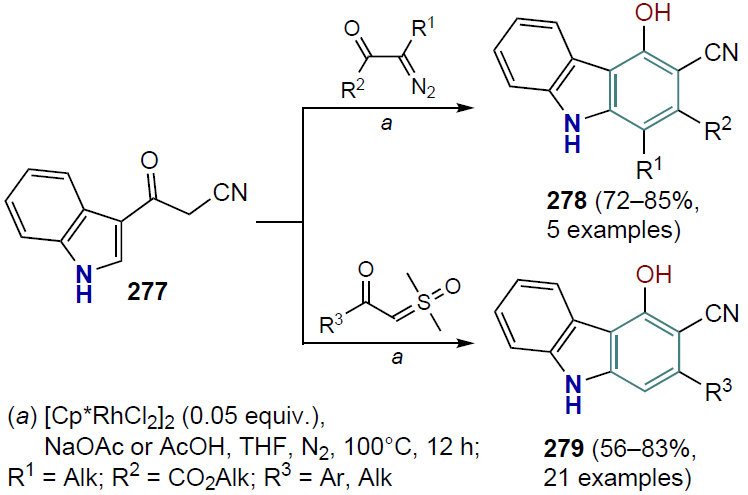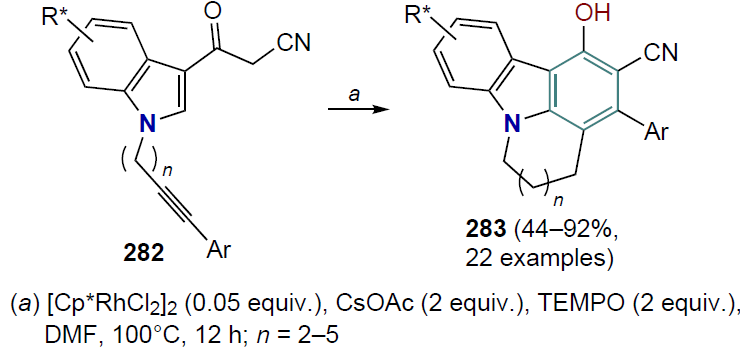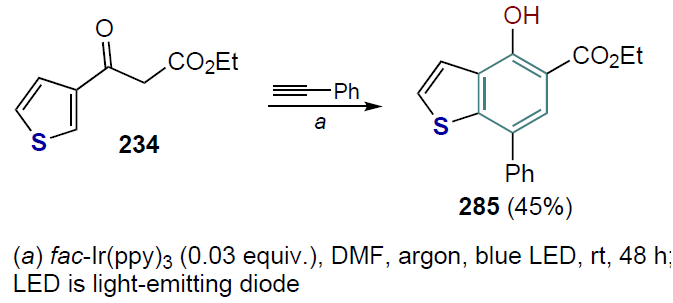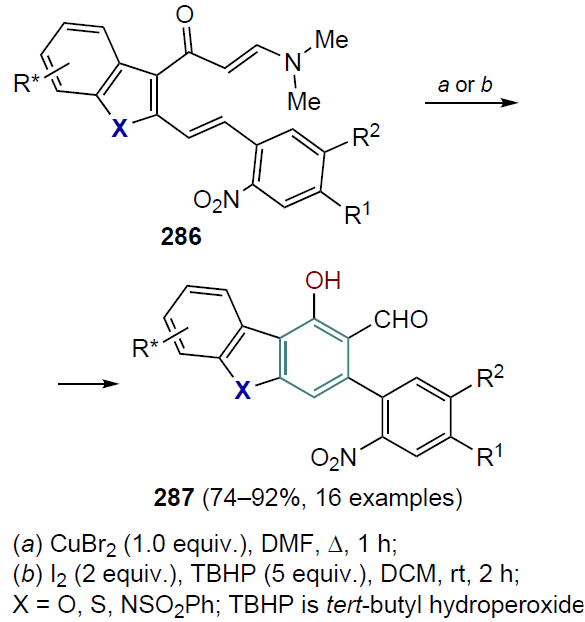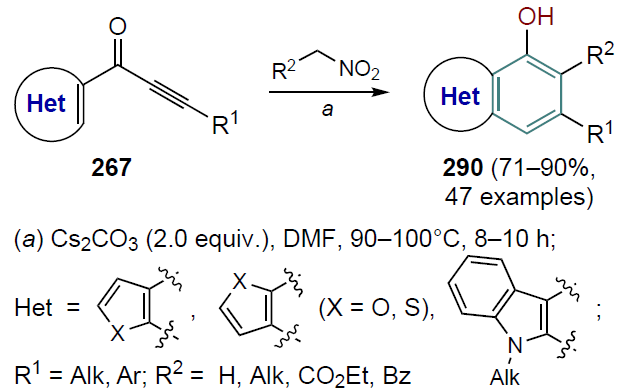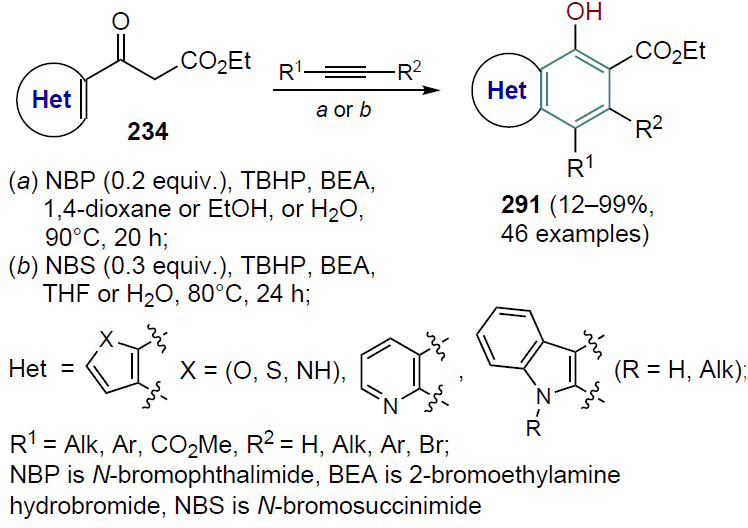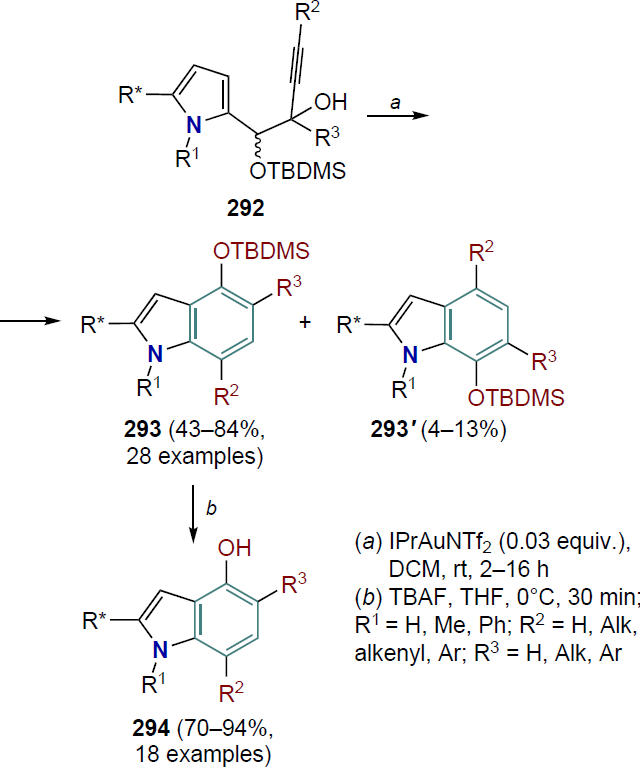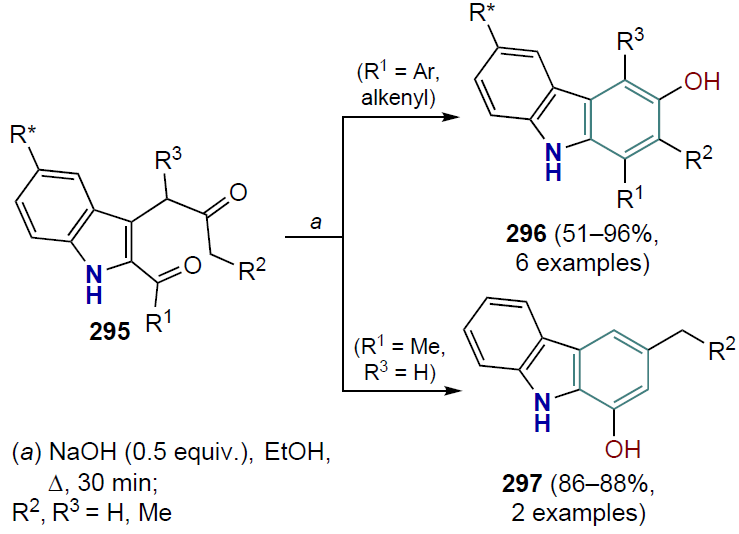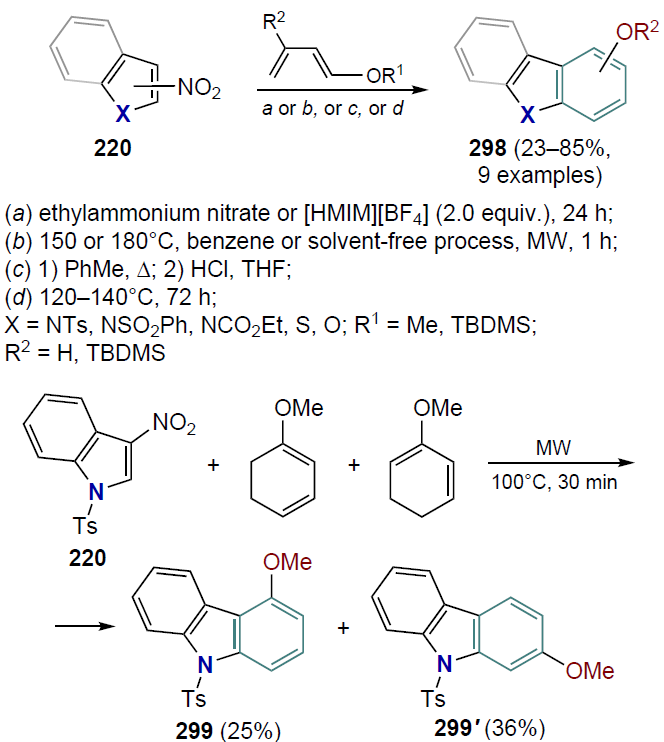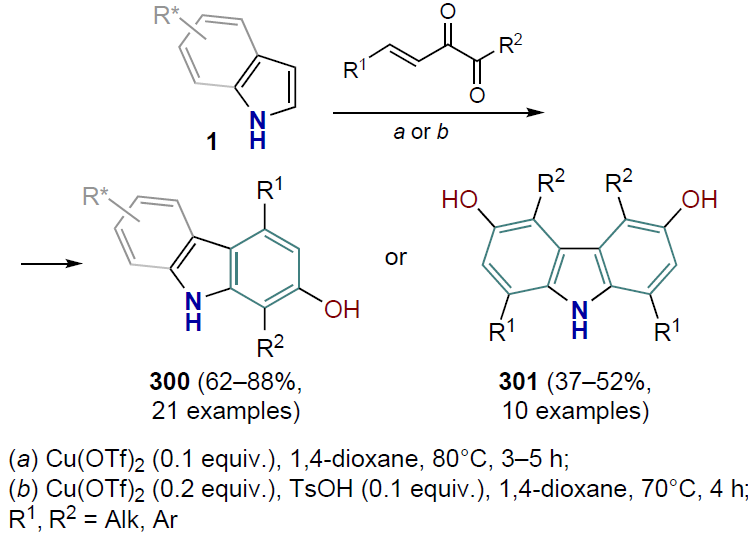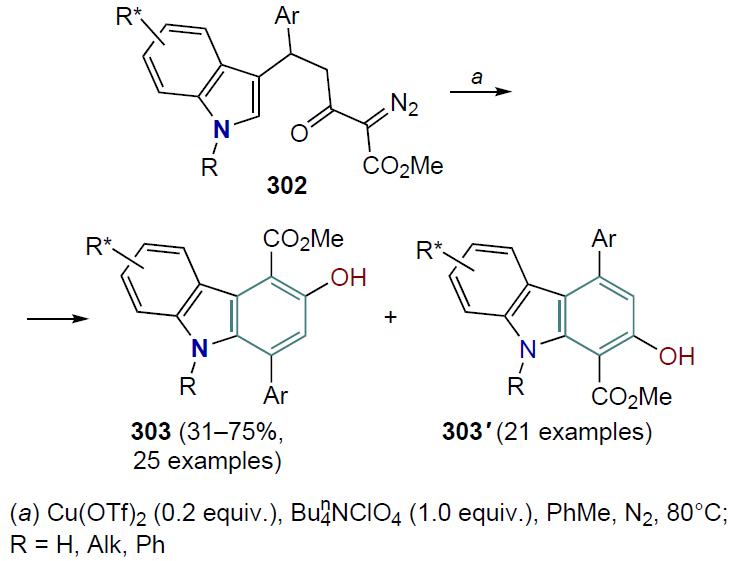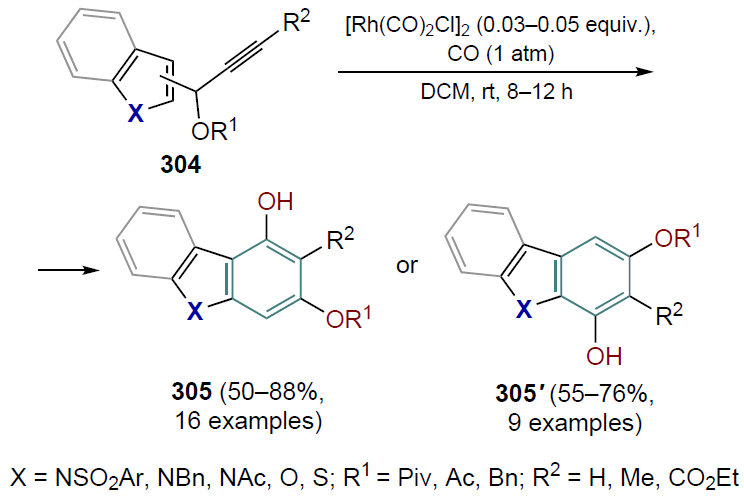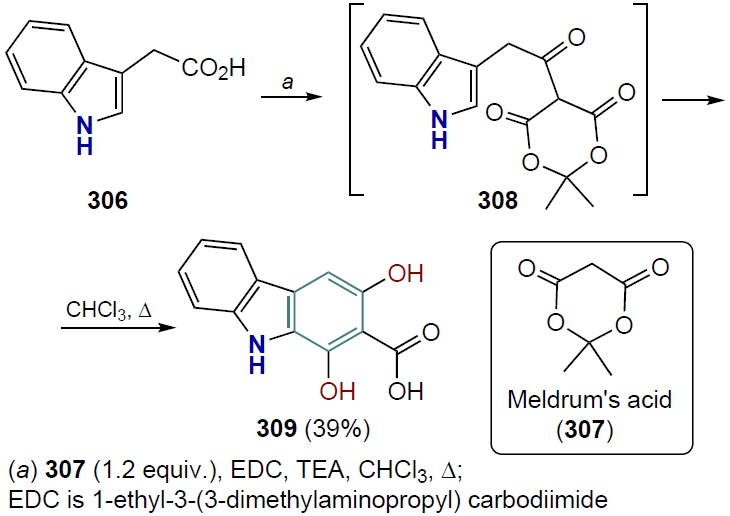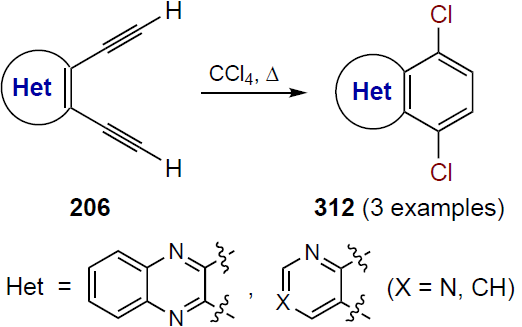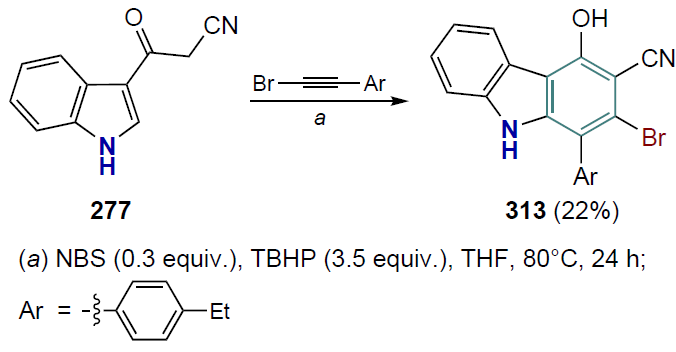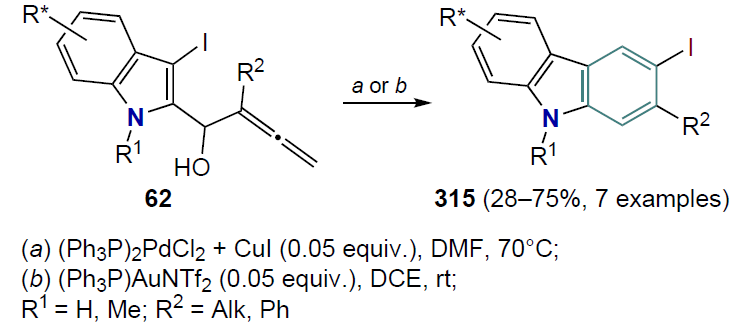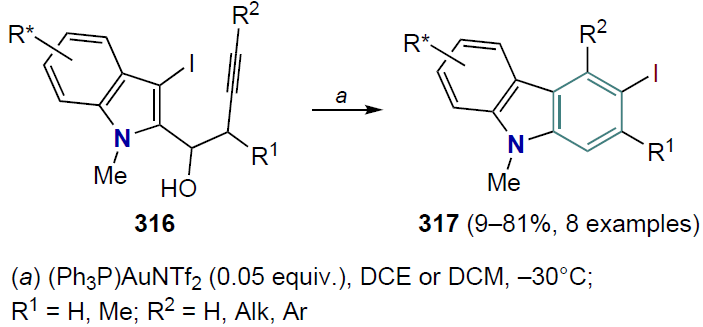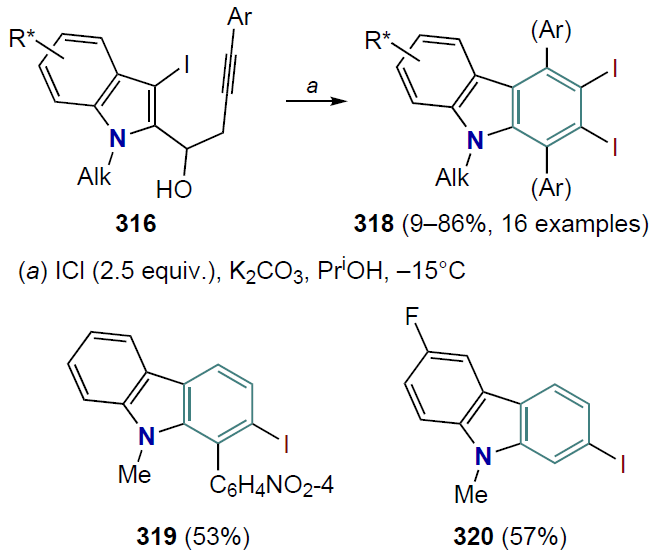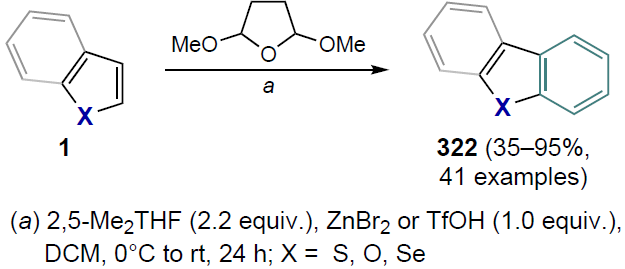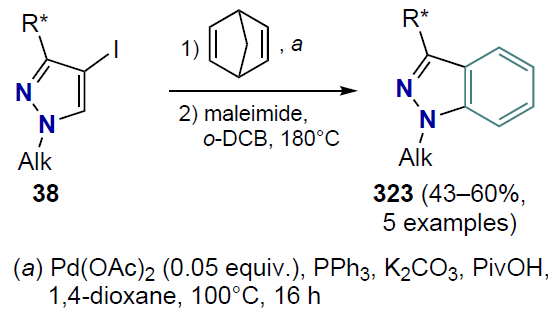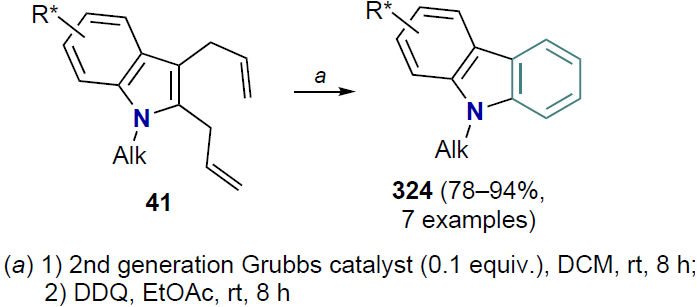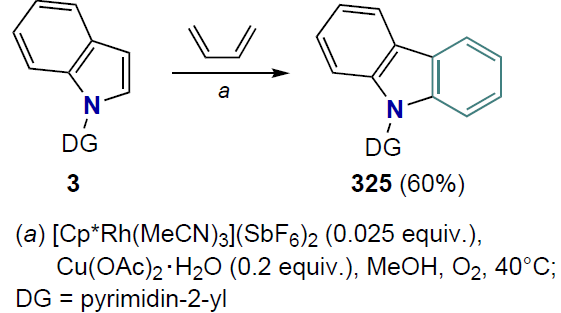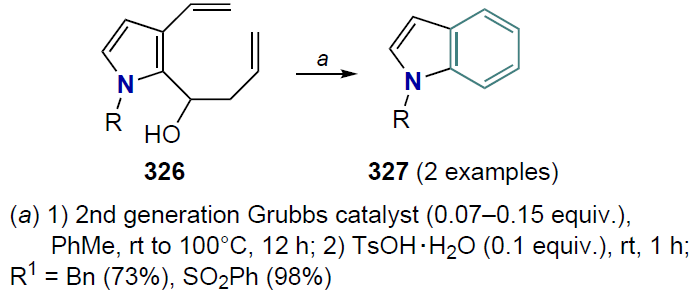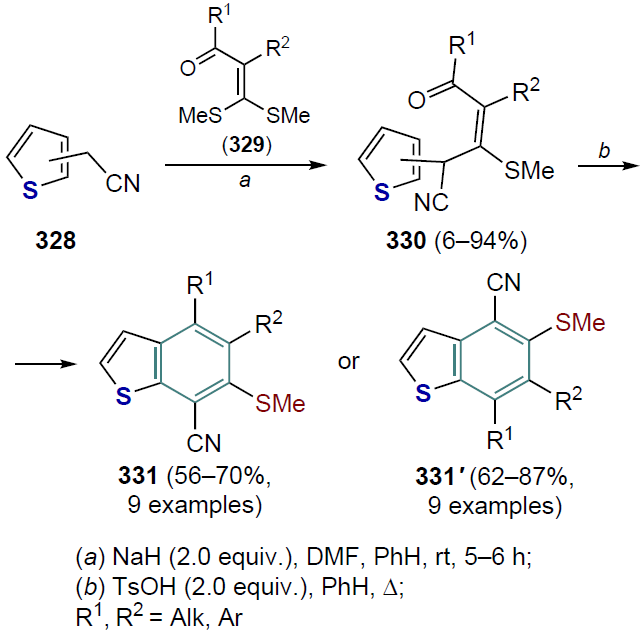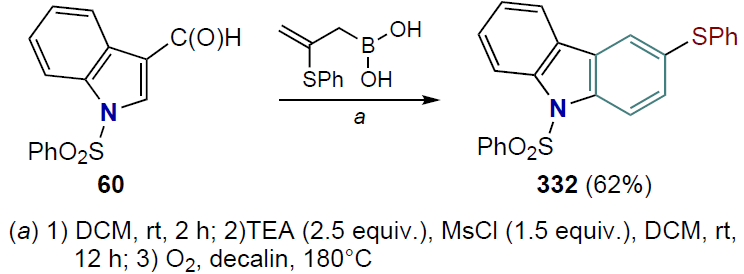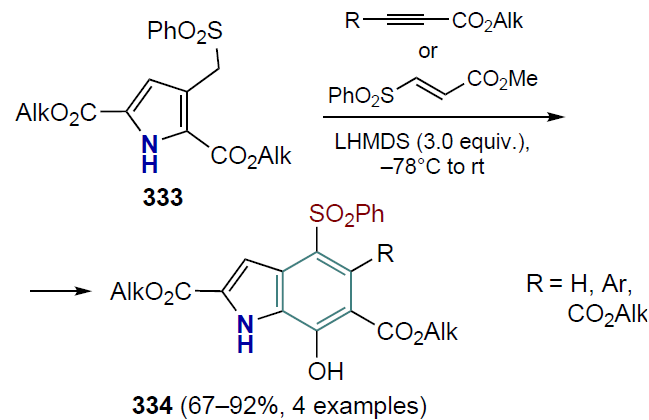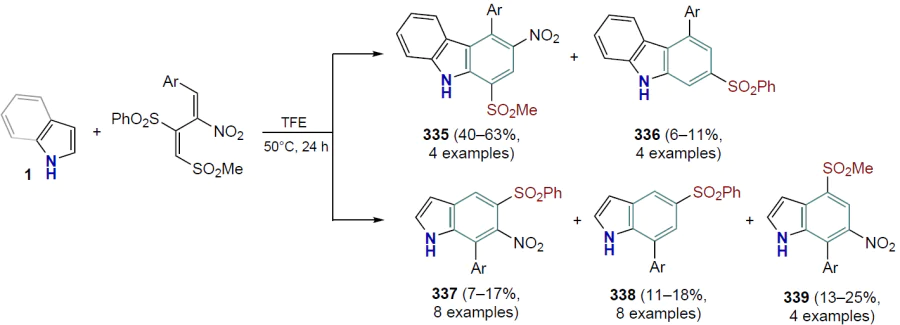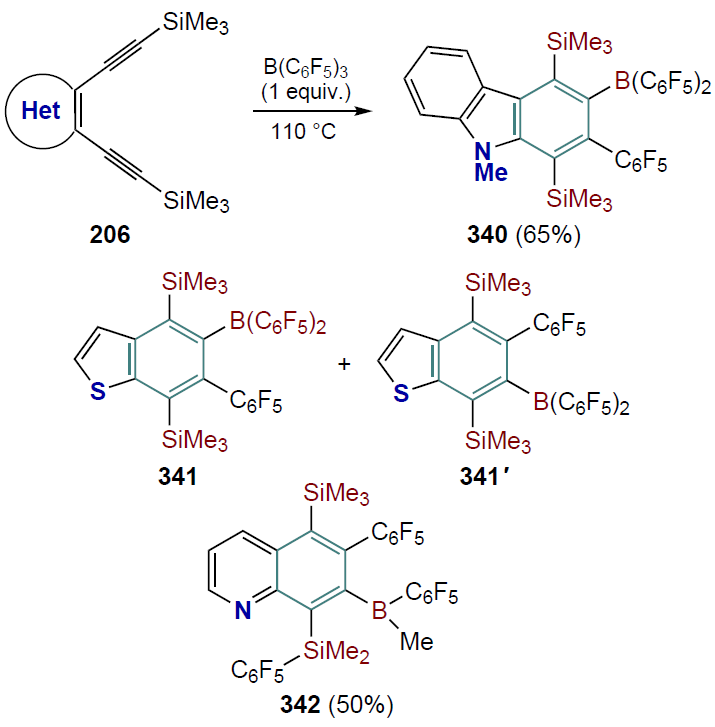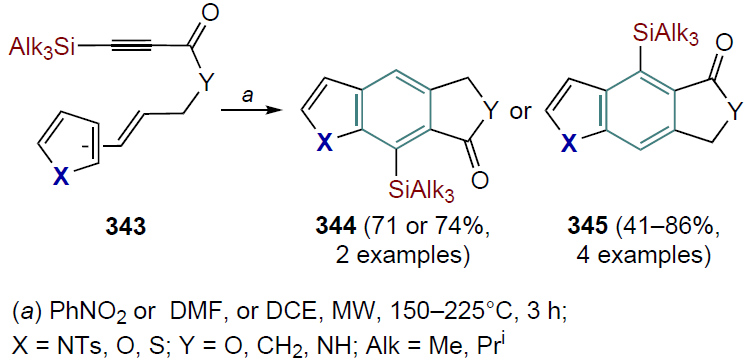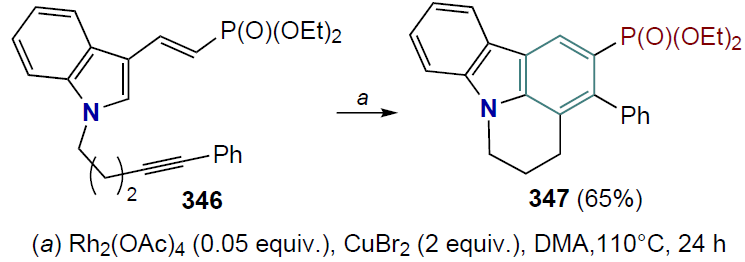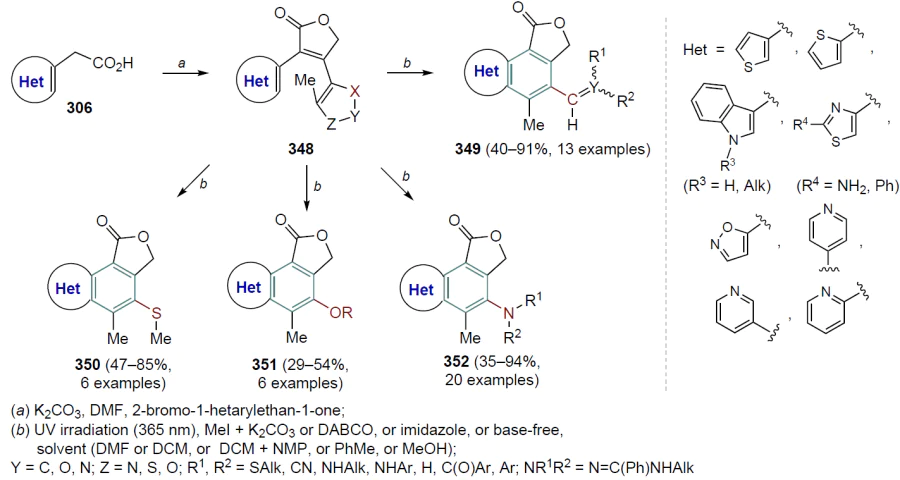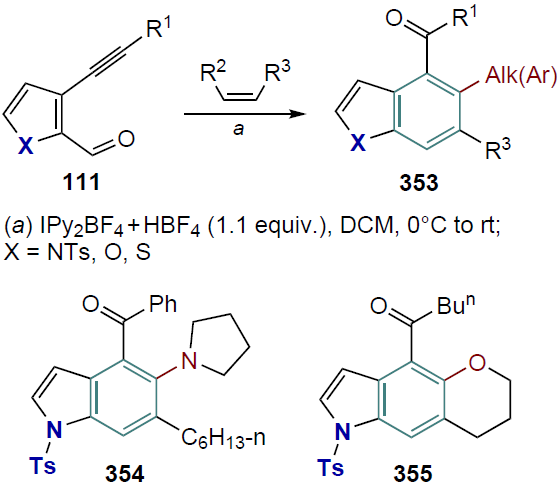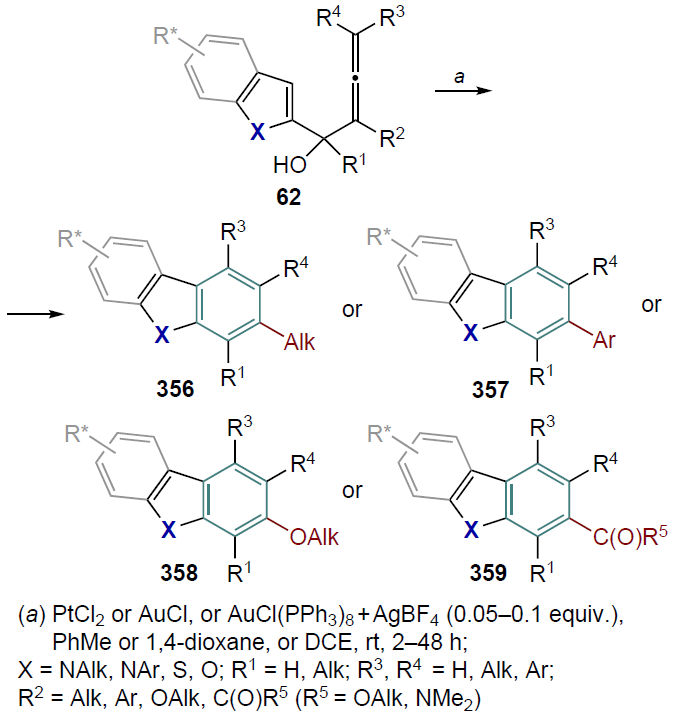Keywords
Abstract
Benzoannulated aromatic heterocycles (BAHs), also known as benzoheterocycles, are key building blocks in the development of functional materials and pharmaceuticals. They are involved in a variety of biochemical processes in nature. The prevalence and widespread use of these molecules stimulates the chemical community's ongoing interest in developing methods to construct carbazole, indole, quinoline, isoquinoline and benzo[b]thiophene motifs. The most common strategy for preparing them is the heteroannulation of functionalized benzene derivatives. Over the last two decades, an alternative approach based on the annulation of heterocyclic derivatives has been developed: benzoannulation, also known as benzannulation. Compared to classical heteroannulation, this approach has several advantages and has led to significant progress in the availability of a variety of benzoheterocycles in recent years. This review is the first to analyze the development of benzoannulation methods for aromatic heterocycles in the 21st century. We highlight the advantages of the benzoannulation strategy, including the versatility of the methods, the availability of starting compounds and the ability to obtain products with specified substituents in the benzene ring. This review aims to help chemists with the synthesis of benzoheterocycles of a specific structure for various applications, ranging from the design of biologically active compounds and the synthesis of natural products to materials chemistry.
The bibliography includes 298 references.
1. Introduction
Benzoannulated aromatic heterocycles (BAH) are condensed bi- and polycyclic aromatic systems consisting of one heterocyclic and one or two benzene units. The most common representatives of such compounds include indole, carbazole, benzo[b]thiophene, dibenzofuran, quinoline, isoquinoline, acridine, etc. (Fig. 1a). Benzo-fused heterocycles are frequently found in the structures of natural compounds. The tricyclic core of carbazole, for example, appear in many natural alkaloids isolated from plants,[1][2] indole derivatives are found in marine organisms (sponges, shellfish, algae, etc.[3]), benzothiazole alkaloids are found in some plants,[4] dibenzofuran derivatives are mainly found in lichens and ascomycetes,[5] and most quinoline and isoquinoline alkaloids are secondary plant metabolites from various families.[6] The total synthesis of natural alkaloids based on benzoheterocycles (primarily carbazole [7-10] and indole [11-13]) is one of the most notable areas of organic synthesis.
The synthesis of heterocyclic compounds with specified properties is a major challenge in modern organic chemistry.[14-22] Heterocyclic moieties are widely used in the design of innovative materials for various fields of science and technology,[23-28] and are also found in biologically active compounds and drugs.[29-34] According to the US Food and Drug Administration (FDA), around 20% of drugs approved in the last 10 years contain BAH motifs in their structure.[35-39] Some examples are shown in Fig. 1c. Bazedoxifene, for example, is an indole derivative used to treat the negative effects of menopause. The drug Flutemetamol F-18 contains a benzothiazole moiety and is used to diagnose Alzheimer’s disease. Tafamidis, a benzothiazole-based drug, is used to treat transthyretin amyloidosis. Triclabendazole, which contains a benzimidazole moiety, is recommended as an anthelmintic drug for fascioliasis. The benzamidazole derivatives Selumetinib and Maribavir are used to treat children with nervous system diseases and to control post-transplant cytomegalovirus infection, respectively.
Some drugs comprise two or more BAH scaffolds. For example, Belumosudil, a selective ROCK2 inhibitor, contains indazole and quinazoline moieties and is used to treat complications after stem cell or bone marrow transplantation. Brexpiprazole, which is based on benzothiophene and quinoline, is an atypical antipsychotic agent. In all of the above examples, the benzene ring in the BAH moiety is functionalized with various substituents, such as hydroxy, carboxyl, amino groups or halogen atoms.
There are two main strategies for synthesizing BAHs (Scheme 1): heteroannulation (a heterocycle is formed on the basis of benzene derivatives) and benzoannulation (a benzene ring is assembled from substituents of the heterocycle, also known as the ‘back-to-front’ approach.[40][41] Almost all classical methods are based on the heteroannulation of benzene derivatives. Previously, many methods were developed for obtaining indoles,[42-47] carbazoles,[48][49] benzo[b]furans,[50] benzo[b]thiophens [51] and other classes of BAHs [52] which have proven highly effective. However, towards the end of the 20th century, researchers became interested in an alternative approach to BAH synthesis, viz., the benzoannulation of heterocycles. Compared to the traditional method, this approach has several advantages, including greater potential for substrate pre-functionalization and the ability to produce compounds with specific substituents in the benzene ring. This is due to the lower aromaticity and higher reactivity of heteroaromatic compounds. In general, heterocyclic moieties are easier and more convenient to functionalize than benzene rings. This has led to significant progress in the availability and application of various BAHs.
Since the beginning of the 21st century, there has been a clear interest within the chemical community in developing methods for the benzoannulation of aromatic heterocycles as a more convenient alternative to the traditional approach. In recent years, several reviews have been published on the synthesis of indoles [53] and carbazoles.[54][55] Significantly more works have analyzed all possible methods for synthesizing BAHs, regardless of the production strategy, including indoles,[56-58] carbazoles,[59-62] benzothiophenes,[63] quinolines,[64][65] and others.[66][67] To the best of our knowledge, there is no review in the current literature that summarizes the strategies for the benzoannulation of all known aromatic heterocycles.
This paper is the first to cover methods of creating benzene rings for various classes of aromatic heterocycles that have been developed since 2000. Examples of recently introduced drugs (see Fig. 1c) demonstrate that the presence of substituents in the benzene ring is crucial for the manifestation of the necessary biological activity of the compound. Therefore, rather than considering benzoannulation methods from the perspective of cyclization types and benzene moiety construction, as is done in many previously published reviews, this paper considers them in terms of the nature and position of substituents in the resulting benzene ring. To unify the position of substituents, carbon atom in all BAGs are designated as C1 – C4 (see Fig. 1b). Our proposed analysis of methods may be useful for developing approaches to obtaining bi- and tricyclic fused heterocycles containing O-, S-, C- and N-substituents in specific positions on the resulting benzene ring.
2. Benzoheterocycles with hydrocarbon substituents
[]
2.1. Alkyl-, alkenyl- and alkynyl-substituted heterocycles
This Section discusses synthetic approaches to heterocycles that contain alkyl, alkenyl or alkynyl substituents in the benzene ring. Scheme 2, Scheme 3 and Scheme 4 illustrate the reactions used to produce alkyl-substituted indoles and carbazoles. Products 2,* which have methyl groups at positions C1 and C4, are formed by the annulation of 2,3-unsubstituted indole and pyrrole (compound 1) with either hexane-2,5-dione [68] or hexane-2,5-diol (see Scheme 2).[69]
These reactions are completed in a relatively short time in good yields under microwave (MW) activation in the presence of the acidic mineral K10 montmorillonite. The first modification of this method, namely, benzoannulation with hexane-2,5-dione, tolerates various substituents, including phenyl and alkyl groups, at the pyrrole or indole nitrogen atoms.[68] The second modification is only described for unsubstituted and methyl-substituted indoles.[69] Subsequently, it was demonstrated [70] that this approach is also suitable for preparing aryl- and ester-substituted carbazoles (see, e.g., Scheme 32).
The synthesis of carbazoles 4, annulated with saturated carbocyclic and heterocyclic rings at positions C2 and C3, was carried out via a manganese(I)-catalyzed reaction of 2,3-unsubstituted indole-3-derivatives with 1,6-diene (see Scheme 3 **).[71] In this case, the presence of a directing group (pyridin-2-yl) is necessary at the nitrogen atom of the heterocycle. Using this method, a large number of the corresponding products was synthesized, achieving yields ranging from 23% to 79%.
N-substituted carbazoles 6 bearing alkyl groups at the C1 and C2 positions were obtained from (indol-3-yl)pentin-3-ols 5 by acid-catalyzed cyclization of propargyl alcohols in 77 – 91% yields (see Scheme 4).[72] This method allows variation in the C2-alkyl substituent.
Introducing an additional vinyl group into compound 5 (to give compound 7) opens an access to carbazoles 8 with an alkenyl substituent at the C1 position (Scheme 5).[73] The yields of the products are 65 – 80%. The reaction produces isomeric carbazoles 8' and azepine 9 as minor by-products.
The synthesis of indoles and carbazoles 11 with an alkenyl-functionalized C4 position of the benzene ring was carried out through the intramolecular metathesis of enyne 10, catalyzed by the Grubbs first-generation catalyst, followed by dehydration (Scheme 6).*** [74-80] This method requires the presence of arylsulfonyl substituents at the nitrogen atom and allows to obtain products bearing additional substituents at positions C1 – C3 in yields ranging from 59% to 99%.
Alkynylated indoles, carbazoles and thieno[3,2-b]indoles 13, 13' were obtained via the platinum(II) bromide-catalyzed cyclization of 1-hetarylbut-3-in-1-ol derivatives 12 in the presence of the benziodoxol derivative I (Scheme 7).[81] The alkynyl substituent can be located at position C2 or C3, depending on the structure of the starting heterocycle. For a number of 2-substituted substrates with aromatic substituents at the triple bond, the simultaneous formation of C2- and C3-substituted BAHs was observed, with the C3-substituted BAHs predominating. The yields of the products of this reaction for most substrates are good, reaching 84%. The possibility of desilylation while forming the ethynyl substituent was demonstrated.
Photorearrangements of 1,2-diarylethenes 14 under inert conditions can be used to access benzo[b]thiophenes, benzo[b]furans and indoles with different alkyl and alkenyl substituents (Scheme 8). These reactions proceed through a UV-induced 6π-electrocyclization step. Depending on the structure of the substrates (i.e. the nature of the substituents in the benzene ring) and the conditions (i.e. the presence of an acid), BAHs substituted with butadienyl (15),[82][83] or alkenyl (16) [83] groups are formed, as well as products (17) with a cyclohexanone moiety annulated at the C1, C2 or C3, C4 atoms.[84]
In a related process involving the furan ring-opening in substrates 18 in the presence of a base and a reducing agent, BAHs 19 with a C3-hydroxyethyl group were obtained (Scheme 9).[85]
* In this review, the compounds are numbered according to their position in the Schemes, from substrate to product. Light grey fragments and dotted lines indicate their potential presence in the molecule.
** The symbol R* denotes heterocyclic substituents that do not significantly affect substrate reactivity during benzoannulation. No definition is provided for these substituents.
*** Examples of the preparation of alkenyl-substitute BAHs are also given in other Sections (the position of the alkenyl group within the benzene ring is indicated): these include C3-substituted carbazoles (Scheme 17),[75] C1-substituted indoles (Scheme 46),[76] C2- or C3 substituted carbazoles (Scheme 117 [77] and Scheme 56 [78]), C1-substituted indoles (Scheme 173) [79] and C1-substituted carbazole (Scheme 174).[80]
2.2. Aryl-substituted heterocycles
The synthesis of BAHs with one or two aryl substituents in the benzene ring has been reported in the literature. For example, the gold(I)-catalyzed cyclization of homopropargyl ethers 12 derived from a variety of 2-substituted heterocycles (e.g. furan, benzo[b]furan, thiophene and benzo[b]thiophene), affords compounds 20 with various aryl substituents at position C1, with yields ranging from 45% to 99% (Scheme 10).[86][87] Interestingly, the cyclization of both 2- and 3-substituted indoles gives C4-substituted carbazoles 20'. In the case of one of the benzo[b]thiophene-based substrates, two isomeric (at the C1 or C4 positions) products were isolated in equal amounts.
2-Substituted carbazoles 22 were obtained by the cyclization of 2-fluoro-3-(indole-3-yl)propanones 21 in the presence of trifluoroacetic anhydride (TFAA) (Scheme 11).[88] The target compounds containing benzene (including those bearing electron-donating groups), naphthalene, and benzo[b]furan moieties as aromatic substituents were obtained in high yields.
1,3-Diarylcarbazoles 23 were synthesized from 2,3-unsubstituted indoles 1 and β-formylketones in the presence of a catalytic amount of molecular iodine (Scheme 12).[89] This method produces carbazoles in yields ranging from 28% to 83%.
The synthesis of BAHs containing a 1,4-diaryl-substituted benzene moiety can be accomplished in two different ways. The first approach involves a three-step transformation of thiophene-2-carboxylates 24 into benzo[b]thiophenes 25 (Scheme 13). This process includes SmI2-promoted electrophilic substitution reactions, dehydration in an acidic medium and 6π-electrocyclization of the hexatriene system, followed by oxidation by DDQ.[90] The C1 and C4 aromatic substituents can be the identical or different derivatives of benzene and thiophene. The product yield over three steps ranges from 27% to 54%. The same method provides an access to benzothiophenes with tetrasubstituted benzene ring (31 – 44%).
The synthetic approach to C1,C4-diaryl-substituted indoles 27 is based on the acid-catalyzed rearrangement of 1,4-diaryl-1,4-dipyrrolylbutynes 26 (Scheme 14).[91] This reaction was performed with substrate loadings of dozens of milligrams, with yields ranging from 31% to 84%, and its high efficiency has been proven by NMR monitoring.
A method for the synthesis of carbazoles 28 with C2 and C4 aryl substituents, based on the aerobic reaction of 2,3-disubstituted indoles with α-bromoacetophenone derivatives in the presence of DMAP (Scheme 15).[92] This method delivers carbazoles 28 bearing electron-donating or electron-withdrawing substituents rapidly and regioselectively, with yields ranging from 68% to 79%.
Target carbazoles 29 were obtained from 2,3-unsubstituted indoles and arylacetylenes using rhodium(III) [93] or manganese(I) catalysts (Scheme 16).[94] The first case implies a much broader range of substrates and higher yields (31 – 89% vs. 14 – 29%). Substituted benzenes (including those with electron-deficient substituents) and thiophene derivatives can act as aromatic substituents. Both methods require the presence of the directing pyrimidyl substituent in the indole, which can be removed by base in an acceptable yield.
Di- and triaryl-substituted carbazoles 31 were obtained by reacting 2-carbonyl-3-proparagylindoles 30 with arylboronic acids (Scheme 17).[75] This reaction, carried out in a one-pot fashion, involves sequential steps of palladium(0)-catalyzed hydroarylation of the triple bond and acid-catalyzed cyclization. Carbazoles with C3, C4-diaryl and C1, C3, C4-triaryl-substituted benzene rings were obtained. The yields of the corresponding products ranged from 50% to 80%. Benzene and thiophene derivatives were used as aromatic substituents.
Carbazoles with C1-, C2- and C4-triaryl-substituted benzene rings are accessible through two different approaches. A one-pot variant of acid-catalyzed annulation involving intramolecular nucleophilic addition to phenylglyoxal derivatives, substitution and cyclization was developed starting from 3-vinylindoles 32 (Scheme 18).[95] Ninety-five Brønsted acids based on phosphoric acid were employed as catalysts, while benzene and indole derivatives served as aromatic substituents. The yields of carbazoles 33 ranged from 42% to 88%.
Triaryl-substituted carbazoles 35 were synthesized from indolylmethanol 34 and propargyl alcohols in the presence of a Lewis acid catalyst (Scheme 19).[96] This cascade reaction involves the indole allenylation, a [1,5]-hydride shift or 6π-electrocyclization, and the Wagner – Meerwein rearrangement. Various benzene derivatives were used as aryl substituents, and the product yields ranged from 30% to 81%.
Tetraaryl-substituted BAHs 37 were obtained via palladium(II)-catalyzed aerobic annulation of 2,3-unsubstituted furans or pyrroles 36 containing electron-withdrawing substituents, with diarylalkynes (Scheme 20).[97] The target benzo[b]furans and indoles were isolated in yields ranging from 9% to 84%.
2.3. Alkyl- or aryl-substituted heterocycles
This Section highlights synthetic approaches to benzoannulated heterocycles, enabling products with both alkyl and aryl substituents in the resulting aromatic moiety. The material is organized according to the degree of increase in the number of such groups, ranging from monosubstituted to tetrasubstituted.
Monosubstituted benzoannullated heterocycles can be synthesized in three ways. A series of C1-substituted compounds 40 (benzothiophenes, dibenzothiophenes and indazoles, as well as individual representatives of the indole, carbazole and benzofuran families) were obtained in two steps from the corresponding halogenated heterocycles 38 via norbornene-substituted intermediates 39 (Scheme 21).[98] Both steps are based on palladium(II)-catalyzed coupling and annulation reactions. The product yields at these steps range from acceptable to high. The method was tested using benzothiophenes containing a variety of aromatic and aliphatic substituents at the C1 position.
The synthesis of BAHs with aryl or alkyl substituents at the C4 position can be carried out in two ways. Reactions involving the metathesis of 2,3-diallylindoles 41, followed by oxidation deliver carbazoles 42 with a methyl or phenyl substituent at the C4 atom (one example involving a C3-tethered methyl group is also known) (Scheme 22).[99] The yields over the two stages ranged from 61% to 95%. Effective debenzylation of the protected nitrogen atom was demonstrated for these compounds.
Carbazoles 44 with a C4 substituent in the benzene ring are obtained by the gold(I)-catalyzed intramolecular hydroarylation of (Z)-2-(enynyl)indoles 43 (Scheme 23).[100] Most examples used alkyl substituents, but one example of a p-tolyl-substituted carbazole has been described. The product yields were in the range of 50 – 83%.
Benzoheterocycles with two substituents (aryl and/or alkyl) in the benzene ring can also be obtained in several ways. For example, carbazoles substituted at the C1 and C2 positions were synthesized by the reaction of 3-(2-hydroxyethyl)indoles (tryptophol, 45) with propargyl alcohols in the presence of boron trifluoride etherate in 57 – 90% yields (Scheme 24).[101] Products 46 contain a C1-aryl group at the position and a C2-diarylmethyl group.
The synthesis of carbazoles 47 bearing alkyl and aryl substituents at the C1 and/or C2 positions, via bismuth(III) triflate-catalyzed annulation of 2,3-unsubstituted indoles 1 with acetals of α-bromoacetaldehyde and ketones is described (Scheme 25).[102] Methyl, aromatic, and heteroaromatic groups were used as substituents. The yields of such products ranged from 31% to 86%. In addition, cyclic ketones and 1,3-dicarbonyl compounds were used in the reaction to give carbazoles annulated with carbocyclic rings (yields 75 – 86%).
Carbazoles 49, substituted at the C1 or C1 and C3 positions, were obtained by the silver(I) triflate-promoted cyclization of 1-(indol-3-yl)but-3-in-2-ols derivatives 48, which are based on propargyl alcohol (Scheme 26).[103] Products with alkyl, cycloalkyl, aryl and thienyl substituents were isolated in yields ranging from 28% to 99%.
1,3-Disubstituted benzo[b]furans 51 were obtained via a gold(I)-catalyzed cascade reaction of functionalized furans 50 followed by the addition of nucleophiles, such as water, alcohols, aromatic amines and 1,3,5-trimethoxybenzene (Scheme 27).[104] The yields of benzo[b]furans 51 ranged from 58 to 90%.
1,4-Disubstituted indoles and carbazoles 52 were synthesized by a gold(I)-catalyzed [4+2] reaction of 1,3-diynes with 2,3-unsubstituted pyrroles and indoles 1 (Scheme 28).[105] The reaction with symmetrical 1,3-dienes proceeds selectively, whereas in the case of nonsymmetrical substrates, formation of separable regioisomers is possible. The product yields are 11 – 80%.
Carbazoles 53, functionalized with a C1-aryl group and a C4-alkyl group, were synthesized by a one-pot method starting from 2,3-unsubstituted indole 1 and β-nitro-β,γ-unsaturated ketone (Scheme 29).[106] Depending on the structure of the ketone, only C1-aryl-substituted carbazoles can be obtained, with yields ranging from 55% to 78%.
The two-step reaction of sulfonyl-substituted indoles 54 with protected β-nitro ketones gives C4-substituted and С1,С4-disubstituted carbazoles 55 (Scheme 30).[107] The yields of these products are 44 – 68%.
Another approach to carbazoles 57 with alkyl and aryl substituents at the C1 and C4 positions involves the palladium(II)-catalyzed intramolecular annulation of indolyl-substituted diynes 56 (Scheme 31).[108] A cycloalkyl moiety attaches to the C1 position of the products, while the alkyl and aryl substituents can be at the C4 atom, which is determined by the nature of the substrate. The yields of the target carbazoles range from 22% to 91%. One of the products was obtained in gram quantities.
Alkylaryl-substituted carbazoles 58 can also be obtained via benzoannulation of 2,3-unsubstituted indoles 1 with diketones, in the presence of a Lewis acid (Scheme 32).[70] The resulting products always have the C1-alkyl substituent and can have both alkyl and aryl groups at the C4 position, depending on the diketone structure. The yields of the target carbazoles range from 23% to 91%. Synthesis of 1,4,5,8-tetramethyl-9H-carbazole demonstrates the applicability of this method to pyrrole derivatives.
The annulation of 2,3-unsubstituted 1-methylindole with acetophenone and methacrylic acid derivatives produced C1,C4-disubstituted carbazole 59 (Scheme 33).[109]
A three-step, one-pot method has been developed for the benzoannulation of pyrrole and indolecarboxaldehydes 60 with allylboronic acids to furnish C2- or C3-substituted products 61 (Scheme 34).[110] This method provides an access to target compounds with both alkyl (or cycloalkyl) and aromatic (benzene, thiophene, and indole derivatives) substituents. The possibility of preparative (gram-scale) synthesis has also been demonstrated for this protocol, with alkyl- and aryl-substituted indoles and carbazoles being isolated in yields ranging from 44% to 76%.
Carbazoles with a C2-substituted or C2,C3-disubstituted benzene ring are accessible via annulation of indole-tethered allenols 62 (Scheme 35).[111] The palladium(II)-catalyzed reaction using allyl bromides gives carbazoles 63 with C2 and C3 substituents in 53 – 69% yields. The substituents at the C2 atom of the products are methyl or phenyl groups and the substituents at the C3 atom are alkyl moieties. When gold(I) chloride is used as a catalyst instead of a palladium(II) catalyst in the absence of the bromine derivative, C2-substituted carbazoles 64 are obtained (yields 58 – 89%).
C2- and C3-substituted carbazoles can be obtained in two ways. Both routes involve palladium(II) chloride-catalyzed cyclization using different substrates 65 (X = NTs, NBoc) and 66, which contain a vinyl or allyl group, and an acylated hydroxy group in the α-position to the double bond (Scheme 36).[112] Benzothiophenes 65 (X = S) are also involved in this reaction. The yields of carbazoles and dibenzothiophenes 67 are 43 – 83%.
A simple and effective synthetic approach to carbazoles 69 involves treating 2-alkynylindoles with arylacetylenes in the presence of a bimetallic gold(I) – silver(I) catalyst (Scheme 37).[113] The fundamental feature of this strategy is the sequential activation of terminal and internal triple bonds. The versatility of this method was demonstrated on the example of the reaction between various 2-alkynylindoles and arylacetylenes.
Various methods for the synthesis of carbazoles bearing alkyl and aryl substituents in different positions from 1-(indol-2-yl)but-3-in-1-ols 12 have been reported. For example, the gold(III) chloride-catalyzed cyclization of 1-(indol-2-yl)but-3-in-1-ols is described (Scheme 38).[114] This process gives rise to C2,C4-disubstituted carbazoles 70 with alkyl and aryl substituents in 58 – 90% yields.
The cyclization of 1-(indol-2-yl)but-3-in-1-ols 12, catalyzed by gold(I) complexes (such as [Au(MeCN)(JackiePhos)][SbF6] and two specially obtained analogues), can give various carbazoles (Scheme 39).[115] Depending on the substrate, catalyst and solvent used, carbazoles 71 – 74 were obtained, with the benzene ring being substituted at positions C1, C2, C4 or C2, C3 and C4. In the presence of a specially synthesized gold(I) complex based on a sterically hindered phosphine in dichloromethane, cyclobutene-annulated carbazoles 73 were obtained (33 – 87%). When dichloromethane is replaced with toluene, the main products are dimeric ethers 71 (yields 35 – 76%), while replacing it with alcohol, the main products are derivatives 72 (yields 44 – 99%). Using another gold(I) complex as a catalyst produces an inseparable mixture of isomers (yields ranging from 35 to 91%), with the main product being carbazoles 74 and the by-product being carbazoles 74'. C4-aryl groups act as additional substituents in products 71 – 74.
The bis(triflyl)ethylation of the indole ring of indole-2-yl-but-3-in-1-ol 12 with salts 75, followed by treatment with silica gel affords bis(triflyl)ethyl salts of carbazoles 76, in 36 – 56% yields (Scheme 40).[116] The resulting products contain alkyl and aryl groups at the С2, С3 and С4 positions. One example demonstrates that introducing an iodine atom into the 3-position of indole gives rise to a carbazole containing a C1-hydroxy group (37%).
Trialkylaryl-substituted carbazoles are obtained by the cyclization of 1-(indol-3-yl)but-3-in-2-ols 48 in the presence of a gold(I or III) catalyst (Scheme 41).[117] This method produces mixtures of isomers 77 and 77'. The selectivity of the reaction depends on the nature of both the catalyst and substrate. In some cases, it is possible to obtain one of the isomers with good selectivity. The product yields vary from 48% to 90%.
The gold(III)-catalyzed cycloisomerization of related indoles 48 and pyrroles 79 delivers carbazoles 78 (Refs [118] and [119]) and indoles 80 (see Ref. [119]) (Scheme 42). Introducing two propargyl alcohol moieties into the pyrrole molecule enabled a rare example of double benzoannulation to afford carbazoles. Using indoles as substrates, carbazoles 78 with substituents at positions C1, C2 and C4 are obtained (61 – 96%), whereas the reaction with pyrroles gives products 80 with substituents at positions C1, C3 and C4 (44 – 95%). The resulting benzene ring contains alkyl and (het)aryl substituents.
Catalysis with palladium(II) acetate promotes cyclization of indole derivatives 81 tethered with a bis(homoallylic) alcohol moiety. This produces compounds 82 (yields up to 81%), which undergo aromatization to give carbazoles 83 with substituents at positions C1, C3 and C4 (R1 ≠ H) (Scheme 43).[120] Two carbazoles were obtained using this method, but it was primarily used for the synthesis of naphthalene derivatives.
Carbazoles and indoles 84, which have different alkyl and aryl substituents at the C2, C3 and C4 positions, can be obtained via a rhodium(III)-catalyzed reaction between 2,3-unsubstituted substrates and 1,3-dienes (Scheme 44).[121] This method requires the use of nitrogen-containing directing groups at the nitrogen atom of the annulated N-heterocycle. Product yields range from 15% to 88%.
A method based on the annulation of 3-iodo-2-cinnamylindole 85 with alkynes, in the presence of palladium(II) acetate, has been proposed (Scheme 45).[122] Carbazoles 86, substituted with alkyl and aryl groups at positions C2, C3 and C4, were obtained in 33 – 91% yields. The reaction with unsymmetrical alkynes delivers mixtures of regioisomers.
Indoles 87 were synthesized by the rhodium(II)-catalyzed reaction of 2,3-unsubstituted pyrroles with pyridazine N-oxides (Scheme 46).[76] The use of various pyridazine N-oxides gave rise to a series of C1-substituted aryl- and alkylindoles, as well as products bearing additional alkyl groups at the C2 and C3 positions.
Several examples of the synthesis of BAHs containing the substituted benzene ring have been reported. For example, the annulation of 2,3-unsubstituted indoles 1 with ketones and nitroalkynes, promoted by NH4I, gives selectively polysubstituted carbazoles 88 (Scheme 47).[123] The reaction products bear alkyl and aryl groups in various positions, and are isolated in yields ranging from 46 to 95%.
Carbazoles 89 were obtained from 2,3-unsubstituted indoles 1 and cyclic α-hydroxysilylenol ethers tethered with a vinyl group at the α-position, via treatment with camphorsulfonic acid (CSA) (Scheme 48).[124] Such products are annulated with carbocycles at positions 1 and 2 and may contain alkyl or aryl groups at positions 3 and 4.
Carbazoles bearing two, three or four substituents were obtained by the reaction of pyrroles [125] or indoles [126] with 1-vinylpropargyl alcohols 90, in the presence of a ruthenium(0) complex II and trifluoroacetic acid (Scheme 49). The reaction produces a mixture of two isomeric products (91 and 91'), which can be separated by column chromatography. The regioselective formation of substituted carbazoles was demonstrated in a number of cases, with yields ranging from low to high (5 – 92%).
Alkyl- and aryl-substituted indoles 93 with one to three substituents were obtained by metathesis of substrates 92 in the presence of Grubbs second-generation catalyst (yields 66 – 99%, Scheme 50).[127] This method can also be implemented to synthesize carbazole 95 via double benzoannulation of pyrrole 94.
Disubstituted alkynes are widely used in the synthesis of BAHs with four aryl and/or alkyl substituents in the resulting benzene ring. For example, the palladium(II) acetate-catalyzed oxidative annulation of indole-3-carboxylic acids 96 with internal alkynes gives carbazoles 97 in 21 – 98% yields (see Scheme 51).[128] In addition to carbazoles, this method has been used to obtain substituted indoles, benzo[b]furan and dibenzofuran.
In a follow-up study,[129] the conditions were modified to enable the use of 2,3-unsubstituted substrates in the reaction, which gave carbazole via double annulation of pyrrole. Benzo[c]thiophenes 99 were obtained by rhodium(III)-catalyzed annulation of thiophene-2-carboxamides 98 with internal alkynes (Scheme 52).[130] Amide directing groups in the substrate play an important role in this reaction. The best yields (up to 96%) were achieved in the preparation of aryl-substituted BAHs, whereas in the case of dialkylacetylenes, the yields decreased to 16 – 33%.
A similar process, but with a different catalyst, was used for the annulation of pyridine to afford quinoline 100. Yields ranged from 21% to 90% (Scheme 53).[131]
Carbazoles 101 were obtained via a cobalt(III)-catalyzed process (Scheme 54).[132] The substituents in the C1 and C4 positions of the carbazole ring were aryl groups. Product yields ranged from 27% to 90%; the gram-scale synthesis was carried out.
The palladium(II) acetate-catalyzed annulation of 4,5-unsubstituted pyrazoles and imidazoles (R3 = H) with internal alkynes (both symmetrical and unsymmetrical) furnishes indazoles and benzimidazoles 102 (Scheme 55).[133] The benzene ring was substituted with alkyl and aryl groups. 4-Bromopyrazoles (R3 = Br, X = CAlk, Y = N) can also be used as substrates. The target products were obtained in yields ranging from 32% to 84%.
Scheme 56 illustrates a universal strategy for constructing the carbazole core of compounds 104 and 104', involving the reaction of alkenyl-substituted indoles 103 and carbonyl compounds in the presence of Brønsted acids.[78][134-137] This approach employs diversely substituted ketones and aldehydes, as well as their α-hydroxy derivatives. The target carbazoles contained one to four alkyl or aryl substituents on the benzene ring, and were isolated in yields ranging from 19% to 88%.
3. Benzoheterocycles with electron-withdrawing substituents
3.1. Formyl-substituted heterocycles
Two synthetic approaches to BAH-based aldehydes have been reported. The rhodium(III)-catalyzed reaction of indolyl nitrones (105, X = CH) with a cyclic, 2-methylidene-substituted carbonate gives carbazoles (106, X = CH) containing a C2-formyl group in yields ranging from 10% to 71% (Scheme 57).[138] In addition to carbazoles, this method delivers pyrido[2,3-b]indole-7-carbaldehyde 106 (X = N) in 52% yield. For one of the carbazoles, the possibility of scaling up the synthesis to produce gram quantities of the substrate was demonstrated.
Carbazoles 108 with a C3-formyl group are formed by the reaction between N-tosylated 2-methylindole-3-carbaldehydes 107 and substituted enals under the action of the DBU – lithium chloride system (Scheme 58).[139] The C2 position of the products can be substituted with additional alkyl and aryl groups. The yields of carbazoles range from 42 – 94%.
3.2. Acyl-substituted heterocycles
Several examples of the synthesis of BAHs containing one acyl group in the benzene ring have been reported. A method based on the Diels–Alder reaction between 3-alkenylindole derivatives 32 and acetylacetylene (but-3-yn-2-one) has been developed to prepare C1-substituted carbazoles 109 in 32 – 94% yields (Scheme 59).[140] Additional substituents in the benzene ring of such products are aryl groups at the C3 position and, in a number of examples, at the C4 atom.
Carbazoles 110, functionalized with a C3-aroyl group, were obtained from 1-(indol-3-yl)but-3-in-1-ols 12 and aromatic aldehydes using Pd(bpy)Cl₂ (bpy = 2,2'-bipyridine) as a catalyst (Scheme 60).[141] The reaction products with yields ranging from 38% to 84% also contain aryl substituents at the C4 position of the benzene ring. It should be noted that in the presence of the [Pd(OAc)₂bpy] catalyst, the said substrates deliver C4-arylcarbazoles in the absence of aldehydes in 58 – 80% yields.
There are three synthetic approaches to C4-acyl-substituted BAHs. The synthesis of N-tosylindoles, benzo[b]thiophenes and benzo[b]furans 112 has been developed based on the reaction of 3-ethynylazole-2-carbaldehydes 111 with alkenes in the presence of bis(pyridine)iodonium(I) tetrafluoroborate (Scheme 61).[142][143] The substituents at the C2 and C3 positions of the products can be alkyl or aryl groups, and the yields range from 31% to 85%.
A similar method has been proposed for obtaining indole- and benzo[b]thiophene-based ketones from related substrates (Scheme 62).[144] The difference lies in the use of enol ethers as reagents and various Lewis or Brønsted acids (e.g., silver(I), gold(III) or copper(II) salts, or TsOH) as catalysts. The yields of the products depends on the nature of the catalyst and can reach 90%. Additional substituents at the C2 and/or C3 positions include alkyl and aryl groups.
5-Aroylcarbazoles 114 were obtained from 2-(2-acetylvinyl)-3-aroylmethylindoles 113 by intramolecular aldol condensation, followed by the deprotection (Scheme 63).[145] The yields of these carbazoles are quite high, ranging from 82% to 91%.
Methods for obtaining diacylated BAHs have been developed. For example, the palladium(II) acetate-catalyzed reaction of 2,3-unsubstituted pyrroles or indoles 1 with β-chloroalkyl ketones gives products 115, diacylated indoles [146]or carbazoles [147] (C2- and C4-substituted, 17 – 73%) and 115' (C1- and C3-substituted, 24 – 91%) (Scheme 64).
A similar approach is based on the copper(II) chloride-catalyzed annulation of indole-3-carbaldehydes or pyrrole-2-carbaldehydes by a sequential reaction with two different ketones (Scheme 65).[148] Using this method, C1,C3- or C2,C4-diacylated carbazoles 116 (68 – 95%) and indoles 116´ (43 – 84%) were obtained, respectively.
Carbazoles 117 bearing two different aroyl groups at the C1 and C3 positions were synthesized by benzoannulation of 3-alkenylindoles 32 with 2-aryloxypropane-1,3-diols in yields ranging from 53% to 95% (Scheme 66).[149] The reaction is promoted by a vanadium(V) complex III based on a tridentate Schiff base and occurs when refluxing the reagents in toluene in air for a long period of time.
Similar C1,C3-diaroyl-substituted carbazoles 117 are formed via a two-step procedure from indole-3-carbaldehydes 60 (Scheme 67).[150] In the first step, the reaction mixture is treated with ethylene glycol derivatives in the presence of an alkali. Then, 3-chloropropiophenones and copper(II) chloride are added.
Another synthetic approach to carbazoles containing two or three acyl substituents on the benzene ring involves the acid-catalyzed Diels–Alder reaction of functionalized indoles 118a,b with chalcones, followed by oxidation (Scheme 68).[151] Using 3-(indol-3-yl)diarylpropanones 118a as substrates gives C1,C3-diacetylcarbazoles 119 in 31 – 68% yields. When 3-(indol-3-yl)maleimides 118b are used as substrates, pyrrolo[3,4-c]carbazoles 120 are isolated in 76 – 93% yields.
Examples of the synthesis of BAHs containing the acyl-substituted benzene ring are also considered in Subsection 3.4, which covers the production of ketones and heterocyclic esters.
3.3. Ester-substituted heterocycles
This section discusses methods for obtaining benzoannulated heterocycles containing one or two ester functionalities in the benzene ring, which is assembled during annulation. A one-pot synthesis of indoles 121 with a C1-alkoxycarbonyl group starting from 2,3-unsubstituted pyrroles and β-nitroacrylate derivatives has been developed (Scheme 69).[152] The reaction runs in the absence of a solvent or catalyst to afford the corresponding Friedel – Crafts adducts. These adducts can then be treated with an acid catalyst (Amberlyst 15 resin) to produce the target products in 50 – 70% yields.
Carbazoles 122 with an ester moiety at the C1 and C3 positions were synthesized by the regioselective cascade oxidative Heck reaction using an Al(III) and Pd(II) supramolecular cage and the HL ligand (Scheme 70).[153] 2,3-Unsubstituted indoles 1 react with alkyl acrylates to give the target products in 44 – 85% yields. This reaction can also employ 3-alkenylindoles 32 as starting compounds, providing access to carbazoles containing both an ester functionality and an aryl group at the C3 position.
Methods have been developed for the synthesis of carbazoles with an ester group at the position C2. Rhodium(III)-catalyzed cross-coupling of indole nitrones 105 with hydroxy-substituted acrylate Michael acceptors affords the desired alkoxycarbonylcarbazoles 123 in yields of up to 99% (Scheme 71).[154] A similar method was used to obtain the formyl-substituted BAHs (see Scheme 57).[138]
C2-Ethoxycarbonylated carbazoles 124 were synthesized from 2,3-unsubstituted indoles and diketones containing an ester moiety in the presence of zirconium(IV) chloride in 26 – 75% yields (Scheme 72).[70] This method is a modification of that used to obtain BAHs with alkyl- and aryl-substituted benzene ring (see Scheme 2 and Scheme 32).
Carbazoles 125 were obtained from indole-2-carboxaldehydes and phosphonate-functionalized donor-acceptor cyclopropanes, using Lewis acids in dioxane (Scheme 73).[155] When carrying out the reaction in tetrahydrofuran, intermediate dihydrocarbazoles are formed which can be smoothly oxidized to the target products in rather high yields (from 87% to 94%).
Several transformations are described yielding BAHs with a C3-ester moiety. Among them, mention should be made of the synthesis of carbazoles 126 via the Diels – Alder reaction between 3-chloroindoles 38 and 2-pyron derivatives (42 – 90%) (Scheme 74).[156]
Carbazole-3-carboxylates 127 were obtained by the reaction of 3-alkenylindoles 32 with styrene derivatives under blue light irradiation and an iridium(III) complex as the photocatalyst (Scheme 75).[157] The tandem [2 + 2] cycloaddition – rearrangement affords the target products in 60 – 79% yields. The aryl group of styrene is an additional substituent at the C1 position of the benzene ring.
The Lewis acid-catalyzed annulation of indolyl alcohols 34 with donor-acceptor cyclopropanes produces intermediate dihydrocarbazoles (62 – 72%), which are then aromatized to give the target carbazole-3-carboxylates 128 (25 – 64%) (Scheme 76).[158] The resulting products also bear aryl substituents at the C1 and C4 positions of the benzene ring.
A wide range of C3-alkoxycarbonylated BAHs 129 (including carbazoles, quinazolines, acridines, benzo[b]thiophenes and dibenzofurans) were obtained by the microwave-assisted reaction of heterocycles 111, which contain formyl and alkynyl groups in adjacent positions with methyl mercaptopropionate (Scheme 77).[159] Product yields ranged from 48% to 99%, and additional substituents at the C2 position could be alkyl or aryl groups.
Carbazoles 126 bearing a methoxycarbonyl group at the C3 position of the benzene ring were obtained by the reaction of N-benzyloxycarbonyl (Cbz)-protected (phenylthio)vinyl-substituted indoles 130 with methyl propionate in the presence of a Lewis acid (Scheme 78).[160] When the reaction was carried out without a catalyst using indole unsubstituted in the benzene ring (R = H), the formation of the by-product carbazole 131a, which has a C4-ester group, was observed. The yields in this transformation reached 60%.
C4-alkoxycarbonyl-substituted carbazoles 131 were synthesized from 2,3-unsubstituted indoles 1 and diazoenals in the presence of rhodium(II) carboxylates and the Brønsted acid, the racemic 1,1'-binaphthyl-2,2'-dihydrophosphate (± BPA), in moderate yields (Scheme 79).[161]
Benzofurans 132 with a C4-ester group are accessible through the Diels – Alder reaction of euparin (32a) with acetylenecarboxylic acid esters in high yields (Scheme 80).[162] When acetylenedicarboxylic acid is used as a dienophile, this method enables the preparation of carbazoles containing two ester groups at the C3 and C4 positions. It should be noted that these products also have functional groups in the parent benzene ring.
Catalyzed by an N-heterocyclic carbene (NHC) derived from precursor IV, the annulation of alkyl 2-heptyl-2-oxoacetates 133 with enals gives carbazoles and dibenzothiophenes 134 containing a C4-ester moiety (Scheme 81).[163] The yields of these products range from 39% to 93%, with alkyl or aryl groups being additional substituents at the C2 position of the newly-formed benzene ring.
Isomeric methyl esters of indole, carbazole and benzothiophene (135 and 135') were obtained from the appropriate heterocycles containing acetaldehyde or acetone functionalities or their precursors (Scheme 82).[164] Annulation of such substrates is promoted by methyl acetoacetate in the presence of a 2-iodobenzoic acid (IBX) – scandium(III) triflate system, which acts as a Lewis acid. The position (C3 or C2) of the ester moiety depends on the position of the substituent relative to the heteroatom in the substrate (α or β). Product yields are 48 – 85% for methyl 2-carboxylates 135 and 38 – 51% for methyl 3-carboxylates 135'.
Another approach to C2- (136) or C3-methoxycarbonylated (136') heterocycles involves the palladium(II) acetate-catalyzed annulation of arylboronic acids 135 with propargyl-substituted acrylates (Scheme 83).[165] The position of the ester functionality depends on the position of the boron-containing unit in the substrate. The yields of such benzoheterocycles are moderate (62 – 79%).
Indoles 137 and 137' with an ester group at positions C2 or C3 were also obtained by metathesis of substituted pyrroles 92 in the presence of a Grubbs second-generation catalyst in 12 – 81% yields (Scheme 84).[127]
The possibility to obtain carbazoles 139 bearing an ethoxycarbonyl group at the C1 or C2 atom from tetrahydrocyclopenta[b]indole-substituted diazoesters was demonstrated (Scheme 85).[166] The position of the ester moiety depends on the nature of the substrate; in some cases, a mixture of isomers was formed. The product yields are in the range of 85 – 89%.
The synthesis of carbazole 140, which has two ester groups at the C2 and C3 atoms, was accomplished through the annulation of 2,3-unsubstituted indole with 1,3-diene in the presence of a rhodium(III) complex (Scheme 86).[121]
3.4. Ester- or acyl-substituted heterocycles
This Section describes the synthesis of benzoheterocycles containing an ester or acyl functionalities. Several synthetic approaches are known to BAHs with a single C(O)R group at the C1 position, where R = Ar, Alk or OAlk. One example is the rhodium(III)-catalyzed annulation of 2,3-unsubstituted heterocycles with diazoenals in the presence of a Brønsted acid, which affords indoles and carbazoles 141 (Scheme 87).[167] This method requires a pyrimidine directing group to be present at the nitrogen atom of the heterocycle. Additional alkyl groups can be present at the C2 position. The authors obtained forty different indoles and carbazoles in low to quantitative yields.
Using [Rh2(OAc)4] as a catalyst in this reaction gave rise to a series of C1-alkoxycarbonyl-substituted indoles 141 in 52 – 92% yields (Scheme 88).[168]
C2-carbonylated carbazoles can be synthesized from 2,3-unsubstituted indoles in several ways. For example, 1,3-dicarbonyl compounds containing a protected aldehyde group react with indoles in the presence of Brønsted acid ionic liquids (e.g., [bpy]SO4) to give carbazoles 142 in yields ranging from 65 to 91% (Scheme 89).[169] The second substituent in the resulting benzene ring is a C1-methyl group.
Trisubstituted carbazoles 143, which contain a carbonyl group at the C2 position in addition to hydrocarbon substituents, were obtained from indoles and dihydrofuran derivatives (Scheme 90).[170] Trimethylsilyl trifluoromethanesulfonate was used as a catalyst for this reaction, and the yields of the product ranged from low to quantitative, depending on the nature of the substituents in the starting dihydrofuran.
C2-carbonyl-substituted carbazoles 144 were obtained via a three-component reaction involving 2,3-unsubstituted indoles, protected bromoacetaldehyde and 1,3-dicarbonyl compounds in the presence of bismuth(III) chloride (Scheme 91).[171] The yields of the resulting carbazoles ranged from 35% to 92%.
Annulation of 2,3-unsubstituted pyrroles and indoles with γ-carbonyl-tert-butyl peroxides in the presence of TfOH affords the corresponding NH-carbazoles (Scheme 92).[172] The yields of products 144 are 51 – 70%, and the substituent at the C1 position can be either an alkyl or an aryl group.
Finally, a method has been developed for synthesizing carbazoles 145 containing different C(O)R groups at the C2 atom of the benzene ring. Gold(I)-catalyzed annulation of 2-alkenylindoles 32 with mono- and disubstituted alkynes provides products in 60 – 94% yields (Scheme 93).[173]
Methods for obtaining carbazoles and indoles with an acyl or ester group at the C3 position have been proposed. The above method, which is intended for C2-substituted carbazoles (see Scheme 92), was also used to synthesize C3-carbonylindoles 146 from 2,3-unsubstituted N-arylpyrrols (Scheme 94).[174] The indole yields were 30 – 72%.
C3-carbonyl-substituted carbazoles 146 are accessible via a one-pot annulation protocol involving 2-alkenylindoles 32 and ethyl acetoacetate derivatives in the presence of a Brønsted acid catalyst (Scheme 95).[175] Varying the structure of the carbonyl-substituted agent opens access to carbazoles with electron-withdrawing moieties at the C3 and C4 positions. The yields of the products are usually moderate (from 30 to 77%).
Methods are known for producing BAHs with several acyl and/or ester functionalities on the benzene ring. One such method involves obtaining carbazoles with two carbonyl groups at the C1 and C3 positions of the newly-formed benzene ring, based on 2,3-unsubstituted indoles and unsaturated ketones (Scheme 96).[176] The intermediate compounds in this reaction are styrylindoles, which can also serve as starting materials.[177] The scalability of the method was demonstrated in gram-scale experiments.
C1,C3-dicarbonyl-substituted N-methylcarbazoles 147 were also obtained in 24 – 70% yields from 2,3-unsubstituted N-methylindoles and alkenes, similar to those used in the previous reaction, in the presence of a trimetallic system of palladium(II) acetate – copper(II) acetate–silver trifluoroacetate (Scheme 97).[178]
The reaction of 2,3-unsubstituted indoles with cyclohexanone and various dienophiles produces C1,C2-dicarbonyl-substituted carbazoles 148a,b in 69 – 75% yields (Scheme 98).[179] The dienophiles used were 1,4-naphthoquinone and dimethyl acetylenedicarboxylate.
A method has been developed for the synthesis of carbonyl-substituted fused carbazoles 150 based on derivatives of (indol-3-yl)cyclohexanone 149 and alkynes or alkenes, using sodium iodide and di-tert-butyl peroxide (DTBP) as an oxidant for iodine generation (Scheme 99).[180] When alkynes were used, mainly C4-carbonylcarbazoles (38 – 84%) and only one C1,C4-dicarbonylcarbazole (65%) were obtained. Conversely, the use of alkenes gave C1,C4-dicarbonylcarbazoles in yields ranging from 44% to 61%.
Carbazoles 151, bearing one or two carbonyl groups, are synthesized from vinylindoles 32, which form enamines when treated with N,N-dimethylformamide dimethyl acetal (DMF · DMA) (Scheme 100).[181] Further thermal electrocyclization and aromatization furnish the target products in 55 – 73% yields. It should be noted that using N,N-dimethylacetamide dimethyl acetal gives carbazoles with an additional C2-methyl group. The position of the carbonyl group depends on the substrate’s structure, particularly the position of the acrylic moiety. For example, in the case of indole-3-yl acrylate, product 151' is formed in a moderate yield. The dibenzoannulation of pyrrole to carbazole 152 with two methoxycarbonyl groups is also demonstrated (55%).
Another example of the application of dienophiles in the synthesis of C2,C3,C4-tricarbonyl-substituted carbazoles and dibenzothiophenes is shown in Scheme 101.[182] 2-Hexyl-2-oxoacetates 133 react with 1,4-naphthoquinone in the presence of DBU to give heterocycles 153 annulated with naphthalene-1,4-dione (40 – 90%). Adding an iron(II) phthalocyanine complex to the reaction mixture significantly increases the product yield. The reaction with dialkyl acetylenedicarboxylates gives benzoheterocycles 154 with three carboxy groups at the C2, C3 and C4 positions of the benzene ring (45 – 66%).
3.5. Heterocycles with different electron-withdrawing substituents
This Section discusses synthetic approaches to benzoheterocycles, where the resulting benzene ring is substituted with various types of electron-withdrawing groups (nitrile, amide, sulfur- or phosphorus-containing). Indoles, carbazoles, benzo[b]furans and benzo[b]thiophenes with different combinations of substituents were obtained by the benzoannulation of 2,3-unsubstituted heterocycles with 2-butoxy-2,3-dihydrofuran (Scheme 102).[183] Depending on the type of heterocycle, the EWG substituent (R2 = CO2Alk, C(O)Alk or CN) can be located at position either C2 or C3 of the newly-formed benzene ring. Product yields range from 13% to 99%. In addition, the benzene ring can contain alkyl and aryl groups.
A method has been developed to obtain compounds 156 and 156´, including carbazoles,[184] indoles and benzo[b]thiophene,[185] with a carbonyl or nitrile group. This method is based on alkenyl-substituted benzene heterocycles 32 (Scheme 103). The reaction involves the acid-catalyzed annulation of heterocycles with propargyl alcohols. The position of the C2 or C3 functional group depends on the position of the alkenyl substituent in the substrate molecule.
The rhodium(III)-catalyzed benzoannulation of indolyl acrylate derivatives 157 with an alkynyl-tethered nitrogen atom gives carbazoles 158 containing an alkylcarbonyl, nitrile or phosphonate group at the C3 position of the benzene ring (Scheme 104).[186] The yields of carbazoles vary from 38% to 75%.
Indoles, carbazoles and benzo[b]thiophene and benzo[b]furane (160 and 160') with an amide group at the C2 or C3 position can be obtained via the sequential Ugi and Diels – Alder reactions (Scheme 105).[187] Heterocyclic acrolein derivatives 159 react with arylamines, carboxylic acids and isonitriles to give bisamides, which are then cyclized and oxidized to produce the target benzoannulated heterocycles in 45 – 87% yields.
2,3-Dicyano-substituted indoles and carbazoles 161 were obtained by thermal cycloaddition of dicyanopyridazine to 2-thioalkenyl-tethered pyrroles and indoles 130 (Scheme 106).[188] Three products 161 were isolated in 18 – 57% yields.
The Diels–Alder oxidative reaction between alkylindoles 162 and dienophiles afforded carbazoles 163 that were trapped by a dicarbonyl-containing cycle (Scheme 107).[189] For heterocyclic dienophiles (e.g., maleimide and furanedione), the method involves using DDQ as an oxidant. In the case of benzoquinone, however, the reaction proceeds without an additional oxidant. Product yields range from 47% to 92%.
The palladium(II) acetate-catalyzed Heck reaction of 2,3-dibromoheterocycles 164 with acrylates gives three adducts: isomeric dihydrocarbazoles 165, 166 or 2,3-(dialkenyl)heterocycles 167 in 67 – 95% yields (Scheme 108). Subsequent dehydrogenation of compounds 165, 166 on Pd/C, or their thermal 6π-electrocyclization furnishes products 168 — indoles,[190] carbazoles,[191] benzofurans[192] and dibenzofurans[193][194] bearing two ester, nitrile or aryl moieties in 69 – 99% yields.
A synthetic approach to keto-substituted indoles, benzo[b]thiophenes and benzo[b]furans 170 and 172, based on heterocyclic derivatives 169 and 171 containing a complex enyne unit at the positions 2 or 3, is described (Scheme 109).[195] Depending on the position of the substituent in the heterocycle, C3- or C2-carbonyl-substituted products were isolated. Additional substituents at the positions C1 or C4 of the heterocycle benzene ring are phenyl, trimethylsilyl, and triisopropylsilyl groups. Product yields depend on the substrate structure and range from 10% to 99%.
The following Schemes illustrate methods for the synthesis of benzoheterocycles bearing one to three electron-withdrawing groups, depending on the substrate’s structure. For example, carbazoles 173 and 174, which contain an EWG at the C1 and C2 positions, are formed via the ammonium iodide-promoted benzoannulation of 2,3-unsubstituted indoles with ketones and alkenes in 20 – 83% yields (Scheme 110).[109] [196][197] The structure of the alkene governs the position of the carbonyl group in carbazoles (C1 or C2) and also the possibility of obtaining C1,C2-dicarbonylated products. It should be noted that both alkyl- and aryl-substituted carbazoles are accessible by this method.[123]
Carbazoles and α-carbolines 175, which are functionalized by EWGs at the positions C2 and C3 of the benzene ring, are obtained from 2- or 3-methoxycarbonylvinyl derivatives 32 and the corresponding alkenes in 60 – 92% yields (Scheme 111).[198] C1,C3-disubstituted carbazoles were also isolated as minor products in this reaction.
Quinolines, acridines and phenanthridines 177 and 178 were obtained from functionalized heterocycles 176 containing both an O-substituted allyl group and a chlorine atom (Scheme 112).[199][200] The formation of acridines or phenanthridines depends on the structure of the reagent with an activated methylene group. For example, acridines 178 are obtained (64 – 82%) when ethyl cyanoacetate is used, whereas phenanthridines 177 are produced when using ethyl nitroacetate and cyanoacetamide under the same conditions (54 – 70%).
Benzo[a]carbazole derivatives 180 were synthesized from 3-substituted indoles 179 and benzoquinone, with the latter acting both as an oxidant and a dienophile (Scheme 113).[201] It should be noted that, in addition to carbonyl groups, nitro and alkyl or aryl groups can be introduced into the C3 and C4 positions, respectively. The product yields are 70 – 98%.
The palladium(II) acetate-catalyzed stepwise alkenylation of 2,3-unsubstituted pyrroles [202] and imidazoles[203] produces dialkenylated heterocycles 181 in 75 – 88% yields. These compounds can be converted into mono- or dicarbonyl-substituted carbazoles and indazoles 182 via thermal 6π-electrocyclization and oxidation (Scheme 114). This method also provides an access to sulfonylated heterocycles.
3.6. Nitro-substituted heterocycles
This Section discusses methods for synthesizing nitro-substituted BAHs. A variety of C1- or C4-nitro-substituted BAHs 184 were obtained from ortho-halogenated hetarylynones 183 and various nitroalkanes, in the presence of strong bases (Scheme 115).[41] [204-206] The key factor in installing a nitro group into the product structure is the presence of a halogen atom in the ortho position of the substrates 183 (in the absence of a halogen atom, cyclization occurs with the elimination of the nitro group). The position of the nitro group (C1 or C4) depends on the position of the ynone moiety. The resulting benzene ring also contains a hydroxyl group. Product yields are 60 – 86%.
The synthesis of C2-nitroindoles 186 was carried out in two steps starting from pyrrole-2-carboxaldehydes (Scheme 116).[207] At the initial step, the substrates were annulated with protected β-nitroketones to form intermediates 185. This was followed by microwave-assisted cyclization in the presence of Amberlyst 15 ion-exchange resin to give nitroindoles 186 in yields ranging from 62% to 87%.
Carbazoles functionalized with a nitro group at the C3 position of the benzene ring can be produced in several ways. For example, a large series of C2- and C3-substituted nitrocarbazoles 188 and 189 were prepared by condensation of NH-indole-3(2)-carbaldehyde derivatives 187 with nitroalkenes (including those generated in situ) in 64 – 92% yields (Scheme 117).[77][208] These carbazoles contain a carbonyl group in the C1 or C4 position of the resulting benzene ring, as well as one aryl or alkenyl group.
The synthesis of C3-nitro-substituted carbazole 191 by the reaction of indolylmethylsulfoxide 190 and 2-nitrostyrene in the presence of a strong base in 45% yield is described (Scheme 118).[209]
Indoles[210] and carbazoles containing a nitro group at the positions C2 and/or C3 are accessible by the reaction of 2,3-unsubstituted heterocycles with mono- or dinitrobutadienes (Scheme 119).[211-213] In general, this reaction proceeds non-selectively to afford three functionalized BAHs 192 and 193, but there are some examples where the products can be isolated in good yields. For example, dinitro-substituted indoles were obtained in 39 – 70% yields when the process was carried out in trifluoroethanol, followed by oxidation with DDQ.[210] C3-nitro-substituted carbazoles were obtained in yields of up to 58% when the reaction was carried out in the presence of zinc(II) acetate in ethanol.[212]
Indole-3-carbaldehyde derivatives 194 react with nitromethane in the presence of DBU to give C3-substituted nitrocarbazoles 195 in 71 – 92% yields (Scheme 120).[214]
Six benzo[a]carbazoles 197 bearing a C3-nitro group were obtained in high yields (82 – 96%) by reacting 3-(2-nitroethyl)indole derivatives 196 with benzoquinone on heating in a mixture of toluene and acetic acid (Scheme 121).[201]
4. Benzoheterocycles with electron-donating substituents
4.1. Amino-substituted heterocycles
Methods have been developed for the synthesis of BAHs that are functionalized with an amino group at the C1 position of the benzene ring newly-formed in the result of annulation with the heterocycle. Depending on the method used, products containing both free and substituted NH2 groups can be obtained. One of the most effective methods in terms of the number of the resulting benzoheterocycles is the cyclization of N-benzylhetarylmethanimines (Scheme 122).[215] [216] Deprotonation of the latter with lithium diisopropylamide (LDA) and further treatment with alkyl halides or ammonium chloride affords BAHs 199 in yields ranging from 40% to 94%. This method delivers derivatives of benzo[b]thiophene, benzo[b]furan, benzo[d ]imidazole, benzothiazole, quinoline and dibenzothiophene containing an alkylated or unsubstituted C1-amino group.
The synthesis of indoles, benzo[b]thiophenes and benzo[b]furans 201 with an unsubstituted amino group at the C1 position is reported (Scheme 123).[217] Acid-catalyzed cyclization of nitriles 200, derived from the corresponding aldehydes according to the Hueben – Hoesch method, gives the annulated heterocycles in 62 – 96% yields. In addition to the amino group, the resulting benzene ring bears cyano and alkyl groups.
The next method was primarily tested for producing functionalized naphthalenes, but its principal applicability to benzo[b]thiophene was also demonstrated (Scheme 124). Copper(II) acetate-catalyzed aminobenzannulation of the thiophene-based (o-alkynyl) aryl ketone 202 affords the product 203 with an arylated C1-amino group in a good yield.[218]
Benzo[b]furanes 205 were obtained via the benzannulation of 2-furfural imines 204 with chromium alkynylcarbene complexes (Fischer carbene complexes) (Scheme 125).[219] [220] This approach enables the regioselective synthesis of the target products in 51 – 81% yields. Various alkyl substituents can be present as R¹ substituents at the NH2 group.
The synthesis of BAHs with a tertiary amino group at the position C1 was carried out using gold(I)-catalyzed cyclization of diynes 206 (Scheme 126).[221] Benzo[b]thiophene and benzo[b]furan 207 are produced in 75 and 35% yields, respectively.
The following method based on the reaction of 2-acetyl-3-propargylindoles 208 with pyrrolidine using indium trichloride as a catalyst, gives rise to C1-aminocarbazoles 209 (Scheme 127).[222] In the reaction, pyrrolidine forms an enamine, which undergoes the subsequent cyclization, and the amino group enters the carbazole molecule as a pyrrolidine residue. The yields of the products vary from 71% to 83%.
Synthetic approaches to BAHs with a C4-amino moiety have been developed. BAHs with an unsubstituted amino group can be obtained in two ways. In the first case, annulation of indole-2-methylsulfoxide 210 with Michael acceptors affords C4-aminocarbazoles 211 in 45 – 50% yields (Scheme 128).[209] In addition to the amino group, the product molecule contains electron-withdrawing groups at the position C3.
In the second case, silver(I) triflate-catalyzed cyclization of 3-acetyl-2-alkynylpyridines 202 is carried out in the presence of ammonia. The by-products of this reaction are quinolines 212 (7 – 25%), isolated together with the target 1,6-naphthyridines (Scheme 129).[223]
The use of dialkyl-substituted amines in the presence of molecular sieves provides more efficient cyclization of similar substrates to give C4-amino-substituted acridines and quinolines 213, as well as (di)benzofurans and carbazoles 214 (Scheme 130).[224] [225] The yields of acridines and quinolines range from 45% to 91%, dibenzofurans are formed in 17 – 55% yields, carbazoles are formed in 65 – 96% yields. Diethylamine and benzylamine can also be used to synthesize carbazoles.
C1-Aryl-C4-aminocarbazoles 216 were obtained from bromine-substituted tryptamines 215 (Scheme 131).[226] The yields of the products varied from 32 to 87%. The use of bromine-free substrates affords carbazoles containing no amino moiety.
One example of the preparation of C4-amino-substituted carbazole 217 from 2-alkenylindole 32 has been described (Scheme 132).[173] The annulation reaction runs in a very high yield using a gold(I) complex as a catalyst.
Other approaches to BAHs substituted with amino groups at positions C1 or C4 have also been reported. Thus, palladium(II) acetate-catalyzed cyclization of indoles 218, which are functionalized with a cyanohydrin unit attached to the heterocycle through an alkyl spacer, delivers carbazoles 219 and 219' (Scheme 133).[227] Depending on the position (C2 or C3) of the alkyl moiety in the substrate, C1-amino- or C4-aminocarbazoles are formed in 75 – 90% yields. In addition to the amino group, various alkyl or aryl substituents are also present in the products at the ortho position relative to it.
Another method, which is an annulation of nitroindoles 220 with alkylidene malononitriles, provides an access to amino-substituted carbazoles, dibenzothiophenes and dibenzofurans 221, 221' (Scheme 134).[228] [229] Depending on the position of the nitro group in the starting compound, products with amino groups at the position C1 or C4 are formed. The newly formed benzene ring is additionally functionalized by the cyano group, various alkyl and aryl moieties. Product yields vary in a wide range (from 5% to 95%).
Carbazoles 223 bearing a C2-amino moiety were obtained by a one-pot copper(II) triflate-catalyzed reaction of 1-(1H-indol-3-yl)pentan-3-ones 222 with ammonium carbonate (Scheme 135).[230] The process appears to be radical. In addition to the amino group, the benzene ring in the products contains alkyl and aryl substituents in the positions C1 and C4. Resulting aminocarbazoles were obtained in 28 – 76% yields.
Compounds 224 and 224', substituted with a benzoylated amino group at the positions С2 and С3 of the benzene ring, respectively, were obtained by annulation of 3-nitroindoles 220 with alkylidene oxazolones (Scheme 136).[231] The position of the functional group in the product depends on the position of the nitro group in the substrate. Along with the amino group, the resulting benzene ring is substituted with a hydroxy group in the position C1 or C4. The yields of the reaction products were in the range of 20 – 92%.
The possibility of obtaining benzo[b]thiophene 225 with a С3-piperidine moiety as an amino group from 3-alkynylthiophene-2-carbaldehyde 111 in 76% yield was demonstrated (Scheme 137).[232]
3-Aminocarbazoles 226 were obtained by thermal oxidative electrocyclization of appropriate 2,3-dialkenylindoles (Scheme 138).[233] The latter compounds were derived from 2-alkenylindoles 32 and N-sulfonyl-4-aryltriazoles in the presence of rhodium(II) acetate (54 – 88%). The yields of the target carbazoles varied from 54% to 81%. Additional substituents in the benzene ring were the C4-aryl group, as well as alkyl, aryl, ester and keto groups at the position C2.
Iodocyclization of 3-alkynylpyrrole-2-carboxaldehyde 111 and enamine based on pyrrolidine and capryl aldehyde affords С3-pyrrolidine-substituted indole 227 in 43% yield (Scheme 139).[142] This reaction was demonstrated on just one example.
The synthesis of C2(C3)-amino-substituted benzo[b]furans, benzo[b]thiophenes, carbazoles, and dibenzofurans 229, in which the nitrogen atom is part of a five-membered ring annulated with a benzene ring, is described. The method is based on benzoannulation of arylalkynylamide derivatives 228, which contain a furan ring in the peripheral substituent, in the presence of a gold(I) catalyst (Scheme 140).[234] A key factor for obtaining the target products is the length of the linker between the amino group and the furan moiety, which must include two methylene units. An increase in the number of methylene units in the linker resulted in the formation of other products. Amino-substituted heterocycles were obtained in 41 – 79% yields.
4.2. Hydroxy-substituted heterocycles
Synthetic approaches to benzoannulated heterocycles containing a C1-hydroxy group are presented below. The possibility of synthesizing hydroxyindoles was demonstrated using product 231 as an example, which was obtained in 95% yield by metathesis of olefin 230 in the presence of a Grubbs second-generation catalyst (Scheme 141).[127]
C1-Hydroxycarbazoles 233 were synthesized via [4 + 2] cycloaddition of furoindoles 232 and various Michael acceptors in the presence of LDA (Scheme 142).[235] Various electron-withdrawing groups acted as additional substituents at the C2 and C3 atoms. The yields of the products were 58 – 85%.
Several examples of syntheses of C1-hydroxy-C2,C4-diphenyl-substituted indoles, benzo[b]thiophenes and benzo[b]furans have been reported (Scheme 143).[236] The iron(III) oxide-promoted cycloaddition of phenylacetylene to substrates 234 gives regioselectively compounds 235 in 46 – 77% yields.
The synthesis of C1-hydroxycarbazoles 237 is illustrated by two examples of benzoannulation of 2-acyl-3-propargylindoles 236 with pyrrolidine using indium(III) chloride as a catalyst (Scheme 144).[222]
The synthesis of C1-hydroxyindole and benzo[b]furan derivatives by nucleophilic annulation of 2,3-disubstituted heterocycles 238 with Michael acceptors has been reported (Scheme 145).[237] Various alkenes and alkynes were used as the latter; the yield of compounds 239 and 240 were 20 – 94% and 67 – 92%, respectively. The method is regioselective and, as will be shown below, is suitable for the synthesis of C4-hydroxy-substituted carbazoles (see Scheme 158).
Carbazoles, dibenzothiophene and dibenzofuran, annulated with furanone and containing an OH group at the C1 position of the benzene ring, were synthesized by rhodium(I)-catalyzed benzoannulation of heterocyclic propargyl derivatives of diazoacetate 241 (Scheme 146).[238] The yields of products 242 varied in the range of 50 – 96%.
Lewis acid-catalyzed benzoannulation of 5-(indol-2-yl)-2,3-dihydrofuran acetals 244 delivers C1-substituted carbazoles 245 in 19 – 90% yields (Scheme 147).[239] Substrates 244 were obtained by the copper(II)-catalyzed reaction of N-indolyl-α-diazo-β-ketoesters 243 with enol esters.
There are several approaches to BAHs with a hydroxyl group at the C2 position of the resulting benzene ring. Only three such examples have been described for indole and carbazole. Thus, C2-hydroxycarbazoles 247 were synthesized by a two-step process from 2,3-unsubstituted indoles and a diazo derivative of acetoacetic ester (Scheme 148).[240] The reaction occurs with simultaneous tandem catalysis by scandium(III) triflate (Michael reaction) and rhodium(II) acetate (cyclization via a carbene intermediate) followed by treatment of the intermediate 246 with triethylamine. The transformation products are carbazoles bearing additional ester groups at positions C1 and C4 (60 – 90%).
The rhodium(II) acetate-catalyzed annulation of pyrrolyl-α-diazo-β-ketoesters 243 with enol ethers affords C2-hydroxyindoles 248 in 10 – 82% yields (Scheme 149).[241]
C2-hydroxy-substituted carbazoles can be obtained by gold(I)-catalyzed cycloisomerization of functionalized indoles 249 (Scheme 150).[242] Depending on the type of the catalytic complex used, products 250 (30 – 86%) or their analogues 251 and 252 with an additional keto group at position C1 or C3 (yields 48 – 81% for the main product) are formed.
For the synthesis of C2-hydroxy-substituted carbazoles 254, gold(I)-catalyzed cyclization of substituted 4-benzoyloxy-1-(indol-2-yl)-2-alkynols 253 was used (Scheme 151).[243] The yields of the products varied from 54% to 74%. It was shown that the debenzylation can be effectively carried out in the presence of potassium carbonate in N-methyl-2-pyrrolidone (NMP) to give hydroxy derivatives 255.
Four methods are known for the preparation of BAHs (carbazoles and dibenzofuran) substituted with an OH group at the C3 position. A Brønsted acid-catalyzed cascade one-pot benzoannulation was reported for 2-alkenylindoles 32 (Scheme 152).[244] The latter react with glyoxal to give C1,C2-disubstituted C3-hydroxycarbazoles 256 in 40 – 86% yields.
Based on indolylynones 257, the synthesis of indoles and carbazoles 258 was carried out in the presence of gold complexes [245] [246] and silver complexes [40] (Scheme 153). C3-Hydroxy-substituted indoles are formed in 64 – 95% yields under the action of silver(I) nitrate, whereas the corresponding carbazoles are formed in the presence of a gold(I) complex (50 – 99%).
The assembly of C3-hydroxycarbazoles via a cascade of propargylation and palladium(0)-catalyzed annulation of 2-carbonyl-substituted indoles with propargyl alcohols has been described (Scheme 154).[247] This method provides an access to carbazoles 259 bearing additional substituents (aryl and alkyl groups) at positions C1, C2 and C3. The yields of such products range from 65% to 85%.
1,3-Bis(trimethylsiloxy)buta-1,3-dienes react with functionalized benzofuran 260 to give tetrasubstituted dibenzofurans 261 in moderate yields (31 – 51%) (Scheme 155).[248] The benzene ring in the products contains, in addition to hydroxy group, trifluoromethyl, alkyl and ester moieties.
Carbazole, quinoline, and benzo[b]thiophene bearing a hydroxy group at the C3 atom of the benzene ring were obtained by a two-step procedure from the appropriate formylethynyl-substituted heterocycles 111 containing alkynyl and formyl groups in adjacent positions (Scheme 156).[232] The yields of products 262 ranged from 62 – 69%.
Another method for the synthesis of C3-hydroxy-substituted carbazoles 263 is based on a three-step reaction between alkenyl-substituted indoles 32 and hydroxyethanal (or its alkylated derivatives) (Scheme 157).[78] Carbazoles 263, containing methyl and phenyl groups as additional substituents in the benzene ring, were obtained in 26 – 43% yields.
A large number of protocols have been developed for the preparation of C4-hydroxy-substituted BAHs, primarily carbazoles. The six following Schemes illustrate approaches to such BAHs bearing additional carbonyl groups in the resulting benzene ring. For example, the reaction of ester-substituted indole 264 with Michael acceptors in the presence of a base gives substituted carbazoles 265 and 266 (Scheme 158).[209] When an alkyne is used in this reaction, the electron-withdrawing substituent (R 1) at the methyl group in the α-position of indole 265 is retained (32 – 55%), while in the case of alkenes, C4-hydroxycarbazoles 266 with the vacant C1 position are produced (36 – 77%). A similar method is also suitable for the preparation of indoles with a C1-hydroxy group (see Scheme 145).[237]
A method for the synthesis of tetrasubstituted carbazoles 268 from hetarylynones 267 and α-unsubstituted ketones in the presence of a base followed by oxidation is described (Scheme 159).[249][250] The one-pot protocol allows product yields of up to 89%. The position C3 of the benzene ring of such carbazoles contains the acyl group.
Scheme 160 illustrates an approach to carbazoles 270 based on the blue light-photocatalyzed reaction of indole-based bromoketones 269 with alkynes in the presence of an iridium catalyst.[251] This approach allows the preparation of three- and four-substituted carbazoles (27 – 90%). The benzene ring in such products can bear electron-withdrawing substituents at positions C1 and C2 of.
The rhodium(II)-catalyzed [5 + 1]-annulation of indole enaminones 271 with diazo compounds leads to C4-hydroxycarbazole carboxylates 272 in yields from 55% to 95% (Scheme 161).[252]
One example of the synthesis of C2-benzoyl-substituted carbazole 274 by the reaction of Michael acceptor-tethered 3-formylindole 273 and 1,3-diphenylprop-2-yn-1-one has been reported (Scheme 162).[253] The intermolecular Stetter cyclization catalyzed by the N-heterocyclic carbene V affords the carbazole in 86% yield.
C3-bromosubstituted C4-hydroxycarbazoles 276 were obtained by benzoannulation of indolocyclopentanones 275, during which the benzene ring is formed via the expansion of the five-membered ring (Scheme 163).[254] The yields of the products ranged from 40 to 67%.
A separate group of methods includes various variants of the rhodium(II)-catalyzed annulation of 3-(indol-3-yl)-3-oxopropanenitrile 277 to afford C4-hydroxycarbazoles with an additional nitrile group in the benzene ring. It has been demonstrated that the annulation of compound 277 with sulfoxonium ylides or α-diazo ketones furnishes functionalized carbazoles 278 and 279 (Scheme 164).[255] Depending on the type of reagent, this method can be used to obtain products bearing three or four substituents (56 – 85%).
Alkynes are also used as reagents for the catalytic annulation of compound 277 (Scheme 165).[256] Depending on the reaction time, carbazoles 280 (16 – 75%) or 4H-oxepino[2,3,4,5-def]carbazoles 281 (39 – 78%) are formed as a result of additional annulation via CH-activation of carbazole.
A similar method afforded six-, seven-, and eight-membered hydroazepino[3,2,1-jk]carbazoles 283 starting from substrates 282 containing a carbon–carbon triple bond in the substituent at the nitrogen atom (Scheme 166).[257] The yields of the products in this case range from 44 to 92%.
Among other approaches to C4-hydroxy-substituted BAHs, mention should be made of the silver(I) triflate-catalyzed cyclization of 3-(2-alkynyl)hetaryl-β-ketoesters 202, which affords compounds 284, C4-hydroxy-functionalized acridines and quinolines, as well as C1-substituted dibenzothiophene (Scheme 167).[258] The C2 position of the benzene ring of these compounds may be substituted by alkyl and aryl groups, and the C3 atom may contain an ester functionality. The products were obtained in 64 – 83% yields.
One example of the synthesis of C1-hydroxy-substituted benzothiophene 285 is known. It is formed by the reaction of β-ketoester 234 with phenylacetylene in 45% yield (Scheme 168).[259]
A one-pot method for the preparation of C4-hydroxy-substituted carbazoles,[260] dibenzofurans and dibenzothiophenes [261] (287) based on the cyclization of functionalized heterocycles 286 is described (Scheme 169). The reaction is promoted by copper(II) bromide or iodine in the presence of an oxidant, followed by thermal electrocyclization and aromatization to give products in 74 – 92% yields. In addition to the hydroxy group, the newly-formed benzene ring contains aryl and formyl moieties at positions C2 and C3, respectively.
Methyl C4-acetoxy-substituted indole-5-carboxylate 289 was also obtained by cyclization of functionalized pyrrole 288 followed by aromatization (Scheme 170).[262]
The methods presented below afford, depending on the structure of the substrate, benzoheterocycles bearing a hydroxy group at position C1 or C4. For example, the use of hetarylynones 267 and various nitroalkanes opens the way to hydroxy-substituted carbazoles, benzo[b]thiophenes, and benzo[b]furans (290) in yields from 71 to 90% (Scheme 171).[205][206] This method is a modification of the one discussed above in Scheme 115.[41][204] The structure of the nitroalkane determines the structure of the product and makes it possible to obtain heterocycles with additional alkyl, aryl or carbonyl (carboxyl) moieties in 71 – 90% yields.
The synthesis of C1(C4)-hydroxy-substituted BAHs via annulation of hetarylethanones 234 with alkynes has been reported (Scheme 172).[263][264] This method provided regioselective synthesis of a variety of products 291, vis., derivatives of carbazole, indole, quinoline, benzo[b]thiophene and benzo[b]furan, in yields ranging from 12 to 99%. Phenyl and ester moieties were present as additional substituents at positions C1 and C3 of the benzene ring of such compounds.
A method for the synthesis of C4-silyloxyindoles 293 by gold(I)-catalyzed annulation of O-silylated pyrrolyl glycols 292 has been developed (Scheme 173).[79] The yields ranged from 43 to 84%, with C1-silyloxyindoles 293' isolated as minor products (4 – 13%). The possibility of effective desilylation with tetrabutylammonium fluoride was demonstrated. The benzene ring of compounds 293 and 294 contains alkyl, alkenyl, and/or aryl substituents. Another approach to hydroxy-substituted carbazoles, dibenzothiophenes, and dibenzofurans with additional amino substituents was discussed above (see Scheme 136).[231]
The following schemes show approaches that have been developed for the synthesis of BAHs substituted with a hydroxy group predominantly at the position C2 or C3. For example, cyclization of indoles 295 bearing two carbonyl groups affords carbazoles 296 containing an OH group at the position C3 in 51 – 96% yields (Scheme 174).[80] When the indole bears an acetyl group at the position 2, C1-hydroxycarbazoles 297 are formed (86 – 88%).
The Diels – Alder reaction between Danishefsky’s diene or its analogues with heterocycles 220 containing a nitro group at the position 2 or 3 furnishes various BAHs 298 with a hydr(or silyl)oxy group in the benzene ring. Using this method, C2- and C3-hydroxy-substituted indoles (43 – 47%),[265] as well as carbazoles (23 – 85%),[266] dibenzothiophenes (52 – 66%) [267] with an OH group at the position C3 or C2, and C3-substituted dibenzofuran (85%) [268] were obtained (Scheme 175). Depending on the structure of the starting heterocycles, this reaction requires different conditions, e.g., heating, microwave activation or the use of protic ionic liquids.
This strategy was used to obtain methoxy-substituted carbazoles.[269] For example, the reaction of 3-nitro-1-(p-tolylsulfonyl)indole 220 with a mixture of 1-methoxy- and 2-methoxycyclohexa-1,3-dienes gave C4- and C2-methoxycarbazoles 299 and 299' in 25 and 36% yields, respectively.
Annulation of 2,3-unsubstituted indoles with but-3-ene-1,2-diones in the presence of copper(II) triflate leads to C2-hydroxycarbazoles 300 in 62 – 88% yields (Scheme 176).[270] The substrate in this reaction can also be pyrrole, which forms carbazoles 301 bearing two OH moieties (37 – 52%).
The following method allows the preparation of carbazoles 303 with hydroxy groups at the C3 position via copper(II) triflate-catalyzed annulation of indolyl-α-diazocarbonyl compound 302 in 31 – 75% yields (Scheme 177).[271] The minor products are C2-hydroxy-substituted carbazoles 303'. Additional substituents on the benzene ring of the products are ester and aryl groups.
Methods for the synthesis of carbazoles with two carboxyl groups in the resulting benzene ring are represented by two examples. A versatile approach to various BAHs (indoles, carbazoles, benzothiophenes, benzofurans and dibenzofurans) containing one free and one protected hydroxy group was developed on the basis of a rhodium(II)-catalyzed benzoannulation (Scheme 178).[272] [273] Hetaryl-substituted but-3-yn-1-ols 304 give compounds 305 or 305' in 50 – 88% yields. Depending on the position of the functional group in the substrate (2 or 3), both 1,3- and 2,4-dihydroxy-substituted products are formed.
Carbazole 309 with two hydroxy substituents at positions C1 and C3 was obtained by a two-step reaction of indol-3-ylacetic acid 306 with Meldrum’s acid (307) via the intermediate 308 (Scheme 179).[274] The yield of the product was 39%.
4.3. Halogenated heterocycles
This Section considers the methods for the benzoannulation of aromatic heterocycles to give products containing halogen atoms in the resulting benzene ring. The possibility of obtaining C4-chlorobenzo[b]thiophenes 311 by the reaction of (2,2-dichlorocyclopropyl)(2-thienyl)methanols 310 in the presence of a Lewis acid is demonstrated (Scheme 180).[275] The yields of the products vary from 47 to 75%.
Thermal Bergman cyclization of 1,2-diethynylhetarenes 206 in tetrachloromethane gives chloro-substituted quinazoline and phenazine 312 in 15 and 81% yields, respectively (Scheme 181).[276] Using quinoline as a substrate, a difficult-to-separate mixture of products is obtained, containing the target C1,C4-dichloro-substituted heterocycle.
The reaction of the cyano-substituted acetyl indole 277 with a bromo-substituted alkyne in the presence of N-bromosuccinimide afforded carbazole 313 in 22% yield (Scheme 182).[264] The synthesis of carbazoles containing a bromine atom in the benzene ring was also accomplished using the methods presented above in Scheme 163 (C3-bromo).[254]
A series of methods have been developed for the preparation of carbazoles bearing C2 and/or C3 iodine atoms. To get access to C3-iodocarbazoles 314, iodocyclization of 1-(indol-3-yl)but-3-yn-1-ols 12 was carried out (Scheme 183).[277] The yields of the products ranged from 37% to 92%.
C3-Iodocarbazoles 315 can be assembled from 3-iodoindol-2-yl-containing allenes 62 using transition metal catalysis (Scheme 184).[278] In the case of the palladium(II) complex, selective formation of the target iodocarbazoles in 50 – 75% yields was observed. In the presence of the gold(I) complex, along with the major product (28 – 69%), iodine-free carbazoles were isolated (7 – 38%).
A similar method for the preparation of C3-iodocarbazoles 317 was demonstrated for (3-iodoindolyl)butynols 316 (Scheme 185).[279] The reaction is catalyzed by a gold(I) complex to give the target products in yields ranging from 9% to 71%. It is worth noting that when using bis(indolyl)-1,3-diyne, sequential cyclization occurs to give bis(iodocarbazoles) in 24 – 58% yields.[280]
2,3-Diiodocarbazoles 318 were obtained from substrates 316 in 16 – 86% yields in the presence of iodine(I) chloride and potassium carbonate (Scheme 186).[281] In the presence of an electron-deficient aryl substituent at the triple bond or a fluorine atom in the indole ring, only C2-substituted iodocarbazoles 319 and 320 are formed.
The next method allows for the synthesis of C2- (321, Ref. [282]) or C3-iodocarbazoles (321', Ref. [283]) by cycloisomerization of aryl(indol-3-yl)methyl-substituted propargyl alcohols 48 (Scheme 187).
In the case where the Ar 1 substituent in the substrate is a benzene derivative, the reaction affords C2-substituted iodocarbazoles 321 (56 – 93%). The use of substrates substituted with 3-indolyl or trimethoxyphenyl groups in the reaction opens the way to C3-substituted iodocarbazoles 321' (52 – 86%). Copper(II) triflate-promoted cyclization of the same substrates gives carbazoles containing alkyl and aryl substituents in the benzene ring (60 – 96%).[284]
5. Unsubstituted benzoheterocycles and benzoheterocycles with variously substituted benzene ring
This Section highlights methods for obtaining BAHs with different substituents in the benzene ring, not covered in the previous Sections. The products unsubstituted on the benzene ring are accessible by several approaches. Acid-catalyzed annulation of 2,3-unsubstituted heterocycles with 2,5-dimethoxytetrahydrofuran affords derivatives of benzo[b]thiophene, dibenzothiophene, dibenzofuran, dibenzoselenophene 322 in yields from 35% to 95% (Scheme 188).[285]
Indazoles 323 with an unsubstituted benzene ring were obtained by annulation of 4-iodopyrazole 38 with two norbornadiene molecules in the presence of palladium(II) acetate followed by a retro-Diels – Alder reaction (75 – 84% yields in the second step) (Scheme 189).[286] The study [99] showed the applicability of this method to obtain other annulated heterocycles (carbazoles, benzothiophenes, dibenzothiophenes and benzofurans) without performing the second step, the retro-Diels – Alder reaction.
A series of carbazoles 324 containing unsubstituted benzene ring were synthesized by metathesis of 2,3-diallylindoles 41 followed by oxidation (Scheme 190).
Rhodium(II)-catalyzed annulation of 2,3-unsubstituted indole with buta-1,3-diene gives carbazole 325 (Scheme 191).[121]
Two indoles 327, containing unsubstituted carbon atoms, were synthesized by intramolecular metathesis of substituted pyrrole 326 in 73 – 98% yields (Scheme 192).[127]
Unsubstituted BAHs were also isolated by annulation of nitro derivatives of heterocycles with some dienes (see Scheme 175).[265-268]
The approaches to sulfur-containing BAHs are discussed below. A regioselective synthesis of polysubstituted benzo[b]thiophenes has been developed based on annulation of 2(or 3)-cyanomethylthiophenes 328 with α-oxoketene dithioacetals 329 (Scheme 193).[287] Adducts 330 are initially formed, which are converted in the second step of acid-induced cyclization into benzothiophenes 331 and 331', containing a methylthio group at position C2 or C3, in 56 – 87% yields.
An example of the assembly of 3-(phenylthio)carbazole 332 by annulation of 1-(phenylsulfonyl)indole-3-carbaldehyde with [2-(phenylthio)allyl]boronic acid in 62% yield is described (Scheme 194).[110]
Indoles 334 with a C4-phenylsulfonyl moiety were obtained by nucleophilic annulation of ester- and (phenylsulfonyl)methyl-substituted pyrroles 333 with Michael acceptors (Scheme 195).[237] A sulfur-containing product was also formed using (E)-methyl 3-(phenylsulfonyl)acrylate as a Michael acceptor. Additional substituents in the benzene ring of the products are hydroxyl and ester moieties in positions C1 and C3, respectively.
Sulfonyl-substituted carbazoles 335 and 336 (Ref. 212) and indoles 337 – 339 (Ref. 213) can be obtained by the reaction of the appropriate 2,3-unsubstituted indoles and pyrroles with 2-nitrobuta-1,3-dienes bearing two additional sulfonyl groups (Scheme 196). This affords mixtures of products. Benzoannulation of indole yields C1-methylsulfonylcarbazole 335 as the main product (40 – 63%), and in the case of annulation of pyrrole, a mixture of three different indoles with sulfonyl substituents in positions C1 and C3 was isolated.
Examples of BAHs bearing other organoelement substituents are known. Carbazoles, benzothiophenes, and quinolines with silicon- and boron-containing groups were synthesized from 1,2-bis(trimethylsilylethynyl)arenes 206 (Scheme 197).[288]
The latter react with tris(pentafluorophenyl)borane to give BAHs containing the tetrasubstituted benzene ring. In the case of indole annulation, the formation of a single product furnishes carbazole 340 (yield 65%), is observed, using thiophene gives a mixture of regioisomers 341 and 341' (in a total yield of 75%), and the annulation of the pyridine derivative gives quinoline 342 (50%). The possibility of oxidative cleavage of the B(C6F5)2 moiety to give hydroxy-substituted BAHs is shown.
Indoles, benzo[b]furans, benzothiophenes 344 and 345 with a trialkylsilyl substituent at position C1 or C4 were obtained by the microwave-assisted intramolecular Diels – Alder reaction of enyne-substituted heterocycles 343 (Scheme 198).[195] The position of the silicon substituent depends on the position of the enyne unit in the substrate (2 or 3). The yields of benzoannulated heterocycles vary from 41 to 86%.
The synthesis of carbazole 347 with a C3-diethylphosphoryl substituent was accomplished by the rhodium(II) acetate-catalyzed intramolecular cyclization of indole acrylate 346, in which the nitrogen atom is substituted with an alkynyl moiety attached through a trimethylene linker (Scheme 199).[186] The yield of this tetracyclic product was 65%.
6. ‘On-demand’ functionalization of benzoheterocycles
The methods presented above are suitable for obtaining products containing specific substituents in given positions of the benzene ring. Let us illustrate this with the following example. As shown above (see Schemes 141 – 147), several approaches are known for the synthesis of BAHs with a hydroxy group at position C1 of the benzene ring. However, it is obvious that such methods are very difficult to modify to obtain similar products, for example, with an amino or ester group at the same position. Therefore, methods that allow the substituents in certain positions of the resulting BAH to be varied depending on the nature of the reagents and the structure of the substrates should potentially be more valuable and versatile. Individual approaches to the ‘on-demand’ introduction of substituents of different nature at this stage of development of the benzoannulation strategy are discussed in this Section.
A two-step procedure for the benzannulation of hetarylacetic acids 306 has been developed, which yielded first dihetarylethenes 348 and then BAHs 349 – 352 bearing C-, N-, O-, or S-substituents at position C2 or C3 (Scheme 200).[289]
Dihetarylethenes 348 undergo photochemical rearrangement in the second step upon UV light irradiation. The substituent type in the resulting benzene ring depends on the nature of the heterocycle. Thus, the rearrangement of substrates bearing a thiophene, pyrrole or pyrazole ring gives C-substituted products 349 in 40 – 91% yields. A similar reaction of thiazole-based dihetarylethenes afforded S-substituted compounds 350 in 47 – 85% yields. Hydroxy-substituted heterocycles 351 were obtained using dihetarylethenes based on 5-substituted oxazole (29 – 54%). Finally, N-substituted BAHs 352 are formed during photorearrangement of oxazole- or imidazole-substituted substrates (35 – 94%). For each family of dihetarylethenes, optimal photolysis conditions were selected (e.g., addition of DABCO to eliminate side processes, use of alkylating agents to stabilize photolysis products).
The above method[142][143] for obtaining BAHs based on the cyclization of 3-alkyne-substituted azole-2-carbaldehydes 111 with alkenes in the presence of bis(pyridine)iodonium tetrafluoroborate also provides ‘on-demand’ functionalization of the benzene ring at position C3 (Scheme 201).
The use of ordinary alkenes gives rise to alkyl- or aryl-substituted indoles, benzothiophenes and benzofurans 353. When carrying the reaction with a pyrrolidine enamine or vinyl ether, N-substituted indole 354 or 1,6,7,8-tetrahydropyrano[2,3-f ]indole 355 are obtained. The yields of the products in this reaction are 31 – 85%.
More than 60 representatives of carbazoles, benzothiophenes, benzofurans, and dibezofurans 356 – 359, functionalized with various groups at position C2, were obtained in 31 – 92% yields by cyclization of 2-substituted hetaryl allenols 62 under the action of platinum(II) chloride,[290-292] gold(I) chloride [293] or a gold(I) complex in combination with silver(I) tetrafluoroborate [294][295] (Scheme 202). This method is suitable for the synthesis of 3-substituted substrates and allows variation of alkyl, aryl, alkoxy groups, as well as amide and ester substituents at positions C2 or C3. Product yields using this approach are generally moderate to high.
7. Conclusion
By the end of the first decade of the 21st century, a separate trend had formed in the chemistry of heterocyclic compounds, associated with the development of methods for benzoannulation of heteroaromatic compounds. It is a logical continuation of the classical works on heteroannulation of benzene, carried out in the 19th and 20th centuries, and more recent studies on the development of methods for creating a benzene ring using organometallic reagents (for example, using Fischer carbenes [296] ) and transition metal complexes (for example, by Pd-catalyzed annulation of the triple bond [297] ).
This review is the first attempt to analyze the advances in the field of benzoannulation of aromatic heterocycles over the past twenty-five years. Based on the data obtained, it can be concluded that the main attention of researchers has been paid to the development of methods for the annulation of indole to give carbazole. This could be explained, on the one hand, by the large number of carbazole-based natural compounds, including a large class of alkaloids, and on the other hand, by the diverse biological activities of such compounds. Methods of benzoannulation of five-membered rings with one heteroatom, vis., pyrrole, thiophene and furan, are much less prevalent. Finally, a limited number of approaches have been described for creating a benzene ring at azoles and pyridine nuclei. In our opinion, this disproportion is primarily due to the researchers’ clearly expressed interest in carbazole derivatives and only secondarily to the special reactivity of indole.
Benzoannulation of aromatic heterocycles generally consist of several steps. The key step, cyclization, most often represents an attack of an electrophile on the aromatic system of the heterocycle using Lewis or Brønsted acids or in the presence of transition metal complexes. Much less frequently, cyclizations involving free radicals or electrocyclization reactions (thermal or photochemical) are found in the literature.
Benzoannulation often requires prefunctionalization of the substrates, but a wide range of methods have been developed for the annulation of unsubstituted heterocycles. This strategy has been termed APEX (annulative π-extension).[298]
Existing benzoannulation procedures provide an access to a variety of substituted benzoheterocycles which can bear substituents such as alkyl and aryl groups, as well as alkene and alkyne moieties. A large number of methods have been developed for the preparation of BAHs with electron-withdrawing substituents, including acyl and carboxyl groups, as well as a nitro group. Some reactions have been described that produce BAHs with electron-donating substituents such as amino, hydroxy, alkoxy groups, as well as halogen atoms.
In general, it can be stated that today it is possible to obtain a wide variety of carbazole and indole derivatives. However, it is undoubtedly necessary to adapt the existing benzoannulation methods for the use of such heterocycles as furan, thiophene, pyridine and azoles (oxazole, imidazole, pyrazole, etc.). We hope that this review will stimulate organic synthetic chemists to fill the existing gaps in the development of new synthetic protocols for benzoannulation of the above heterocycles, which will open access to useful polyheterocyclic compounds intended for materials science, engineering and medicine.
Acknowledgement
The project was supported by the Ministry of Science and Higher Education of the Russian Federation within the framework of the Scientific and Educational Center ‘Baikal’ (Project No. FZZS-2024-0001).
8. List of abbreviations
All — allyl,
BAH — benzoannulated heterocycle,
BEA — 2-bromoethylamine hydrobromide,
Boc — tert-butoxycarbonyl,
BPA — 1,1'-binaphthyl-2,2'-dihydrophosphate,
bpy — 2,2'-bipyridine,
BrettPhos–2-dicyclohexylphosphino-3,6-dimethoxy-2',4',6'-triisopropylbiphenyl,
Cbz — carboxybenzyl,
Cp* — pentamethylcyclopentadienyl,
m-CPBA — 3-chloroperoxybenzoic acid,
CSA — camphorsulfonic acid,
DABCO — 1,4-diazabicyclo[2.2.2]octane,
DBU — 1,8-diazabicyclo[5.4.0]undec-7-ene,
DCB — dichlorobenzene,
DCE — 1,2-dichloroethane,
DCM — dichloromethane,
DDQ — 2,3-dichloro-5,6-dicyano-1,4-benzoquinone,
DG — directing group,
DIPA — diisopropanolamine,
DIPEA — N,N-diisopropylethylamine,
DMA — N,N-dimethylacetamide,
DMAD — dimethyl acetylenedicarboxylate,
DMAP — 4-dimethylaminopyridine,
DME — dimethoxyethane,
DMF – DMA — N,N-dimethylformamide dimethyl acetal,
DTBP — di-tert-butylperoxide,
dtbbpy — 4,4'- di-tert-butyl-2,2'-bipyridine,
EDC — 1-ethyl-3-(3-dimethylaminopropyl)carbodiimide,
EWG — electron-withdrawing group,
esp — α,α,α'α'-tetramethylbenzene-1,3-dipropionate,
hfacac — 1,1,1,5,5,5-hexafluoroacetylacetate,
HFIP — 1,1,1,3,3,3-hexafluoropropan-2-ol,
HMIM — 1-hexyl-3-methylimidazolium,
HMPA — hexamethylphosphoramide,
IBX — 2-iodoxybenzoic acid,
Ind — indol-3-yl,
IPr — 1,3-bis(2,6-diisopropylphenyl)imidazol-2-ylidene,
JackiePhos — 2-{bis[3,5-bis(trifluoromethyl)phenyl]phosphino}-3,6-dimethoxy-2',4',6'-triisopropylbiphenyl,
JohnPhos — 2-(di-tert-butylphosphino)biphenyl,
LDA — lithium diisopropylamide,
LED — light-emitting diode,
LHDMS — lithium bis(trimethylsilyl)amide,
Mes — 2,4,6-trimethylphenyl (mesityl),
MOM — methoxymethyl,
Ms — methanesulfonyl (mesyl),
MS — molecular sieves,
MW — microwave irradiation,
NBP — N-bromophthalimide,
NBS — N-bromosuccinimide,
NHC — N-heterocyclic carbene,
NMP — N-methyl-2-pyrrolidone,
NuH — nucleophile,
PEG — polyethylene glycol,
Piv — pivaloyl,
ppy — 2-phenylpyridine,
Py — pyridyl,
rt — room temperature,
SEM — 2-(trimethylsilyl)ethoxymethyl,
SPhos — 2-dicyclohexyl[hosphino-2´,6´-dimethoxybiphenyl
TBAB — tetrabutylammonium bromide,
TBAF — tetrabutylammonium fluoride,
TBDMS — tert-butyldimethylsilyl,
TBPMS — tert-butyldiphenylsilyl,
TBHP — tert-butylhydroperoxide,
TEA — triethylamine,
TEMPO — (2,2,6,6-tetramethylpiperidin-1-yl)oxyl,
Tf — trifluoromethanesulfonyl (triflyl),
TFA — trifluoroacetic acid,
TFAA — trifluoroacetic anhydride,
TFE — 2,2,2-trifluoroethanol,
TIPS — triisopropylsilyl,
TMS — trimethylsilyl,
Tol — p-methylphenyl (tolyl),
Ts — p-toluenesulfonyl (tosyl),
XPhos — 2-dicyclohexylphosphino-2',4',6'-triisopropylbiphenyl.
References
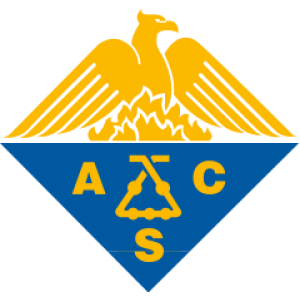


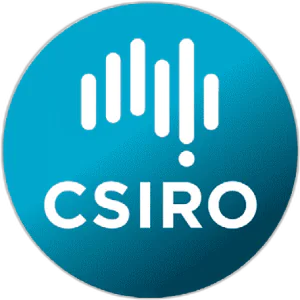

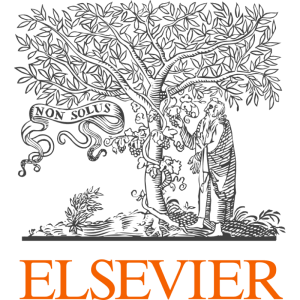











































![Recent trends in the chemistry of aminobenzo[b]thiophenes](/storage/images/resized/5YZtvLvkPZuc2JHOaZsjCvGSHFCuC3drUwN3YAc5_small_thumb.webp)
![Recent developments in synthetic methods for benzo[b]heteroles](/storage/images/resized/leiAYcRDGTSl5B1eCnwpSGqmDEUEfDPPoYisFGhT_small_thumb.webp)









![Recent Progress in the Synthesis of Benzo[b]thiophene](/storage/images/resized/doUaFUZdxUEQjLi1TwZjGHi8HXYNWWSk04dSC6Xh_small_thumb.webp)






















![Gold(I)-Catalyzed Formation of Benzo[b]furans from 3-Silyloxy-1,5-enynes](/storage/images/resized/bRyGpdm98BkAUYiK1YFNpl5Z7hPu6Gd87gbIeuG3_small_thumb.webp)
![Gold(I)-Catalyzed Rearrangement of 3-Silyloxy-1,5-enynes: An Efficient Synthesis of Benzo[b]thiophenes, Dibenzothiophenes, Dibenzofurans, and Indole Derivatives](/storage/images/resized/bRyGpdm98BkAUYiK1YFNpl5Z7hPu6Gd87gbIeuG3_small_thumb.webp)

![Iodine-Catalyzed Regioselective Synthesis of Diphenyl-Substituted Carbazoles via [4 + 2] Annulation of β-Formyl Ketones with Indoles](/storage/images/resized/iLiQsFqFaSEx6chlGQ5fbAwF6VYU3WWa08hkss0g_small_thumb.webp)






![Lewis Acid Catalyzed Cascade Reaction to Carbazoles and Naphthalenes via Dehydrative [3 + 3]-Annulation](/storage/images/resized/iLiQsFqFaSEx6chlGQ5fbAwF6VYU3WWa08hkss0g_small_thumb.webp)







![Gold-Catalyzed Cascade Reactions of Furan-ynes with External Nucleophiles Consisting of a 1,2-Rearrangement: Straightforward Synthesis of Multi-Substituted Benzo[b]furans](/storage/images/resized/bRyGpdm98BkAUYiK1YFNpl5Z7hPu6Gd87gbIeuG3_small_thumb.webp)
![Formal [4+2] Reaction between 1,3-Diynes and Pyrroles: Gold(I)-Catalyzed Indole Synthesis by Double Hydroarylation](/storage/images/resized/bRyGpdm98BkAUYiK1YFNpl5Z7hPu6Gd87gbIeuG3_small_thumb.webp)


![Palladium(II)-Catalyzed Intramolecular [2 + 2 + 2] Annulation of Indolyl 1,3-Diynes: Construction of Azepino-Fused Carbazoles](/storage/images/resized/iLiQsFqFaSEx6chlGQ5fbAwF6VYU3WWa08hkss0g_small_thumb.webp)
![Three-Component Cascade Synthesis of Carbazoles through [1s,6s] Sigmatropic Shift under Metal-Free Conditions](/storage/images/resized/iLiQsFqFaSEx6chlGQ5fbAwF6VYU3WWa08hkss0g_small_thumb.webp)




















![Synthesis of Benzo[c]thiophenes by Rhodium(III)-Catalyzed Dehydrogenative Annulation](/storage/images/resized/iLiQsFqFaSEx6chlGQ5fbAwF6VYU3WWa08hkss0g_small_thumb.webp)

![Cp*Co(III)-Catalyzed Regioselective Synthesis of Cyclopenta[b]carbazoles via Dual C(sp2)–H Functionalization of 1-(Pyridin-2-yl)-indoles with Diynes](/storage/images/resized/iLiQsFqFaSEx6chlGQ5fbAwF6VYU3WWa08hkss0g_small_thumb.webp)


![Formal [4 + 2] benzannulation of 2-alkenyl indoles with aldehydes: a route to structurally diverse carbazoles and bis-carbazoles](/storage/images/resized/leiAYcRDGTSl5B1eCnwpSGqmDEUEfDPPoYisFGhT_small_thumb.webp)
![One-pot access to tetrahydrobenzo[c]carbazoles from simple ketones by using O2 as an oxidant](/storage/images/resized/leiAYcRDGTSl5B1eCnwpSGqmDEUEfDPPoYisFGhT_small_thumb.webp)







![Lewis Acid-Catalyzed [4 + 2] Benzannulation between Enynal Units and Enols or Enol Ethers: Novel Synthetic Tools for Polysubstituted Aromatic Compounds Including Indole and Benzofuran Derivatives](/storage/images/resized/iLiQsFqFaSEx6chlGQ5fbAwF6VYU3WWa08hkss0g_small_thumb.webp)



![Copper-Catalyzed Three-Component Formal [3 + 1 + 2] Benzannulation for Carbazole and Indole Synthesis](/storage/images/resized/iLiQsFqFaSEx6chlGQ5fbAwF6VYU3WWa08hkss0g_small_thumb.webp)


![Efficient synthesis of polyfunctionalized carbazoles and pyrrolo[3,4-c]carbazoles via domino Diels–Alder reaction](/storage/images/resized/ex6KJoZujZOZFZh7jGfeHauiftuB3CI7iwJVFRDg_small_thumb.webp)





![Tandem [2 + 2] Cycloaddition/Rearrangement toward Carbazoles by Visible-Light Photocatalysis](/storage/images/resized/iLiQsFqFaSEx6chlGQ5fbAwF6VYU3WWa08hkss0g_small_thumb.webp)
![Lewis Acid-Catalyzed [3+3] Annulation of Donor–Acceptor Cyclopropanes and Indonyl Alcohols: One Step Synthesis of Substituted Carbazoles with Promising Photophysical Properties](/storage/images/resized/iLiQsFqFaSEx6chlGQ5fbAwF6VYU3WWa08hkss0g_small_thumb.webp)





![Modular Synthesis of Bicyclic and Tricyclic (Aza‐) Arenes from Nucleophilic (Aza‐)Arenes with Electrophilic Side Arms via [4+2] Annulation Reactions](/storage/images/resized/bRyGpdm98BkAUYiK1YFNpl5Z7hPu6Gd87gbIeuG3_small_thumb.webp)
![Novel [4 + 2]-Benzannulation To Access Substituted Benzenes and Polycyclic Aromatic and Benzene-Fused Heteroaromatic Compounds](/storage/images/resized/iLiQsFqFaSEx6chlGQ5fbAwF6VYU3WWa08hkss0g_small_thumb.webp)
![HNTf2-Catalyzed Formal [3 + 2] Cycloaddition of Vinyldiazoacetates to Indole-Substituted Diazo Compounds and Their Conversion to Carbazoles](/storage/images/resized/iLiQsFqFaSEx6chlGQ5fbAwF6VYU3WWa08hkss0g_small_thumb.webp)

![Rhodium Enalcarbenoids: Direct Synthesis of Indoles by Rhodium(II)-Catalyzed [4+2] Benzannulation of Pyrroles](/storage/images/resized/bRyGpdm98BkAUYiK1YFNpl5Z7hPu6Gd87gbIeuG3_small_thumb.webp)
![[4+2] Annulation of 3-(2,2-diethoxyethyl)-1,3-dicarbonyl compounds with indoles catalyzed by Brønsted acid ionic liquid for the synthesis of carbazoles](/storage/images/resized/GDnYOu1UpMMfMMRV6Aqle4H0YLLsraeD9IP9qScG_small_thumb.webp)

![Relay Catalysis of Bismuth Trichloride and Byproduct Hydrogen Bromide Enables the Synthesis of Carbazole and Benzo[α]carbazoles from Indoles and α-Bromoacetaldehyde Acetals](/storage/images/resized/bRyGpdm98BkAUYiK1YFNpl5Z7hPu6Gd87gbIeuG3_small_thumb.webp)



![Brønsted Acid Catalyzed One-Pot Benzannulation of 2-Alkenylindoles under Aerial Oxidation: A Route to Carbazoles and Indolo[2,3-a]carbazole Alkaloids](/storage/images/resized/iLiQsFqFaSEx6chlGQ5fbAwF6VYU3WWa08hkss0g_small_thumb.webp)




![Metal- and Solvent-Free Synthesis of Tetrahydrobenzo[c]carbazolones through NaI-Catalyzed Formal [4 + 2] Annulation](/storage/images/resized/iLiQsFqFaSEx6chlGQ5fbAwF6VYU3WWa08hkss0g_small_thumb.webp)


![Expedient Synthesis of Substituted Benzoheterocycles using 2-Butoxy-2,3-dihydrofurans as [4+2] Benzannulation Reagents](/storage/images/resized/bRyGpdm98BkAUYiK1YFNpl5Z7hPu6Gd87gbIeuG3_small_thumb.webp)
![One-Pot Sequential Propargylation/Cycloisomerization: A Facile [4+2]-Benzannulation Approach to Carbazoles](/storage/images/resized/bRyGpdm98BkAUYiK1YFNpl5Z7hPu6Gd87gbIeuG3_small_thumb.webp)
![[4 + 2] Benzannulation of 3-Alkenylpyrroles/Thiophenes with Propargylic Alcohols: Access to Substituted Indoles, Benzothiophenes, and Aza[5]helicenes](/storage/images/resized/iLiQsFqFaSEx6chlGQ5fbAwF6VYU3WWa08hkss0g_small_thumb.webp)














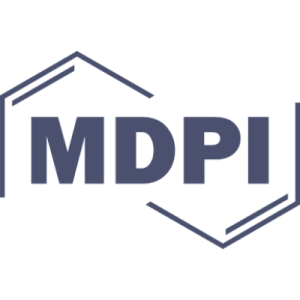
![Synthesis of benzo[a]carbazole derivatives from 3-ethylindoles by exploiting the dual character of benzoquinone as an oxidizing agent and dienophile](/storage/images/resized/leiAYcRDGTSl5B1eCnwpSGqmDEUEfDPPoYisFGhT_small_thumb.webp)











![Sequential Annulations to Interesting Novel Pyrrolo[3,2-c]carbazoles](/storage/images/resized/MjH1ITP7lMYGxeqUZfkt2BnVLgjkk413jwBV97XX_small_thumb.webp)








![Lewis Acid Mediated Aminobenzannulation Reactions of δ-Ketoalkynes: Synthesis of 1-Aminocarbazoles and 9-Aminopyrido[1,2-a]indoles](/storage/images/resized/bRyGpdm98BkAUYiK1YFNpl5Z7hPu6Gd87gbIeuG3_small_thumb.webp)





![[4 + 2] Annulation of 3-Nitroindoles with Alkylidene Malononitriles: Entry to Substituted Carbazol-4-amine Derivatives](/storage/images/resized/iLiQsFqFaSEx6chlGQ5fbAwF6VYU3WWa08hkss0g_small_thumb.webp)






![Anionic [4+2] cycloaddition strategy in the regiospecific synthesis of carbazoles: formal synthesis of ellipticine and murrayaquinone A](/storage/images/resized/GDnYOu1UpMMfMMRV6Aqle4H0YLLsraeD9IP9qScG_small_thumb.webp)












![[3+3] Cyclizations of 1,3-bis(trimethylsilyloxy)-1,3-butadienes—a new approach to diverse CF3-substituted fluorenes, dibenzofurans, 9,10-dihydrophenanthrenes and 6H-benzo[c]chromenes](/storage/images/resized/GDnYOu1UpMMfMMRV6Aqle4H0YLLsraeD9IP9qScG_small_thumb.webp)



![Rh(III)-Catalyzed [5 + 1] Annulation of Indole-enaminones with Diazo Compounds To Form Highly Functionalized Carbazoles](/storage/images/resized/iLiQsFqFaSEx6chlGQ5fbAwF6VYU3WWa08hkss0g_small_thumb.webp)
![NHC-Catalyzed Formal [4 + 2] Annulation of o-Formyl-Tethered Michael Acceptors and Ynones to Access Highly Functionalized Naphthalene Derivatives](/storage/images/resized/iLiQsFqFaSEx6chlGQ5fbAwF6VYU3WWa08hkss0g_small_thumb.webp)















![Microwave-assisted reactions of nitroheterocycles with dienes. Diels–Alder and tandem hetero Diels–Alder/[3,3] sigmatropic shift](/storage/images/resized/GDnYOu1UpMMfMMRV6Aqle4H0YLLsraeD9IP9qScG_small_thumb.webp)










![A Facile Synthesis of Blue Luminescent [7]Helicenocarbazoles Based on Gold-Catalyzed Rearrangement-Iodonium Migration and Suzuki-Miyaura Benzannulation Reactions](/storage/images/resized/bRyGpdm98BkAUYiK1YFNpl5Z7hPu6Gd87gbIeuG3_small_thumb.webp)






![α-Oxoketene Dithioacetals Mediated Benzoannelation of Aromatic Heterocycles: an Efficient Regiocontrolled Synthesis of Highly Substituted and Polycyclic Benzo[b]thiophenes](/storage/images/resized/GDnYOu1UpMMfMMRV6Aqle4H0YLLsraeD9IP9qScG_small_thumb.webp)






![General approach to benzo[b]thiophenes, benzo[b]furans, and dibenzofurans via gold-catalyzed cyclization of 1-heteroarylalka-2,3-dienyl acetates](/storage/images/resized/GDnYOu1UpMMfMMRV6Aqle4H0YLLsraeD9IP9qScG_small_thumb.webp)
![Studies on [PtCl2]- or [AuCl]-Catalyzed Cyclization of 1-(Indol-2-yl)-2,3-Allenols: The Effects of Water/Steric Hindrance and 1,2-Migration Selectivity](/storage/images/resized/bRyGpdm98BkAUYiK1YFNpl5Z7hPu6Gd87gbIeuG3_small_thumb.webp)






